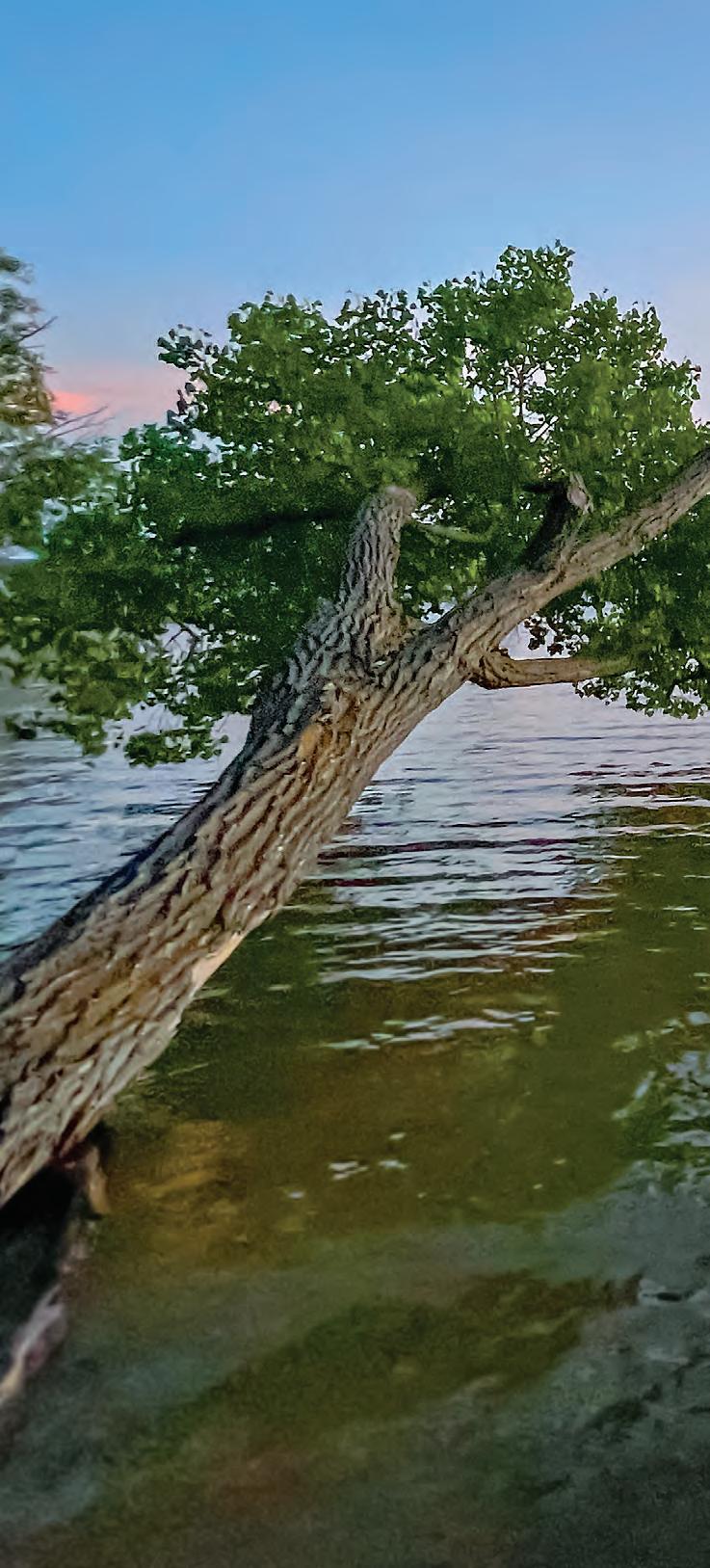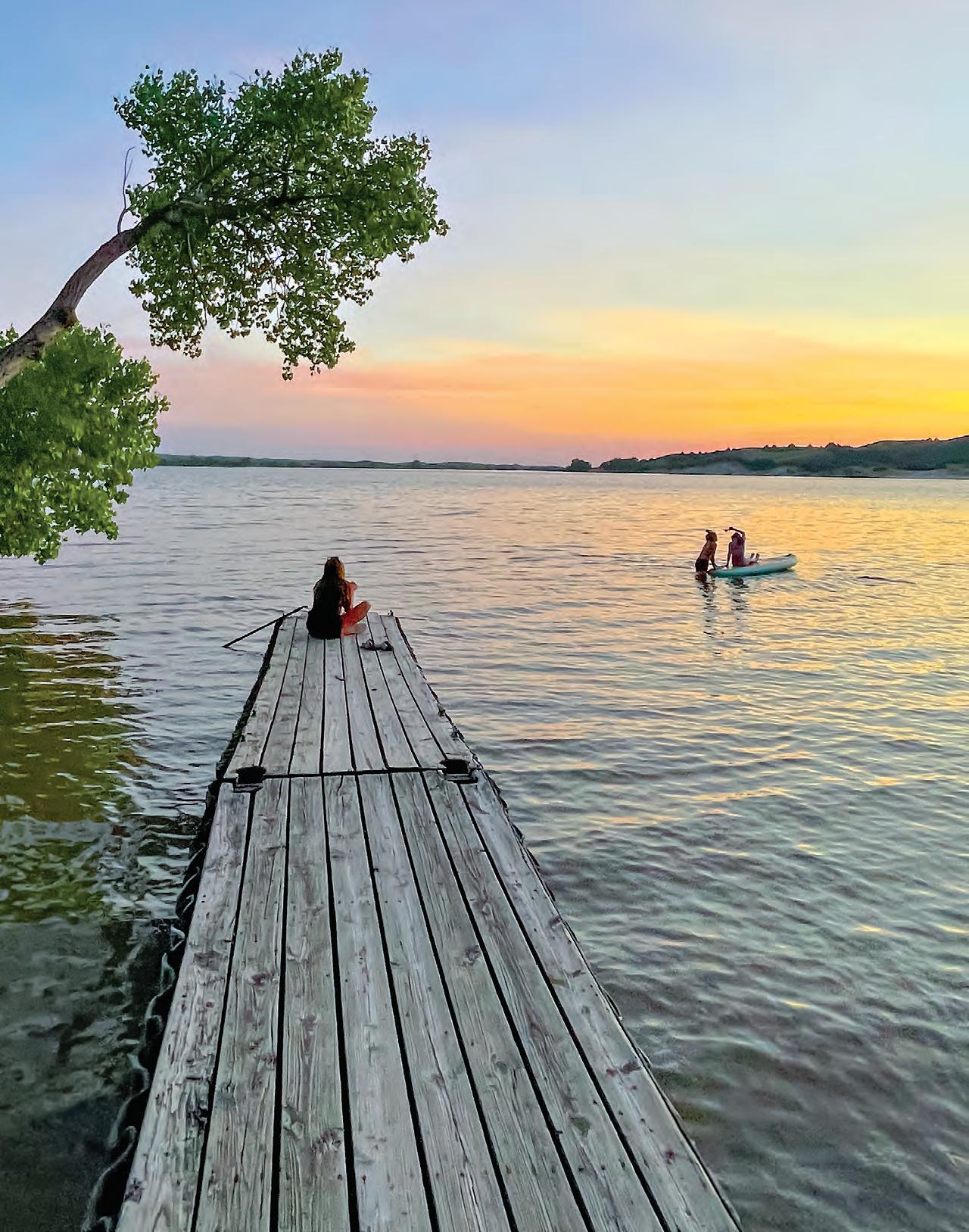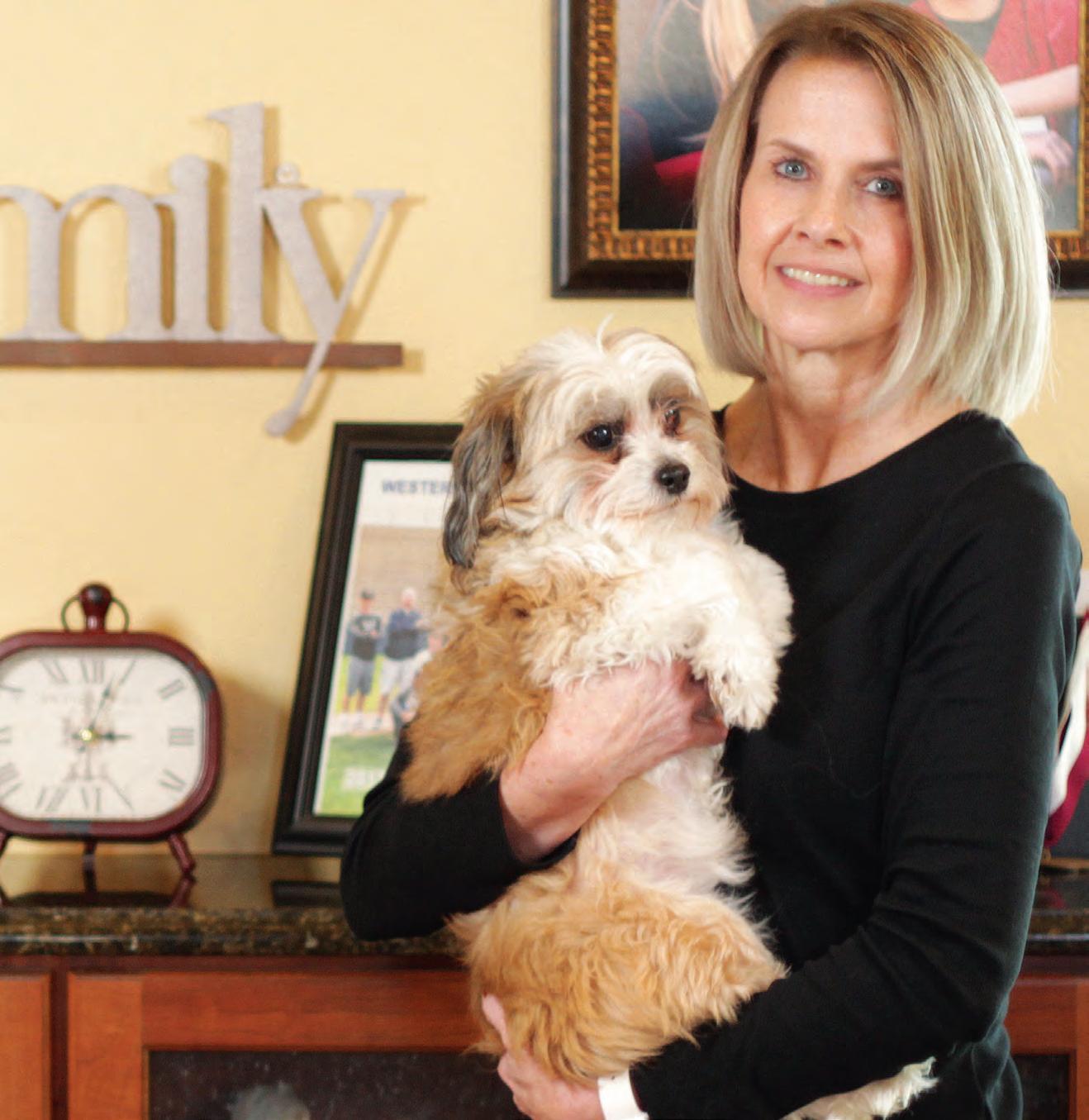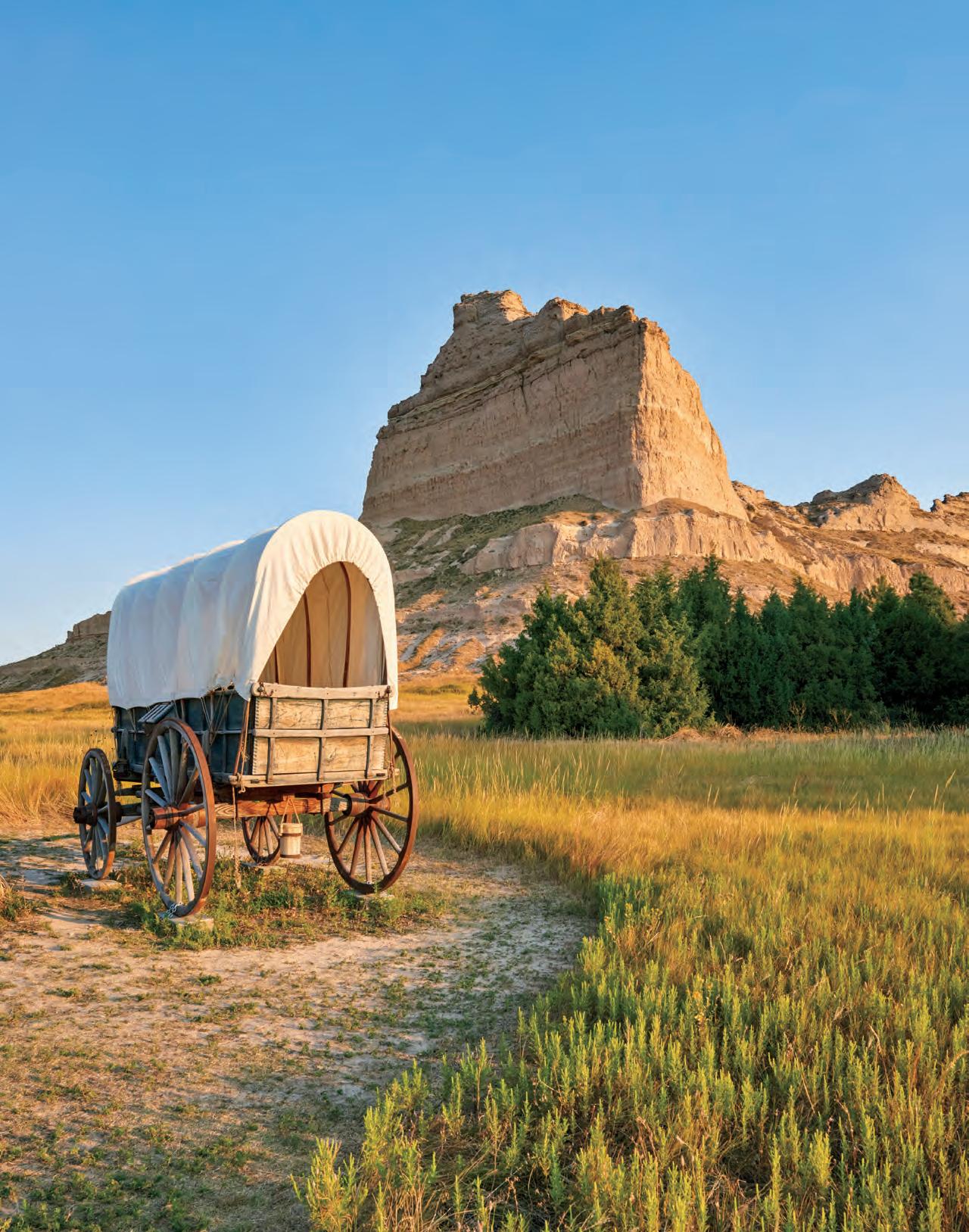












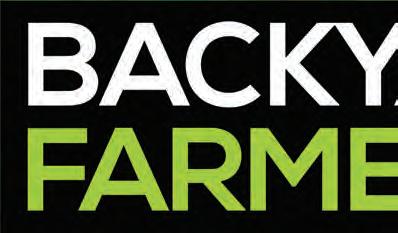



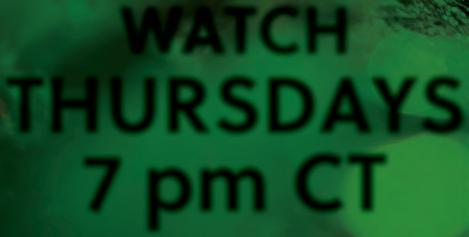







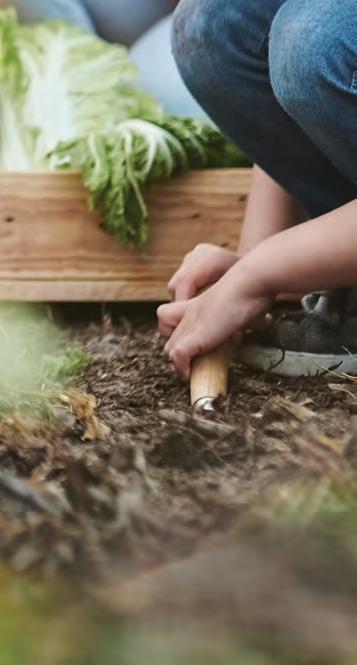


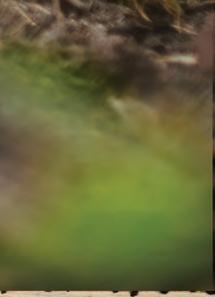

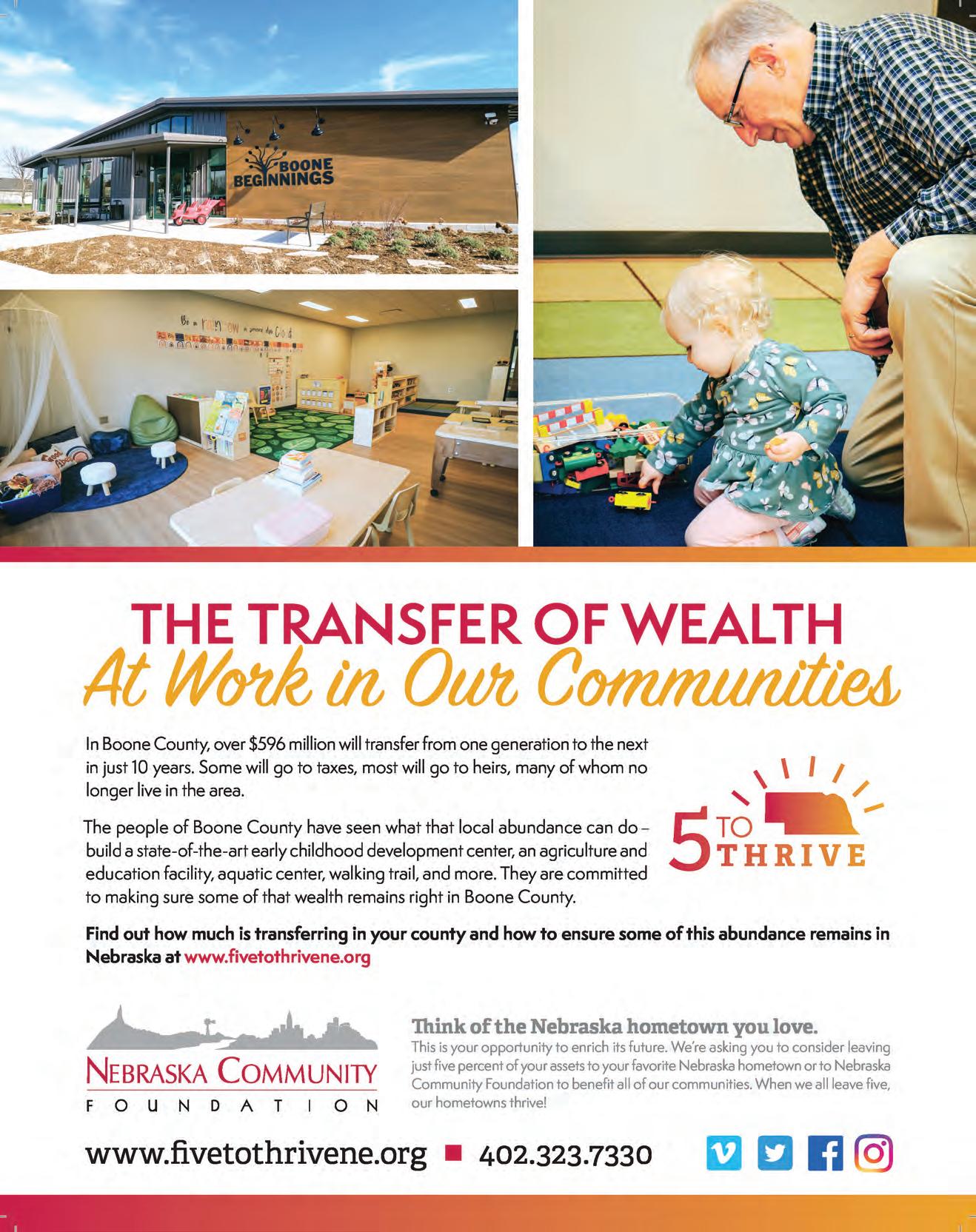
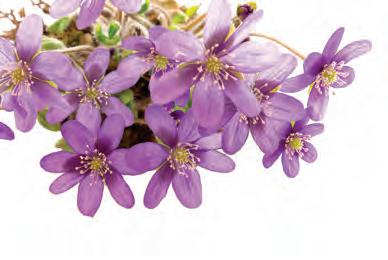

































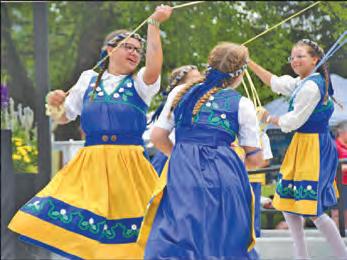






This year marks the 70th year since the Stromsburg Swedish Midsommar Festival was started. Stromsburg is also celebrating its 150th year of the town being founded.
The Swedish heritage of those founders is shared with fun for all ages during THE THIRD WEEKEND IN JUNE as we welcome guests to enjoy the food, crafts, parade, car show, 3-on-3 basketball, horseshoes, fun run, smorgasbord, quilt show and entertainment.
All entertainment during the festival is free. Most will be held in the city square around the recently renovated 100-year old bandstand and new stage. Plan to bring your lawn chairs and enjoy. A carnival and midway will be available Friday and Saturday.






Hometown Market is well-stocked and ready for you all year round. Stop by the meat department where Mike Branting, meat cutter for 39 years, has some longtime Swedish recipes you’ll want to try.



SCHEDULE OF EVENTS
Friday, June 17
4:30-7 p.m. Chicken BBQ
5-10 p.m. Taste of Sweden, food
5:30-6:30 p.m. Kid’s Entertainment “String Beans”
6:45 p.m. Swedish Dancers
7:30 p.m. Crowning of the King and Queen Cake for All - Celebrate 150 Years
8:30 p.m. Musician Paul Seibert
Saturday, June 18
7 a.m. Swedish Pancakes
8 a.m. 5K-10K-1M, Earl “Helge” Byleen Run/Walk
8 a.m.-9 p.m. Taste of Sweden, food
9 a.m.-5 p.m. Midsommar Market Arts & Crafts
11 a.m.-1 p.m. SMORGASBORD
11:15 a.m. State Sanctioned Children’s Tractor Pull
12-4 p.m. Edgerton Explorit Center from Aurora
2-3 p.m. Library: “Vikings on Camels” by Dr. Kathryn Hain
4:30 p.m. Swedish Dancers, local children
4-7:30 p.m. Firemen serving BBQ & Brats
6 p.m. Parade “150 Years: Swedish Then & Swedish Now”
7:30 p.m. Musicians “Greenblatt & Seay”
Sunday, June 19
11 a.m.-4 p.m. Car, Motorcycle and Tractor Show
11 a.m.-? Pulled Pork by Sons of the American Legion
11 a.m.-6 p.m. Anna Street Trolley, ice cream treats
5 p.m. “Half Music, Half Wit” with PruDense (Marla T.)





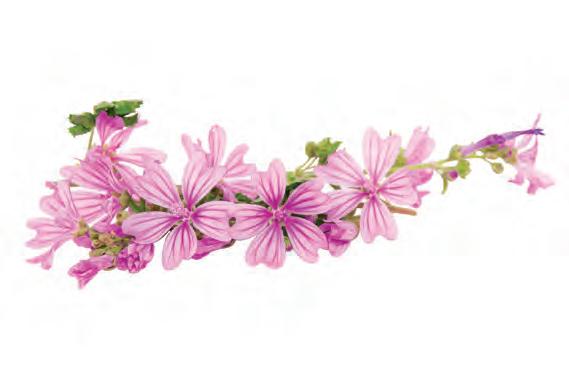
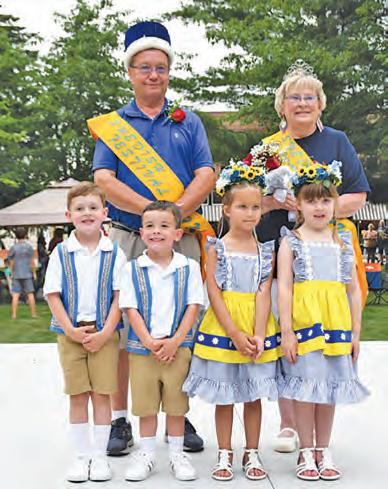
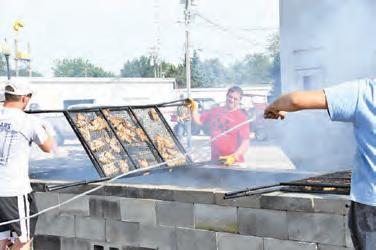




Trail, pg. 62
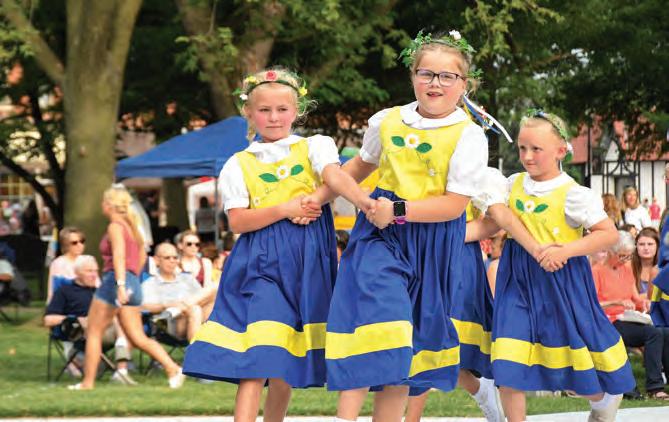
24 Nebraska Rocks
Geological formations that defy physics, abundant blooms, fearsome ancient mammals, desperate pioneers and Indigenous peoples – the history of Western Nebraska is as dramatic as its landscape.
Story by Megan Feeney
32
A relative of Mari Sandoz, self-taught Sandhills artist Rachel Brownlee’s charcoal pencil drawings painstakingly depict the “living West” – and she says it’s not just her hands guiding the creation.
Story by Joe Arterburn Photographs by Audrey Powles
38 Big Mama’s Kitchen
Patricia “Big Mama” Barron served soul food and second chances at her North Omaha restaurant. Her family dishes up more of the same at a new North 30th Street location.
Story by Megan Feeney Photographs by Lend Frison
54 2 Swedish Capitals
Meatballs and lutefisk fly as Stromsburg and Oakland vie for the distinction of being Nebraska’s Swedish capital. Could it be there’s room for two?
Story by Tim Trudell
62 Cowboy Trail
From Norfolk to Valentine, Becky McCarville takes on goathead thorns and extreme heat to conquer the 195-mile rails-to-trail bikepacking journey with her sister. Their Nebraska adventures are just beginning.
Story by Becky McCarville
72 Nebraska Golf Courses
From ranging bison to aeronautical history, these unique and distinctly Nebraska golf courses across the state are worth the drive. Whether players are wearing golf pants or cowboy hats, they’re all chasing the hole-in-one fun of the golf life.
Story by Tom Hess
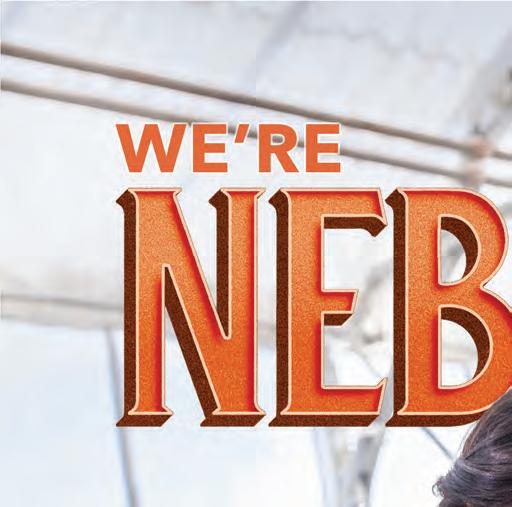

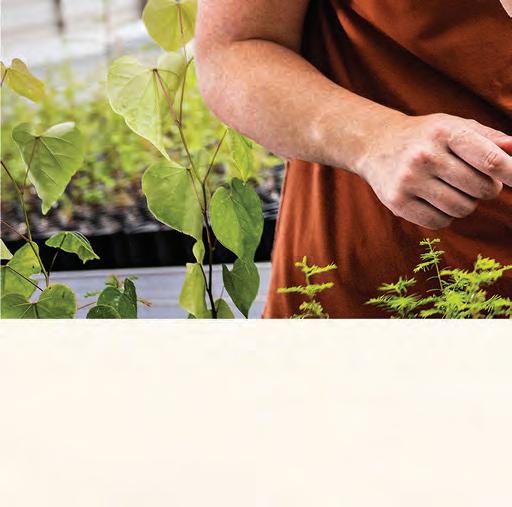
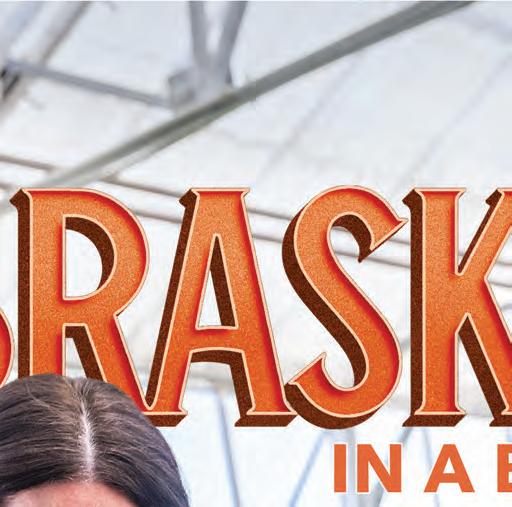
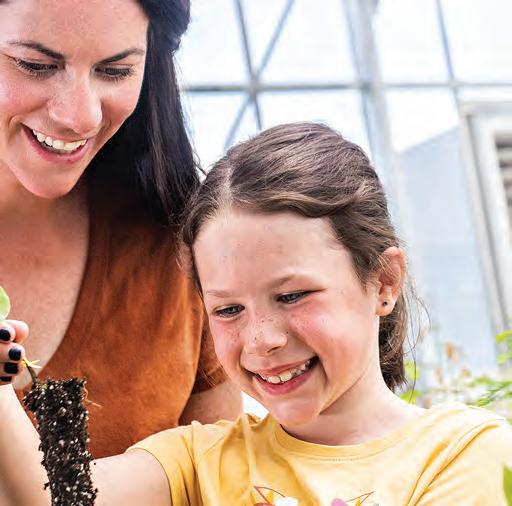
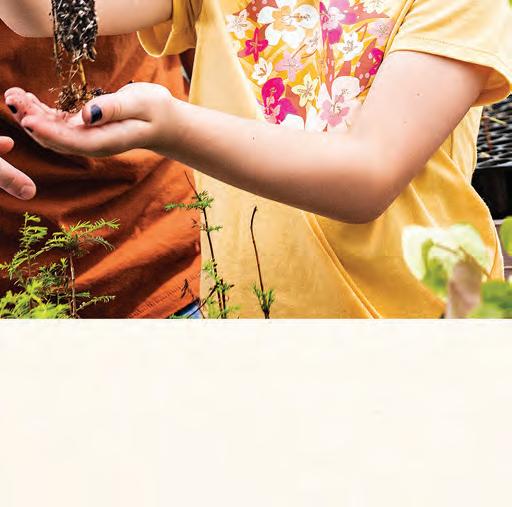



Sugar Loaf Butte pg. 24
Toadstool park pg. 24
Pine Ridge Rec. Area pg. 24
Scottsbluff pg. 24
Gering pg. 72
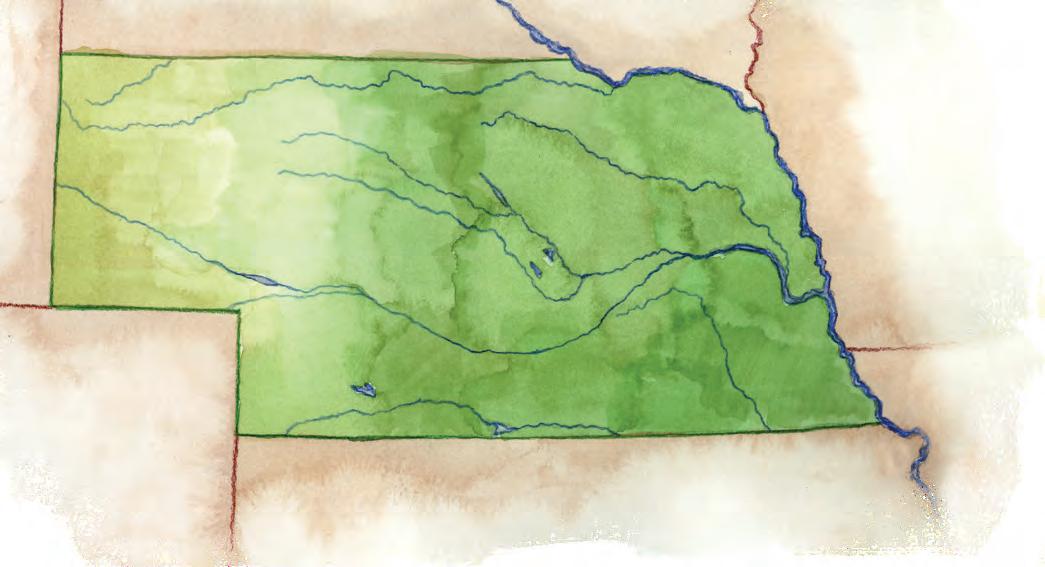
Valentine pg. 62
Wood Lake pg. 62
Johnstown pg. 62
Ashby pg. 32
Hyannis pg.72
Chimney Rock pg. 24
Wildcat Hills pg. 24
Kimball pg. 72
Niobrara pg. 72
Bassett pg. 62
O’Neill pg. 62
Neligh pg. 62
Meadow Grove pg. 62
Gracie Creek pg. 100
Norfolk pg. 62
Clarkson pg. 90 Courthouse & Jail rock pg. 24
Dannebrog pg. 72
Sutherland pg. 72
Gothenburg pg. 72
McCook pg. 90
11 Editor’s Letter Observations on the ‘Good Life’ by editor Megan Feeney.
13 Mailbox
Letters, emails, posts and notes from our readers.
16 Flat Water News & Trivia
Ponca members reclaim their lost language with online classes, kayakers experience wildlife up close (and sometimes personal) on the Elkhorn River, windmill collection generates electric response outside Jackson, we hazard an explanation of one town’s name, and a novelist explores how Nebraska is the cure for loneliness. Plus: what the sandhill are the answers to these trivia questions?
46 Kitchens
These easy-to-assemble no-bake desserts add a heartwarming touch to the end of any meal while keeping the kitchen cool.
50 Poetry
Nebraskans gather again with picnics, memorial walks and parties to celebrate.
90 Traveler
Lincoln gets into the swing with Jazz in June, McCook celebrates its 25th Buffalo Commons Storytelling Festival, and Clarkson and North Omaha streets fill with food, music and familyfriendly activities for their annual heritage celebrations.
100 Naturally Nebraska
Alan J. Bartels considers the story of a blind pioneer girl as he tends to a Nebraska highway.
102 Last Look
At first, the teens weren’t impressed with their low-key vacation spot, but Nebraska’s beauty conquers all – even Gen Z cynics.
Jackson pg. 16
Oakland pg. 54
Omaha pg. 38
Stromsburg pg. 54
Lincoln pg. 90
Auburn pg. 72
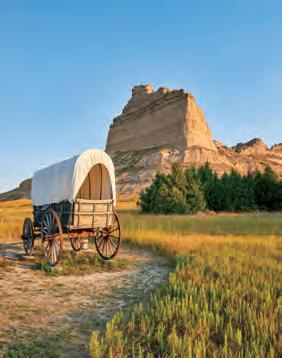
Bluff National Monument Visitor Center. The bluff was a landmark for many people in history, including Native Americans and emigrants heading west.




Can’t shake your sinus discomfort? Are you suffering from a stuffy nose, swelling around your eyes, facial pain or headaches?
If your symptoms recur or last for more than eight weeks despite medical treatment, you have chronic sinusitis. Fortunately, the experts at Columbus Otolaryngology Clinic can offer a breath of fresh air to those suffering from chronic sinusitis, including the following procedures:
• Balloon sinuplasty.
• Functional endoscopic sinus surgery.
• Image-guided surgery.
Find relief here
Columbus Otolaryngology Clinic can evaluate your condition and help you find the best treatment. Call 402-562-4720 or visit columbushosp.org for more information.
MAY/JUNE 2022
Volume 26, Number 3
Publisher & Executive Editor
Chris Amundson
Associate Publisher Angela Amundson
Editor Megan Feeney
Photo Editor Joshua Hardin
Design
Open Look Creative Team, Valerie Mosley
Advertising Marilyn Koponen
Subscriptions
Meagan Peil, Lindsey Schaecher, Janice Sudbeck, Teresa Eichenbrenner
Nebraska Life Magazine c/o Subscriptions Dept. • PO Box 430 Timnath, CO 80547 1-800-777-6159 NebraskaLife.com
SUBSCRIBE
Subscriptions are 1-yr (6 issues) for $25 or 2-yrs (12 issues) for $44. Please call, visit NebraskaLife.com or return a subscription card from this issue. For fundraising and corporate rates, call or email subscriptions@ nebraskalife.com.
ADVERTISE
Advertising deadlines are three months prior to publication dates. For rates and position availability, please call or email advertising@nebraskalife.com.
CONTRIBUTE
Send us your letters, stories, photos and story tips by writing to us, visiting NebraskaLife.com/contribute or emailing editor@nebraskalife.com.
COPYRIGHT
All text, photography and artwork are copyright 2022 by Flagship Publishing Inc. For reprint permission, please call or email publisher@nebraskalife.com.

IWENT TO OMAHA North High School in North Omaha (Go Vikings!), but Big Mama’s Kitchen and Catering wasn’t around yet. I only recently had the chance to taste their pillowy soft macaroni and cheese and melt-in-yourmouth fried fish.
Patricia Barron, or “Big Mama,” as she was more commonly known, opened her first restaurant post-retirement in 2007 to serve homestyle comfort food and provide a gathering place for her North Omaha community. Not only was Big Mama a gifted cook, but she also had a knack for making people feel seen and believe that they mattered – no matter what their skin color, creed or history.

I never had the pleasure of meeting Big Mama, who passed away a few years ago, but her family welcomed me into the kitchen at the restaurant’s new location on North 30th Street to report on their story. It was a frenetic Friday dinner rush, but the family and staff pulled it off together with aplomb, each working at the task at which she or he most excelled, while cracking jokes and having fun.
In my brief tenure as editor of Nebraska Life, I’ve met many talented Nebraskans. But what impresses me most is how the people of our state often use their gifts to uplift others. Whether it’s cooking delicious food, listening deeply, organizing the many events featured in our Traveler section each month, or making art, Nebraskans across the state use their talents to serve others.
Our Western correspondent Joe Arterburn illustrates this well in his beautiful profile of Rachel Brownlee, an artist living on a working ranch in the Sandhills. Using charcoal pencil, the self-taught Rachel, who is also a relative of the writer Mari Sandoz, captures the essence of the living West with pictures modeled on real people. Rachel expresses the beauty of the ranching life, but she doesn’t shirk from also depicting its grittiness, sacrifice and suffering. Like Big Mama, Rachel’s keen attention to other people makes them feel seen. Her subjects often weep at the first sight of their portraits.
At Nebraska Life, we share this aim of using our talents to be of service to others. As our publisher Chris Amundson reminds us at every Monday morning weekly staff meeting, our magazine aspires to bring beauty, inspiration, encouragement and connection to our readers with the stories and photography we present.
There is so much pain and division in our world. No one person can solve so many crises on her or his own. But what would happen if everyone used their gifts in service of others, like Nebraskans Big Mama and Rachel have?
I don’t have the answer to that, but I’m energized by our magazine’s mandate to find and elevate the good. From the entire staff, may these pages bring you comfort, hope and peace.
Megan Feeney Editor editor@nebraskalife.com





Savor the farm-fresh produce and baked treats at Union Orchard. Bring the kids for pick-your-own fruit and pumpkins, plus monthly events held in our large pavilion. Sample a wide variety of Nebraska wines, hard ciders, and seasonal cocktails in our tasting room.
Music Under The Stars
June 11th, July 16th and August 13th • 7pm in the pavilion
New Moon Campfire
June 25th, July 30th and August 27th • 7pm in the pavilion
Applejack Festival
September 17th and 18th
The Taste of Applejack
September 24th and 25th
Check the events section of our Facebook page for information on bands and speakers

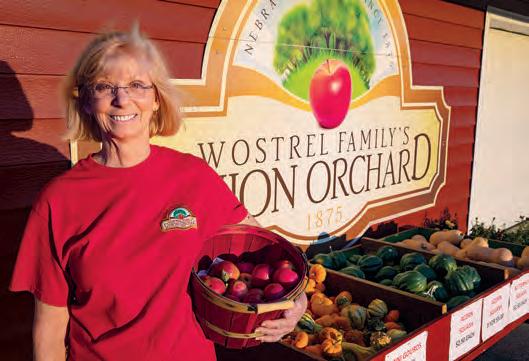

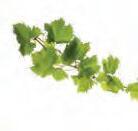
NEBRASKA CITY’S HISTORIC AND ONLY FAMILY-OWNED ORCHARD

Check our Facebook page for
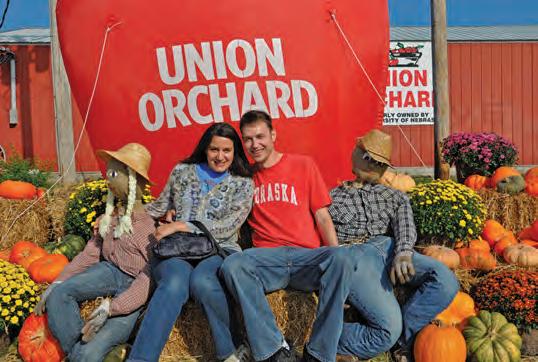
Transcendent rural theater
I lived in Cass County for 12 years and was a frequent patron of the Lofte Theatre (“Lofte Love,” March/April 2022) starting when it was in the hog barn. My husband and I had a B&B on Church Road, and we contributed to the new building. I love the picture you took of Jean Colbert – you caught her warm personality.
I always said if they ever did Sound of Music, I would audition for a part as one of the nuns. They did, and I did, and it was almost a spiritual experience, thanks to the gal who was the Mother Superior.
Pat Meierhenry Lincoln
Crane secrets
Your article by Alan Bartels on sandhill cranes (“For the Love of Cranes,” March/ April 2022) made me recall the time I visited the Rowe Sanctuary to witness their migration. The sanctuary has a display room to inform visitors about these amazing birds.
A docent stood by to answer questions. I approached, “If these birds could talk, what question would you ask?”
She replied, “I’d ask if what I’ve been telling people all these years is true.”
William Buffett Arlington, Massachusetts
Some pig!
The pork recipes in the March/April 2022 issue (“Swine Dining”) were very timely for me. We have another half hog coming this month, and I still had a roast, big ham steak and package of sausage left. I made the Ham Balls and the Shredded Savory Pork. They were both excellent. Thanks for the recipes.
Jan Graham Imperial
Grandchildren can wait
Your March/April 2022 issue featuring the photography of Roy Swoboda (“Magical Wild Nebraska”) caught my eye.
His awesome photos of the beauty and majesty of nature are breathtaking. I had to sit down, put my feet up, and drink it all in.
Thank you for the accompanying narrative article that also drew me in, too. Ne-

braska Life is a beautiful, coffee table-quality magazine. I know I’ll enjoy reading the other features, but now I have to figure out when I’ll get my sewing, quilting, and spoiling of grandchildren done.
Jolly Michel Stitzer, Wisconsin
Photography speaks
Thank you for the article featuring my photography (“Magical Wild Nebraska,” March/April 2022). I get the opportunity to work in many nursing homes. I have seen what a photo in your magazine can do to brighten someone’s world.
On every trip to visit my mother at the nursing home, I always share my photography with numerous photos on my iPad. Mom always oohs and aahs, wondering if I have sold or had some of them published. Yesterday she got a treat and meticulously studied every word and photo. For that, I thank you. It was a great day for both of us.
Roy Swoboda Meadow Grove
Loch Ness Husker
The most recent edition has been an excellent read and I am pleased that you have ensured a level of continuity by publishing Alan Bartel’s “Naturally Nebraska” pieces. I was lucky enough to live in Nebraska in the early 1990s and it has a special place in my heart for reasons too many to mention!
Colin Rutherford Glasgow, Scotland

Closer to the ‘Hart’
Nebraska Life often reawakens memories of my heart, like your “Hartington Heartsong” story (January/February 2022).
My grandparents were lifelong residents of Hartington, and I spent a lot of time there when I was younger. I remember going to Globe Clothing, where my grandma shopped. We would go back for Memorial Day activities. The only place to stay was Hotel Hartington, which had seen better days in the early 1980s. We called it the Hartington Hilton, or “HH” for short.
It was heartwarming to see the renovations that have occurred at the hotel and various other buildings. It sounds like Hartington is still the charming town that I knew as a young girl. Kudos to the Schroeders and everyone who is contributing to this effort!
Paula Thorndill Conklin, Michigan
My wife and I want to thank you for the wonderful story on the Hartington veterinarians. It was very well written and so informative. We also enjoyed looking at the pictures that accompanied the story.
I believe all Nebraskans would agree with me that both Erin and Ben Schroeder exemplify why we have the slogan, “The Good Life.” They certainly have helped make it so!
Myron Hitz Plainview
I thoroughly enjoyed your excellent article about the couple that are veterinarians. We and another couple visited the Cedar County Veterinarian Clinic and met Ben and Erin last summer after having watched their reality show. They are as down-to-earth in real life as the TV show depicts. We stayed in their renovated historic Hartington Hotel and had a lovely visit for an overnight trip from Omaha.
Thanks, Megan, for a well-written article featuring Nebraska people, businesses, and community.
Patricia Coshow Omaha
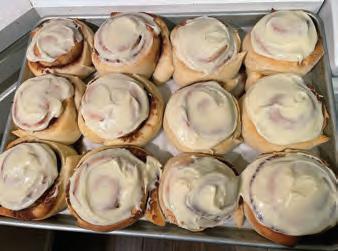
After reading the recipe for the “Best-Ever Cinnamon Rolls” (January/February 2022), I had to give it a shot. What fun it was. Not only does my family agree with the “Best Ever” designation, but I’ll add, “Easiest Ever” to the mix. It is an outstanding visit from home, every time Nebraska Life arrives in our mailbox.
Kathi Uhlinger Moses Lake, WA
Editor’s note: Kathi, your rolls look scrumptious. Bravo! We’re so glad you enjoyed the recipe.
Building fun
Welcome to the magazine, Editor Feeney! I was impressed with your first issue as editor (January/February 2022).
The “Architectural Curiosities” piece brought back fun memories of my boyhood days at Lake Minatare’s WPA lighthouse in Western Nebraska. To borrow a phrase from Mark Twain, “You are a good hand with a pen!”
Cliff Reisig Tularosa, New Mexico
I have been so proud that J. Sterling Morton founded Arbor Day (“The Irascible Arborist,” March/April 2022). I taught country school in rural Otoe County, so a field trip to J. Sterling Morton’s Lodge was always a wonderful day.
Whenever possible we recommend friends visit the grounds and stay in the lodge. The food is wonderful, and the engraved readings that border the dining room provide a calming presence. Planting trees has always been important. Now it’s essential for our planet’s survival.
Joyce Rosenquist Ambler, Pennsylvania
We love Nebraska Life and look forward to each issue. Being from Omaha it helps bring awareness to many gems across the state. We appreciate all the photography and diversity of articles. It gives our family ideas of where to visit. Nebraska truly is a beautiful place, and your magazine connects us to other communities.
Kristen Peterson Omaha
My friend (who grew up near Omaha) and I (grew up in Garland) were having lunch at our retirement home in Baltimore when several young men brought their grandfather and sat down next to us. When they mentioned Scott Frost we introduced ourselves as Huskers and met James Levendusky, who is now also living here. He played football at Nebraska in the 1950s. I will share my Nebraska Life with him.
Rev. Al Buls Timonium, Maryland
I don’t live in Nebraska anymore, but my heart will always be there. When I receive the Nebraska Life magazine, I am reminded of many childhood memories. I spent many holidays and weekends in the Holdrege and Johnson Lake areas. In the 1940s, my grandparents bought a cabin at Johnson Lake. Today it is still our family’s cabin.
After graduating high school, it was my privilege to be a tour guide at the State Capitol in Lincoln. Your magazine is wonderful. I always look forward to receiving it.
Shanna Chapman Columbia City, Indiana
I grew up in Northeast Nebraska. Nebraska will always be my home. Several years ago, my mom and dad gave me a subscription to your magazine. I love when I receive it in the mail. It takes me back home.
Shane Wickett Belton, Missouri
The article Sheryl Schmeckpeper wrote on Russel Finch and the greenhouse (“Citrus in the Snow,” November/December 2021) was wonderful. I can’t say enough about how Russ’s ideas and humility are shaping the landscape of sustainable agriculture.
His business that was formed with the Antioch Machine Shop was one of the best things that could happen to him and people with a like-minded goal. Alan Bright was the perfect partner for Russ, and they are marching on helping more and more people to realize a small business or just augment their own family’s food supply.
Russ deserves that recognition.
Dixie Nelson Alliance
Please send us your letters and emails by June 1, 2022, for possible publication in the July/August 2022 issue. One lucky winner selected at random will receive a free 1-year subscription renewal. This issue’s winner is Kristen Peterson of Omaha. Email editor@nebraskalife.com or write by mail to the address at the front of this magazine. Thanks for reading and subscribing!
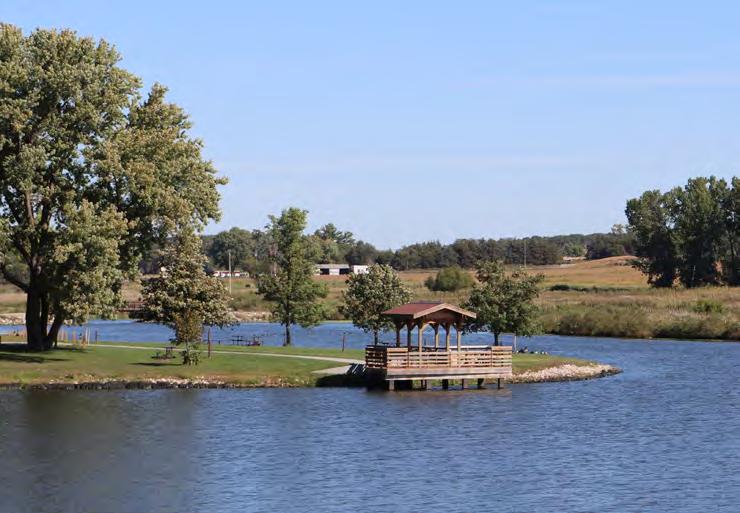
As designated by the Nebraska Legislature, the Lower Loup NRD’s purposes and authority include erosion and flood control, development of recreational facilities and fish and wildlife habitat, and soil and water conservation.
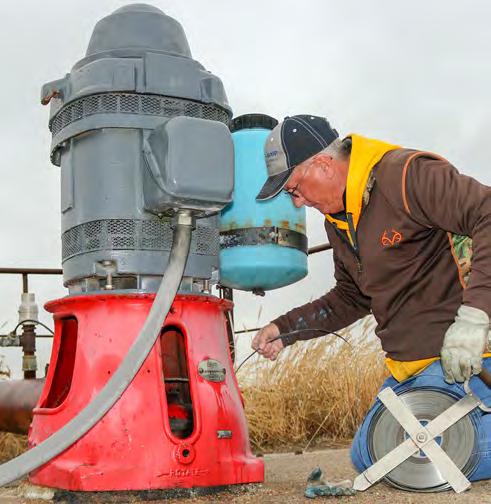




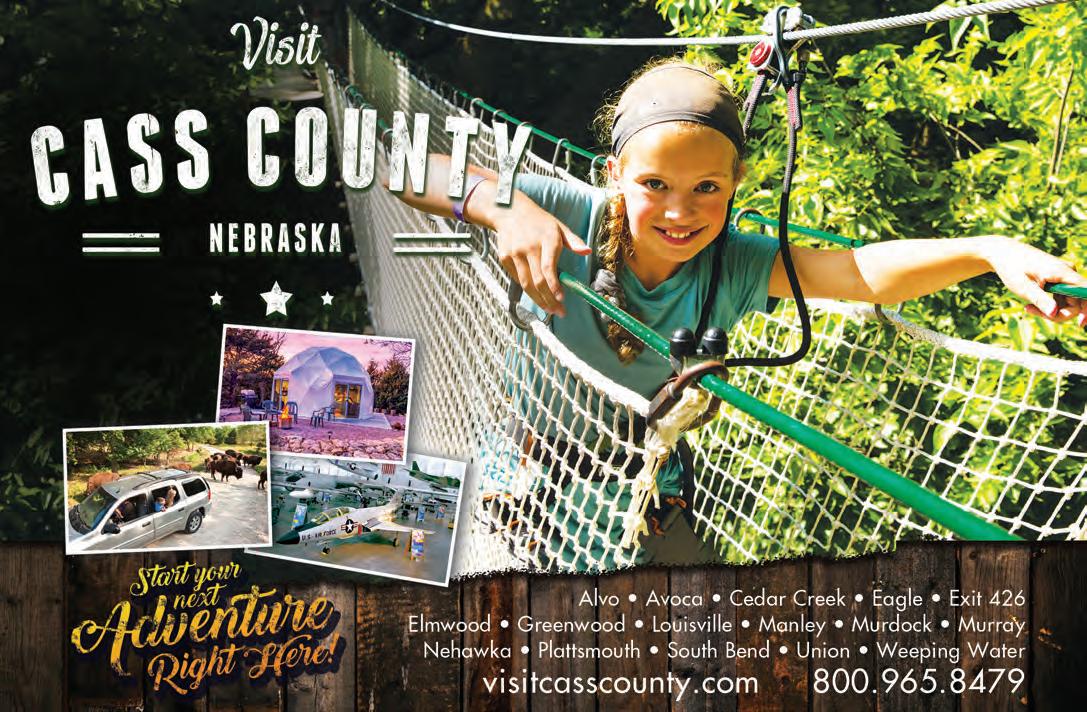

The origin of Hazard’s name is like the content teenagers post on the internet. Who knows whether it’s true or where it came from, but it sure is entertaining.
BY LISA TRUESDALE
The name of a village called Hazard in Sherman County seems torn from the pages of a rural noir. How did Hazard get its name? There are several stories.
One goes like this: When the town was established in 1886, about 30 miles due north of Kearney, some of the 70 residents gathered to choose a name for it. After much back and forth, one man declared that they just go ahead and “hazard a name.” Another attendee, perhaps irritated that the name-selection process was taking too long, shouted, “Fine, let’s just name it Hazard.”
Then there’s the legend about how the name honors a railroad worker named Mr. Hazzard, who supposedly dug the initial hole when the tracks first reached the area. Sounds believable, except for the
part where there’s no explanation at all about what happened to the second z.
Other stories rely on the more common definition of “hazard” as a noun – that of a risk or a danger. There’s the tale about a deep hole in the middle of town that was rumored to be from a meteorite. That hole was “a real hazard.” Another story describes a swampy area next to the railroad tracks where folks wrote “Hazard” on logs to warn the trainmen rumbling past.
That last story about the town’s naming origin seems to be the most widely accepted, so it’s going on a new interpretive sign at the Sherman County Historical Society in Loup City, according to the society’s president, Donna Trompke.
Hazard made the Billboard music charts in the 1990s thanks to pop singer–songwriter Richard Marx. The Los Angeles–based musician was writing the
lyrics for a song about a murder by a river in a small town. His favorite phrase in the song was “this old Nebraska town.” Though he was nearly finished with the song, he hadn’t yet settled on the town name. He had “duh-duh” scribbled on his notes where the two-syllable word would eventually go.
So, Marx called the Nebraska Chamber of Commerce and asked for a list of Nebraska town names, which they promptly faxed to him. He reportedly tossed the 17 pages into the air, grabbed one at random as it floated to the floor, and pointed. Hazard, with the right number of syllables, was the winner. The song went on to be a big hit around the world.
The tiny town of Hazard, which still has fewer than 100 residents, became a big hit, too. Nearly 30 years later, many true-crime fans remain convinced that Marx based his song on a true story. They still post online with their theories of who killed Mary down by the river in Hazard.
Never mind that there is no river in Hazard.
“There’s just a tiny little creek, so I find it highly unlikely that the story is true,” Trompke said. “It sure makes for a catchy song, though!”


Semi-fluent Ponca speaker Eagle Rhodd teaches online from home in Oklahoma to Ponca people in Nebraska. Few fluent speakers remain after government-run assimilation efforts.
BY MEGAN FEENEY
A crisis hit Nebraska’s Ponca Tribe a year before a global pandemic was even on the radar.
Less than five elders in the Northern Ponca population could speak Ponca language fluently, according to a survey conducted in Nebraska in 2019. Only 10 percent of respondents could speak 100 words. The vast majority of those surveyed knew fewer than 50 words.
None of the fluently speaking Northern Ponca elders made it through the COVID years alive. With their deaths went the language in Nebraska.
Fortunately, Southern Ponca in Oklahoma still had speakers. Nebraska Ponca received a grant funded through the Administration for Native Americans to start an online class. During that first lesson, instructor Eagle Rhodd, based in Oklahoma, encouraged participants not to despair.
“We are Ponca,” he said. “Your speakers are not gone.”
The divide between Northern and Southern Ponca is meaningless, Eagle Rhodd said. To start to understand the language, it is important to abandon the “colonial mentality,” that divides this one tribe. They had only been separated because of federal government action. They are one people.
For Richard Wright, Jr., director of Cultural Affairs for the Ponca Tribe of Nebraska, language is identity. “Our language defines us and our culture. Many words that pertain to religious things or ceremonies have no English words,” Wright said.
Other words lose their meaning or luster when translated. For example, Standing Bear’s interpreter Bright Eyes “should actually be more like Blazing Eyes,” Wright said. “The word in Ponca is much stronger.”
At a recent class, Ponca from across Nebraska and the U.S. attended. The goal is for youth in Niobrara, Norfolk, Sioux City, Omaha and Lincoln to learn and then become apprentices. Everyone is welcome to the free online classes. Foster parents of Native children also join.
During one recent online class, a mosaic of faces populated the screen – old and young – as children played in the background or someone moved about making dinner. These homes unite in the evenings to reclaim something lost – so many Ponca elders underwent painful assimilation programs at boarding schools. They became afraid to use their language or teach it. No more.
We will sing our songs, Eagle Rhodd said. And we will learn how to ask our elders about the past.
BY MEGAN FEENEY
Nebraska beckons California girl Vivi Marx. As a child, she spent summers in Lincoln with her grandmother. It held memories of safety and offered anonymity – something Vivi desperately needs after cyberbullies doxxed her.
In the novel A Private Way by Ladette Randolph, readers follow a year in Vivi’s life in Nebraska.
She planned to stay offline. She’d keep to herself. But her new Lincoln neighbors have other ideas. There is the bohemian couple with five children and an opendoor policy, the lonely wife of an incapacitated academic, and a striving upper crust family who all insist on inviting Vivi into their homes, their lives and their secrets. Tension builds as Vivi mysteriously fails to reciprocate.

Vivi finds relief in Nebraska’s wideopen vistas. From her Lincoln homebase, she travels to state parks, national monuments, rivers, lakes and museums. She eats kolaches in Wilber, and she devours history about the pioneers and the Plains Indians. She finds comfort in the words of Willa Cather and loses herself in drifting clouds and the drone of insects.
Author Randolph explores themes of community and family, stillness and success. She paints Nebraska’s attractions with vivid care, taking readers on a journey of the state through Vivi’s fresh eyes. Readers will root for Vivi and bask in the praise of Nebraska’s people and places.
Private Way by Ladette Randolph University of Nebraska Press 270 pp • $22

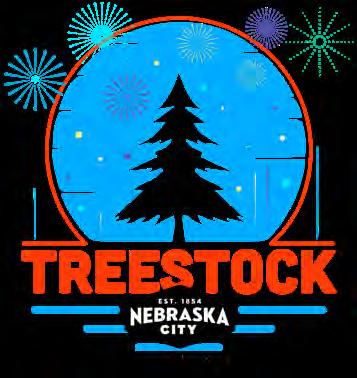









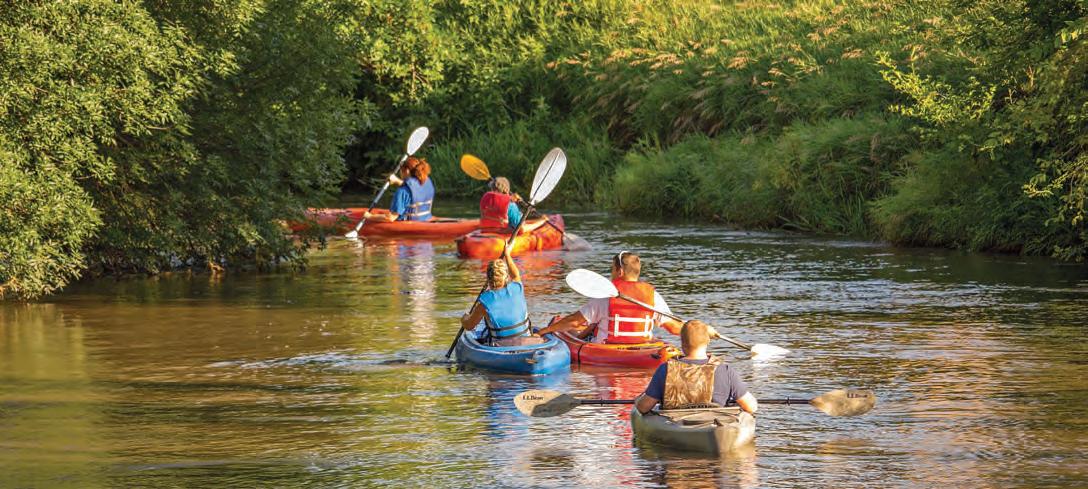
North Fork Outfitting offers adventure on the Elkhorn River with unique views of eagles, turtles, frogs, fish and songbirds. An urban journey on another part of the river will receive further enhancement after the city completes a restoration of Johnson Park and the North Fork.
BY MEGAN FEENEY
A couple on their first date thought they’d try something outdoorsy in Norfolk. They rented kayaks from North Fork Outfitting on a beautiful sunny day and set off on the peaceful Elkhorn River south of town. When North Fork Outfitting owner Tony Stuthman saw them off, all was well.
But when Stuthman went to pick the couple up at the end of their float, he encountered a paradoxical sight. The woman had blood on her shirt…and a huge grin on her face.
During the couples’ river journey, an Asian jumping carp had leapt from the water and smacked the woman square in the nose before splashing back down into the shallows.
It bloodied her nose, but she wasn’t badly hurt. Still, it wasn’t the kind of experience Stuthman envisioned for his guests. Most of the time, the wildlife views of eagles, owls, deer and fish were abundant but not literally in your face. At least it made for a story, the couple said.
Stuthman first discovered the magic of the Elkhorn River in 2014, when he took his family floating. He couldn’t believe how beautiful it was. That’s when he got the idea to launch an outfitting business.
Mostly about four feet deep, the Elkhorn River is slow with abundant spots to watch eagles and their young. On the water in a kayak or a tube, it’s easier to blend in, Stuthman said. Guests become part of the ecosystem and witness things they might not otherwise see – frogs sliding by, turtles sunning themselves, redwing blackbirds singing along the shore, and eagles diving for fish.
There’s also silly summer fun to be had at Skyview Marina, located in Skyview Park, where Stuthman rents stand-up paddleboards, canoes and paddle boats.
This year, his urban float on the North Fork of the Elkhorn River, which travels through town, might be put on hold as the city’s $10 million restoration of Johnson Park and the North Fork of the river gets underway. The city is building an outdoor venue for performing arts, expanding trails and pathways, installing new
playground equipment and channeling water to create “minifalls”– little areas of current still wide enough for a kayak or tube to pass through but that add a little excitement. Stuthman can’t wait.
In the meantime, he’s getting his commercial driver’s license, so he can drive his brand-new trolley around downtown Norfolk, showing his guests the growing bar and restaurant scene. Norfolk is a place where Nebraska’s natural beauty meets big-city offerings like microbreweries and boutique shopping, he said.
It’s so much fun that even the woman who was smacked in the face with the fish returned. She brought along her boyfriend – the same guy she’d been with on the date a year before. They were celebrating their first anniversary. This time the fish left the lovebirds alone.

Most of the time, a landfill is not a roadside attraction. But Leonard Gill of Jackson has collected vintage windmills, had them restored and put them on display just off Highway 20, in front of his family-owned landfill. The well-kept green grounds provide a wonderful place for motorists to stretch their legs and learn a little rural history.
This windmill collection, called Sentinels of the Prairie, features plaques detailing their stories. Windmills used to pump water in rural areas. They are a much beloved icon in Nebraskan landscapes.
Gill began his collection as a way to beau-
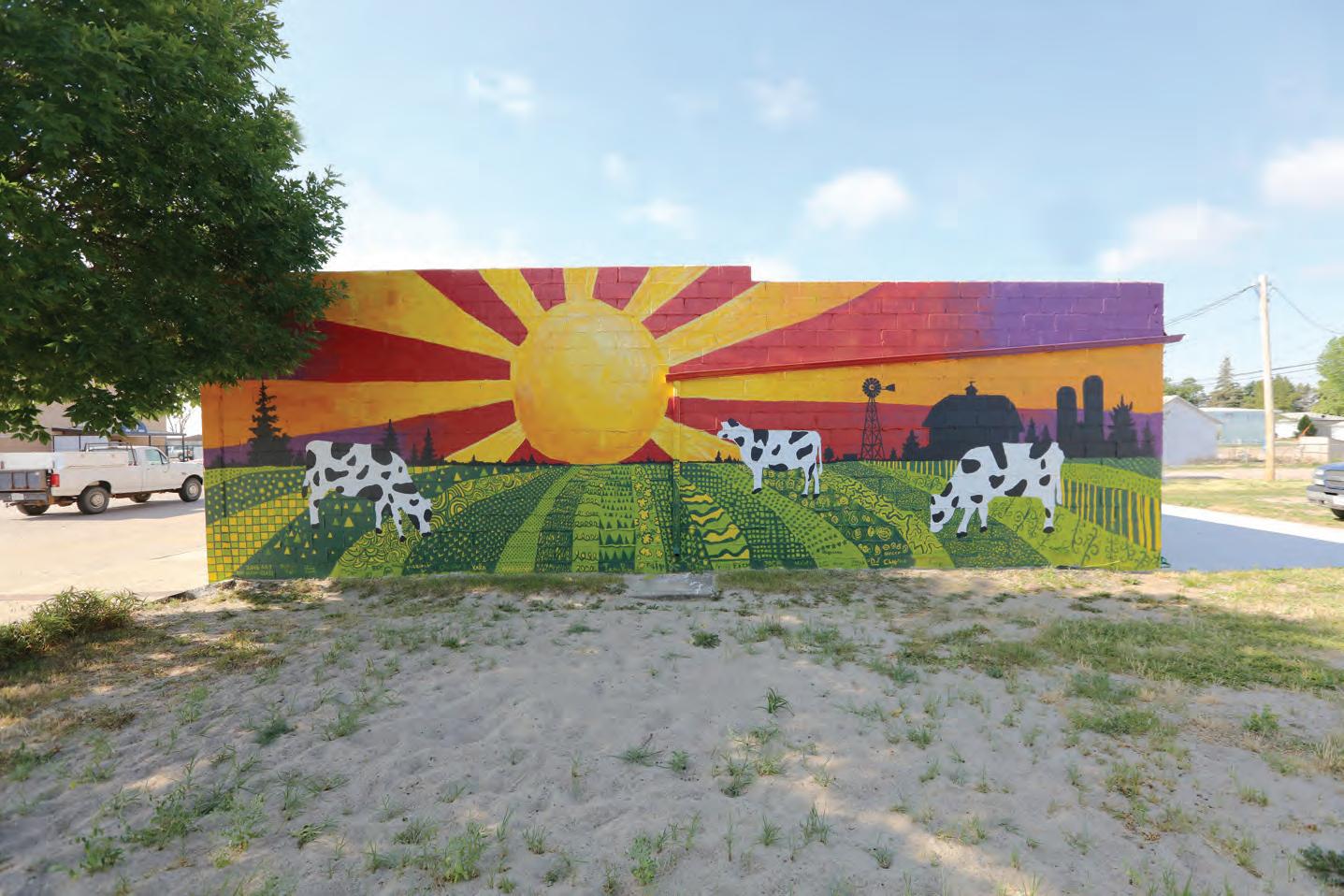

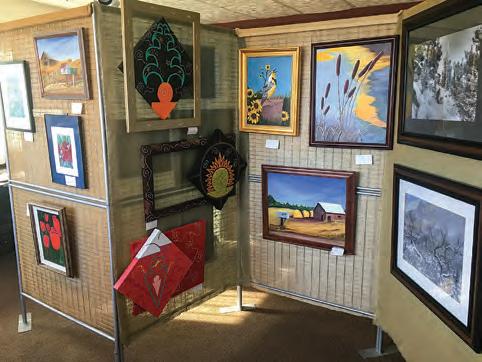

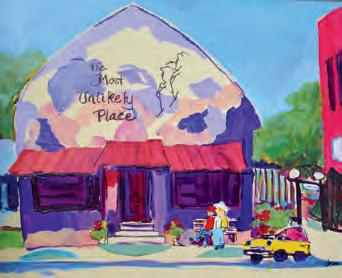
Grab a cup of coffee or a delicious lunch from The Most Unlikely Place, as Cynthia rolls past you on her skates. Enjoy the art gallery featuring local artists. Visit us online for a complete schedule of upcoming events!
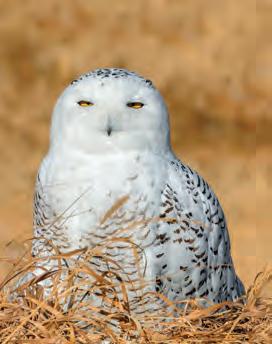

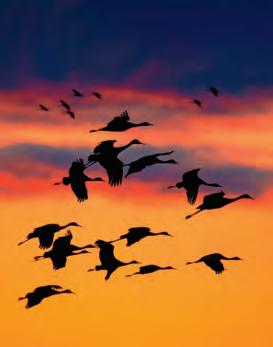

Treasure hunt 25,000 sq-ft-plus of antiques and collectibles. You’ll find something for everyone at the Aardvark Antique Mall. Lincoln’s best kept secret!
Located off I-80 and Exit 405. Open daily, 9 am-8 pm
402-464-5100 5800 Arbor Rd • Lincoln

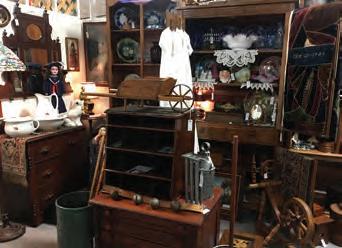
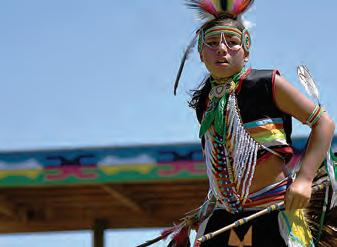
August 12,13 & 14
Grand Entries: Fri-7 pm, Sat-1 & 7 pm, Sun-1 pm
Take a scenic tour of Northeast Nebraska, and visit the Ponca Tribe of Nebraska for our Annual Powwow.
All Dancers, Vendors and Spectators Welcome.
For more information on this year’s Powwow, please visit our website at www.poncatribe-ne.org
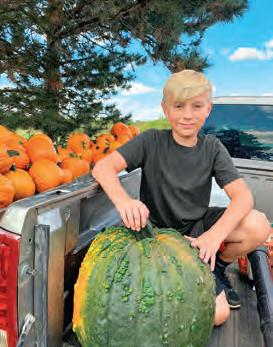
In each issue you will find breathtaking outdoor adventure, mouth-watering recipes, stunning photography, captivating stories and humor from every corner of Nebraska. Whether you’re a longtime resident, newcomer or distant admirer – if you love Nebraska, then this magazine is meant for you.


Relax withaglass of wine and enjoy a memorable sunsetfrom our porch. Just minutes southeastof NorthPlatte, I-80 exit 179 Look for our wines at Nebraska retail locations or shop our website.
Challenge your brain with our Nebraska quiz. Questions by ALEX FERNANDO
Checkourwebsite and Facebook forwinter hours. ur porch
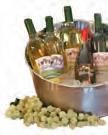
May-Sept.: Daily, 1-6 p.m.; Friday, 1-8 p.m. Oct-April: Friday-Sunday, 1-5 p.m.
An Estate of Fine Wine feather-river.com • 308-696-0 078 5700 SE State Farm Rd • North Platte

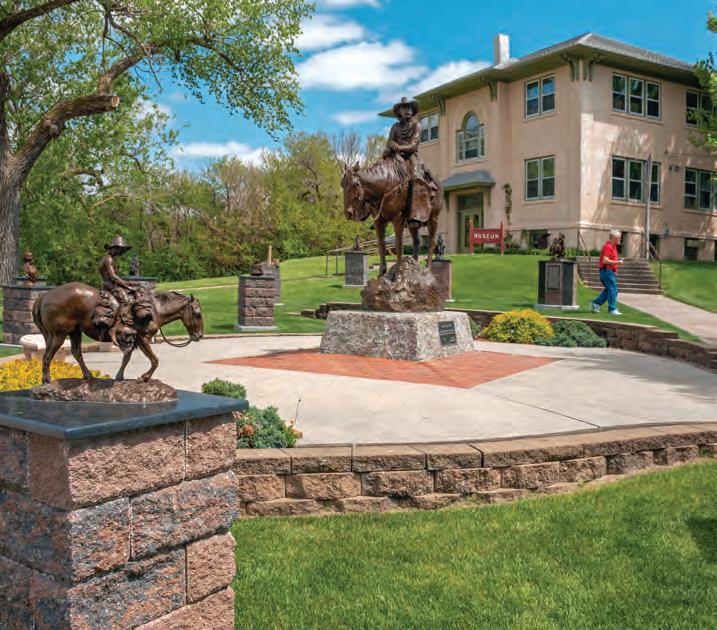
1 Where in the Sandhills can you find a 1,300-pound Polar Bear?
2
5 Cherry County makes up nearly 8% of Nebraska and is larger than which three U.S. states?
Nourish your skin with Mother's Day gifts and Easter Baskets shipped anywhere in the U.S. all natural sheep’s milk products. Select scents from kids options, unscented Native Nebraska fragrances and more. Try the “Hope” fragrance and Shepherd’s Dairy 4 Ewe will donate 10% of each sale to the American Cancer Society.
The Sandhills covers 20 of Nebraska’s 93 counties. Name at least two of these counties that are also popular first names for baby boys.
See our complete line including our gift sets at shepherdsdairy4ewe.com or request a brochure.

sales@shepherdsdairy4ewe.com • 308-643-7013
81051 Anselmo Road • Anselmo, NE 68813


3 The Nebraska Sandhills sits above the center of the Ogallala Aquifer. How many other states sit above at least part of the aquifer?
4 What flyway, used by up to a million sandhill cranes each year, cuts through the Nebraska Sandhills?
No peeking, answers on page 96.

6 Mari Sandoz is a famous Sandhills writer who penned the book Old Julie, which tells the story of her mother.
7 The Mignery Sculpture Garden in Bartlett is one of the largest displays of bronze statues in the U.S. Created by Bartlett native Herb Mignery, the 40 pieces recreate scenes of the American West.
8 Four of the 10 least-populated counties in the U.S. are in the Nebraska Sandhills.
9 Agriculture is the number one industry in the Sandhills. Tourism is number two.
10
One new niche that some Sandhills counties are exploring is “astrotourism” – inviting visitors to experience Nebraska’s broad, dark skies that sparkle with stars and planets.

11
This 72-mile river snakes its way through the Sandhills, fed by the Ogallala Aquifer, filled with quicksand and featuring rattlesnakes sunning on its banks. What’s its grim name?
a. Misery River
b. Dismal River
c. Blackheart River
12
The Sandhills region is one of the most diverse and unique ecosystems in North America. Among 720 plants thrive there, including all but:
a. Bigroot prickly pear
b. Yucca
c. Avocado
13

School started early in the Sandhills – and we’re not just talking about the morning. Centennial Hall in Valentine is the oldest standing high school building in Nebraska. What year was it built?
a. 1897
b. 1877
c. 1907
14 In the Western Hemisphere, the Nebraska Sandhills are the largest grass-covered:
a. Loess hills
b. Sand dunes
c. Sand boxes
15
Formerly #1 in the world, the Nebraska National Forest at Halsey is the largest humanplanted forest in the U.S. Which tree-loving Nebraskan spurred the planting?
a. J. Sterling Morton
b. Harlan Hamernik
c. Charles Bessey
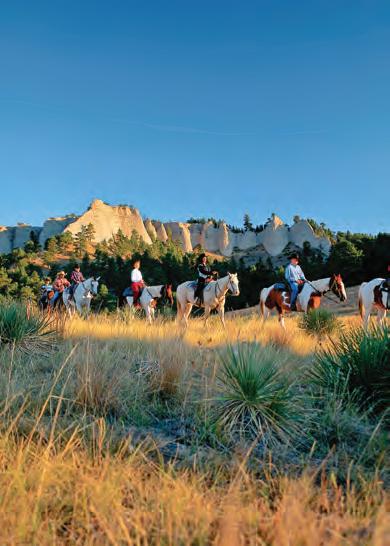

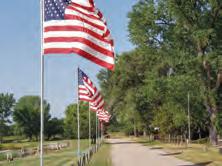
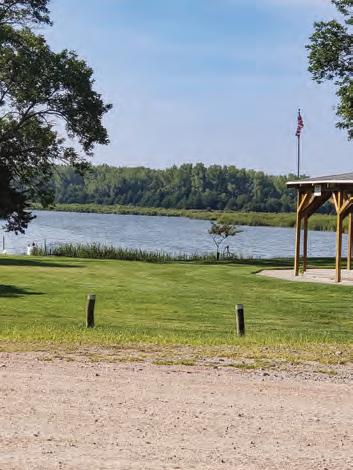
Cornhuskers don’t take their state’s unique geological formations for granite
by MEGAN FEENEY


Wildcat Hills State Recreation Area is one of Nebraska’s many rugged landscapes to explore in the western part of the state.
Quarter showcases not an agrarian scene, but an oxen-pulled covered wagon carrying pioneers and passing Chimney Rock – debatably the state’s most recognizable landmark. Settlers traveling west on the Oregon, California and Mormon trails journaled how seeing the landmark brought them hope. Thousands etched their names into its surface, though years of Nebraska weather scrubbed away the evidence from this pillar made of Brule clay, volcanic ash and Arikaree sandstone.
In the past 150 years, Chimney Rock has lost at least 30 feet to erosion, but that’s done nothing to diminish its stature in peoples’ imaginations. Yet to end the appreciation of Nebraska’s unusual geologic formations and craggy terrain with Chimney Rock would be a mistake. A vast array of otherworldly vistas in Western Nebraska tells the story of this land, its prehistoric life, its wildlife and botany, and its many peoples.
ELBOW BY ELBOW, the man dragged himself up the North Platte River’s sandy bank. He retched. Illness wracked his body, which shuddered, spent with the effort of crossing the river. Gasping ragged breaths, he looked up to the bluffs along the North Platte, drinking in the sight of the majestic rock formations one last time before he succumbed to death.
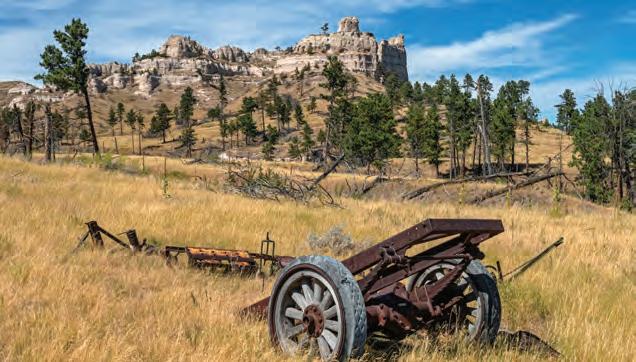

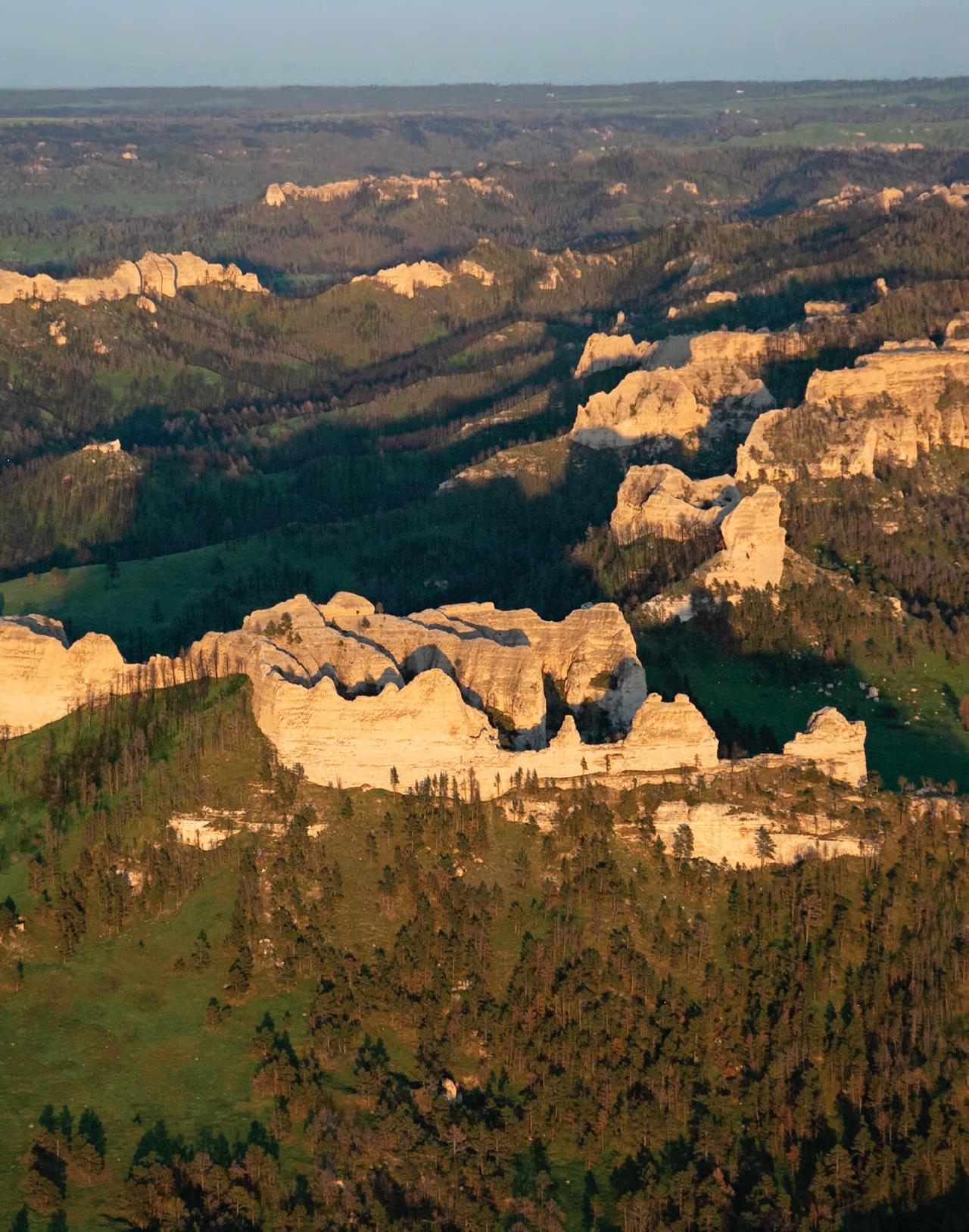
Chimney Rock lost height due to erosion, but it still occupies a huge space in people’s imaginations and in the state’s history.
Derrald Farnsworth-Livingston


This is one of several competing stories of Hiram Scott’s demise. It’s a story long on legend and short on facts, but most accounts seem to agree that Scott was swarthy, strong and tough enough to chew nails and spit rust. The trapper and trader survived the first Plains Indian War in 1823. As a clerk for the American Fur Trade Co., he traveled from his home in Missouri. A decade after his death in 1828, the fur trade began to wane and soon would be no more, but the largest of those geological features along the North Platte will forever be known as Scotts Bluff.
Disease ended his life, but Scott encountered many dangers in his work, including hostile tribes who resented European encroachment and wild beasts. At least Scott never risked encountering the skull-crushing jaws of a hyena-tooth or the brutish aggression of a hell pig. That was before his time.
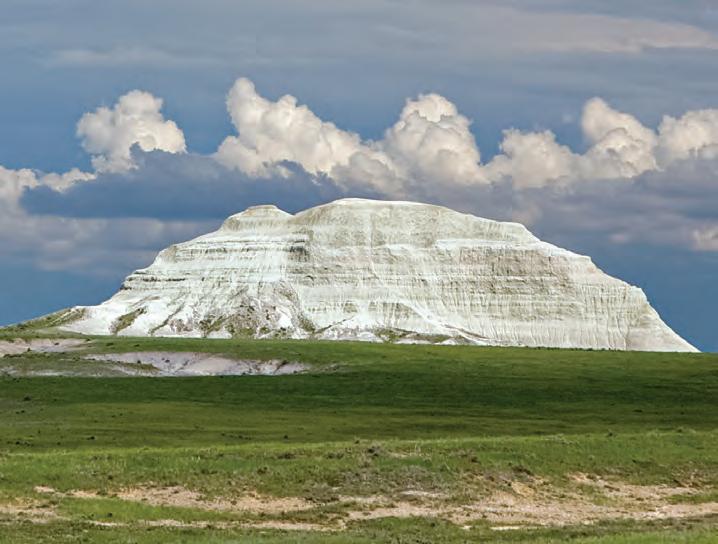
The sun rises over Toadstool Geologic Park, illuminating the landscape with a pink hue and highlighting the colorful rocks.
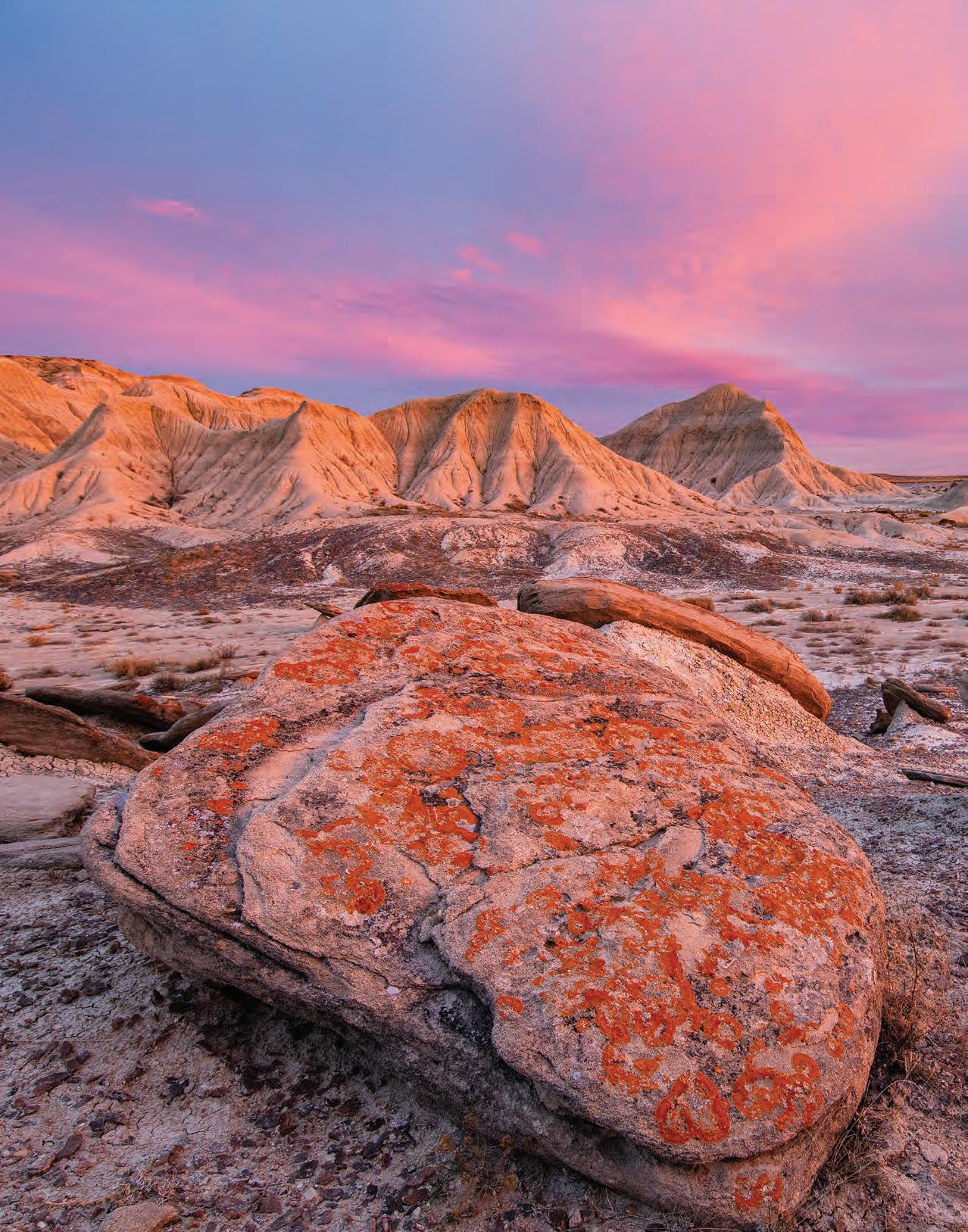
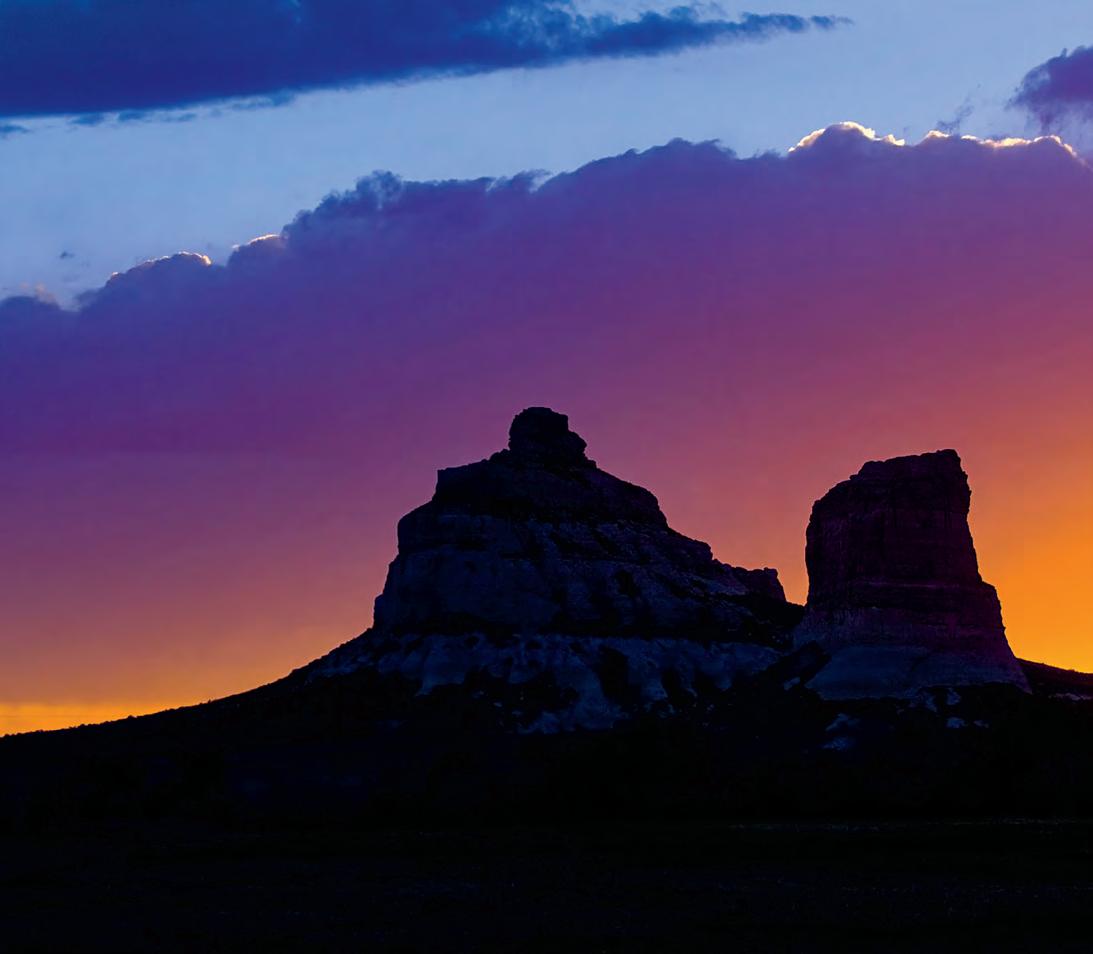
Travelers passed by Courthouse and Jail Rocks, near Bridgeport, on the Oregon-California Trail, the Mormon Trail, the Pony Express Trail and the Sidney Deadwood Trail. A legendary battle between the Sioux and the Pahani took place at Courthouse Rock, with a clever escape.
Launching itself forward with muscular legs, the Hyaenodon – or hyena-tooth – grabbed an ancient sheep-like creature called an Oreodont in its jaws and crushed its neck with one fearsome bite. Hyaenodon was one of the top predators during its time. Its only competition was the false saber-toothed cat, which also roamed the same territory in hunt of prey.
These dramas once played out in the area now known as Toadstool Geologic Park. The last Hyaenodon disappeared from North America millions of years ago, but remains of them, as well as other ancient mammals, have been found at the park that is north of Crawford. Equally
intriguing are the rock formations that inspired the park’s name. Sandstone floats upon the eroded foundation of silt and clay, resembling an alien world. Some rocks have fallen after the bases eroded completely. Few things are truly immutable in Western Nebraska, but even in the sandy loam, year after year, life finds a way.
An explosion of colorful wildflowers carpets the summer meadows at Pine Ridge Recreation Area south of Chadron. Sunflowers showcase golden heads; star lily that almost resemble ocean creatures remind visitors that a shallow sea once covered the state; beardtongues
bob in the breeze as bees circle lazily. There are sweet little heath asters – like so many tiny daisies – and plump purple gayfeathers.
There are flowers with wonderful names to roll around on the tongue – like pricklypear and scurfpea. Native grasses stretch for the sun, and in the distance, sandstone bluffs rise from the earth. Insects hum an ancient tune, and the wind whispers through the ponderosa pines.
Nature has its own special way of telling stories about this enchanting part of Nebraska. If only the rocks, which have been here longer than any of the rest of it, could talk.

Sandhills artist and Sandoz relative portrays ‘the living West’ with divinely inspired drawings
story by JOE ARTERBURN
photographs
by
AUDREY POWLES
art by RACHEL BROWNLEE
ON A RANCH in the Sandhills, Rachel Brownlee sits at her drawing desk and looks out the window at barns, a machine shop, corrals, horses and cows, and people going about their chores. Also shoehorned into the small office space is her day job computer desk, her husband, Ethan Brownlee’s desk, and the play space for their 2 ½-year-old daughter, Hedda. The family resides in the old cookhouse on the JHL Ranch, which has been in or operated by Ethan’s mother’s family for nearly 60 years. Wide, beautiful hay meadows watered by springs and a ditch system provide a rich, verdant setting for the sprawling ranch, 16 miles north of Ashby.
Daily, Rachel makes time among her working and parenting duties to draw her vivid charcoal pencil illustrations of ranching life. Artistic inspiration runs in her family. So does resistance to letting the dominant culture squash it. Her great aunt Mari Sandoz persevered through cultural and familial resistance to her writing career to create lasting works of literature; self-taught artist Rachel is winning over the ranch community with the authenticity she depicts in her drawings.
Rachel’s other role at the ranch is also slightly unconventional. She captures data about the family’s 1,200 cows with software she developed called
Moo Manager while a student at the University of Nebraska at Omaha. Currently, her company has three clients with a total of 100,000 cattle. The software tracks each cow over its lifetime to record metrics like weight and vaccines. These data points inform a rancher’s breeding and financial decisions – which bulls increase meat quality or which genetic lines lead to undesirable characteristics, like bad feet or calving issues.

Her art career skyrocketed after a Tucson art show last November. When she saw her drawing titled “At the Ready,” on the wall with a ribbon next to it, she was surprised. She’d won best in show. The art show was also a revelation. Renowned Western artist Myron Sahlberg led her to her piece to tell her why her picture was so good. Without knowing, Rachel, who’d never taken an art class, had been using specific techniques that make her drawings intricate and lifelike. She incorporates eye-pleasing aspects, most notably the Fibonacci spiral, a pattern found in nature first discovered by ancient Greeks, later by an Italian mathematician.
Rather than priding herself on her natural ability, Rachel credits God as the originator of her gift, which is always growing. “My learning curve is unique
because God uploads a new ability to me like every three or six months,” she said. Recently, she learned layering. Drawing grass and dirt has always challenged pencil artists, she said, because “you can’t just draw a bunch of fine lines if you’re drawing grass.”
“God showed me how to lay down different layers and blend them in with brushes, erase certain areas and draw another layer over the top of it and blend it in with a brush, then finish with highlights. I hadn’t seen another artist do something like that.”
RACHEL GREW UP with her brother and five sisters on their grandmother’s ranch along Pine Creek, 20 miles south of Rushville. Her grandmother is Celia Sandoz Ostrander Barth, granddaughter
of Old Jules Sandoz, an early settler and prominent feature in Nebraska history thanks to his daughter, author Mari Sandoz, Rachel’s great aunt.
Rachel, now 28, and her siblings were homeschooled as kids. Although Rachel never formally studied drawing or painting, when she was 9, she acquired two second-hand art books depicting horses, a favorite subject. No one disdained her ability to draw, but no one encouraged her to pursue it as a career, either.
Her childhood was spent outside working the ranch and playing in the hills. When she was 12, she bought a blue roan quarter horse and a saddle with money she’d earned working. It wasn’t a great match. “She hated me. She bucked me off every day and tried to kill me.” Still, Rachel stuck it out with her animal.
Artist Rachel Brownlee’s drawings adorn the wall of her family’s residence in an old cookhouse on a family ranch 16 miles north of Ashby in the Sandhills. Self-taught, Rachel credits God as the originator of her gift. Artistic genes might help, too. Mari Sandoz is a relative.

That grit helps Rachel start every day at 4:30 a.m. She prays, reads the Bible, and goes for an hourlong run before waking her daughter at 7. She draws between meal preparation and housework – with Hedda playing nearby – and during Hedda’s afternoon nap. Her medium of choice – charcoal pencil – is a lot like her childhood horse, “incredibly messy and completely unforgiving.” But she’s learned how to keep it under control, by frequently washing her hands, vacuuming the paper and work area constantly, and holding her breath as she draws. She reserves evenings for time with Ethan.
She met Ethan at a youth camp at Pleasant Point Church, a non-denominational gathering place for residents in the remote rolling grasslands. At 13, she decided she’d marry him one day. Daydreaming about her future married name, she designed the “RB” logo she uses today. The church, about halfway between Rachel and Ethan’s home ranches, is south of Gordon along Highway 27, also known as the Mari Sandoz Sandhills Trail.
Ethan plays numerous musical instruments, including piano, guitar, violin, ukulele, glass flute, recorder and kalimba, but not publicly. He just does it to entertain Hedda and Rachel. Hedda likes music and dancing. She strums her father’s guitar and sings. She also pretends to read and helps feed and water the family’s two nearly identical gray cats, Milo and Rhoadie, and do the cow feeding chores with her dad.
Rachel and Ethan maintained a long-distance relationship between their home ranches and then between the Sandhills and Omaha during Rachel’s four years in college. She finished top of her class with a degree in IT Innovation, computer science with emphasis in entrepreneurialism.

Rachel grew up in the Sandhills and wants to preserve “the living West,” in all its gritty beauty. She models her drawings after real people. Her medium is charcoal pencil. Messy, it takes discipline to control.
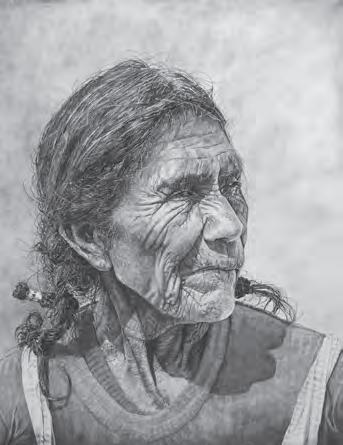
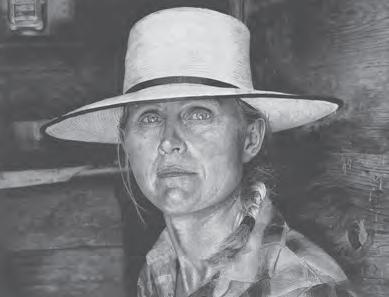
Always talented at drawing, she considered a career in graphic arts but during a visit to UNO, something she said caused advisors to steer her to computer technology. She studied 40 hours a week and worked 40 hours a week, at various software jobs or tutoring students. She hardly drew at all.
a pragmatic person – and she imagines her great aunt Mari was, too. Maybe pursuing art wasn’t a practical ambition, but Mari and Rachel each had a higher purpose in doing so. They both wished to illustrate and record the lives of the people surrounding them. Capturing people during their moment in history would allow future generations to know them.
Mari was one of the few writers who documented living members of Plains Indians at that time. Now it’s Rachel’s turn to depict parts of the ranching lifestyle that are slowly receding – like the diminishing use of horses in ranch work.
When Rachel was young, all ranch work was done on horseback or in a Ford pickup. Now, it’s mostly done with four wheelers. That’s changed the apparel, too. Cowboys are trading in their felt hats and wool chaps for Gore-Tex overalls and snowboarding goggles. “Rope and drag” brandings will likely someday be a thing of the past – and cowboys might swap their leather boots for insulated work boots for good.
On Rachel’s drawing desk now is a partially complete work of a woman riding a black horse through a herd of cows, getting ready to rope a calf. The woman, modeled after a local, is typical of the friends and neighbors that Rachel draws.
Much Western art portrays beautiful moments – sunsets, a rider on a horse –or the Old West. Rachel draws “the living West…People who are living this everyday and aren’t just on a trail ride.”


Rachel balances family life, chores and a small business with her drawing by following a strict schedule, which includes daily prayer and a long run. There’s always time for snuggles with Ethan and Hedda.

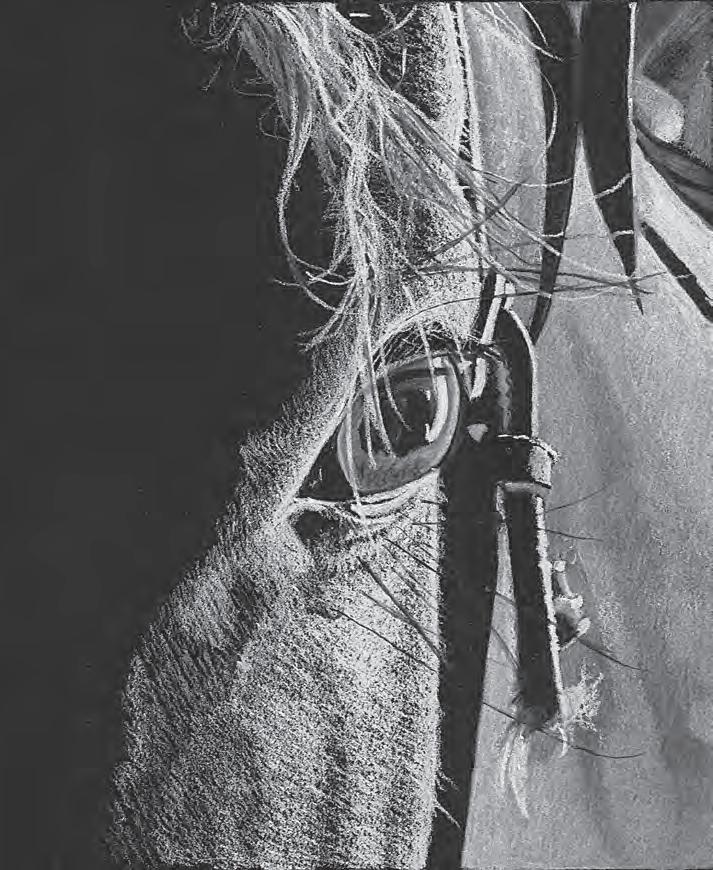
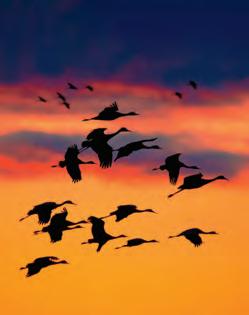
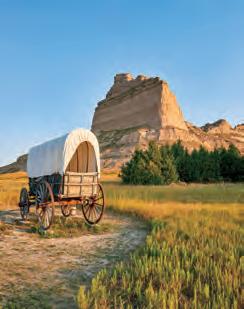
Her drawings portray painstaking details about those lives – a 40-year-old saddle, a pair of grandfather’s spurs, a wornout pair of boots. These items reflect times of prosperity and times of struggle. “I want to draw the dirt on their hands and the broken cinch and sewn-together headstall, and the young horse covered in sweat and dirt,” Rachel said.
She considers her work an homage to people’s lives. Last year, five people cried the first time they saw themselves depicted in her drawings. “It captures a respect for their whole life working outside and being tired and dirty and hot and cold,” she said.
Much has changed since Mari Sandoz wrote, but there are still residual opinions
about what a woman should be in Western Nebraska, Rachel said, and she’ll continue to buck them.
“A good cleaner, cooker, baby maker and always ready to help on the ranch and even do the books,” she said. “But when a woman tries to break out of those roles, or just adds to them, there’s almost an attitude of pitying consent, like ‘if you need another hobby, I guess you can program, draw, think, as long as it doesn’t disturb anything.’ ” What some don’t get is that art isn’t a luxury – it’s a necessity.
“Mari and I both have this internal impetus that the craft has to come out of us. Whether drawing or writing,” Rachel said. “It needs to exist, and we need to do it.”

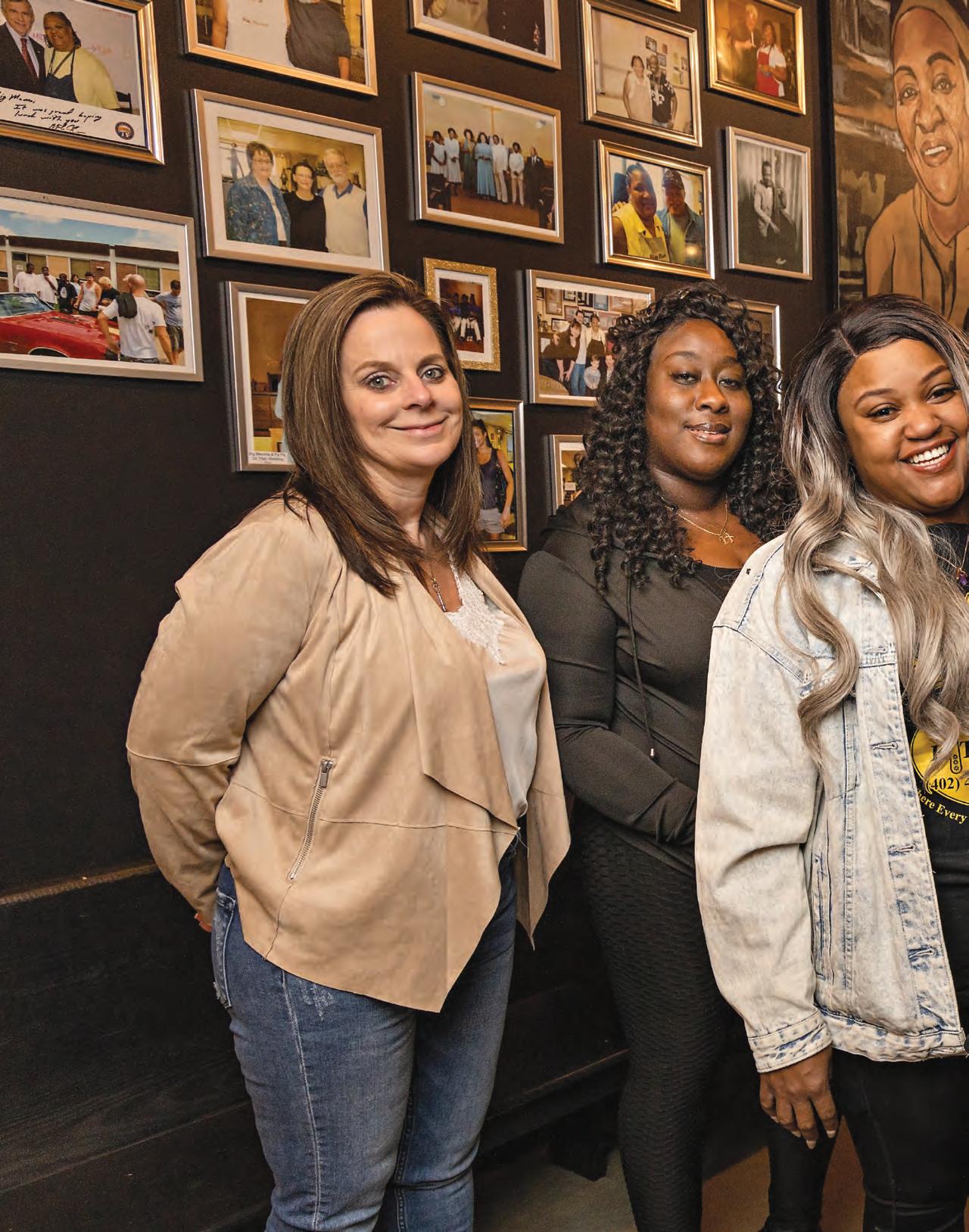
Big Mama’s Kitchen serves food, hospitality, and hope in North Omaha
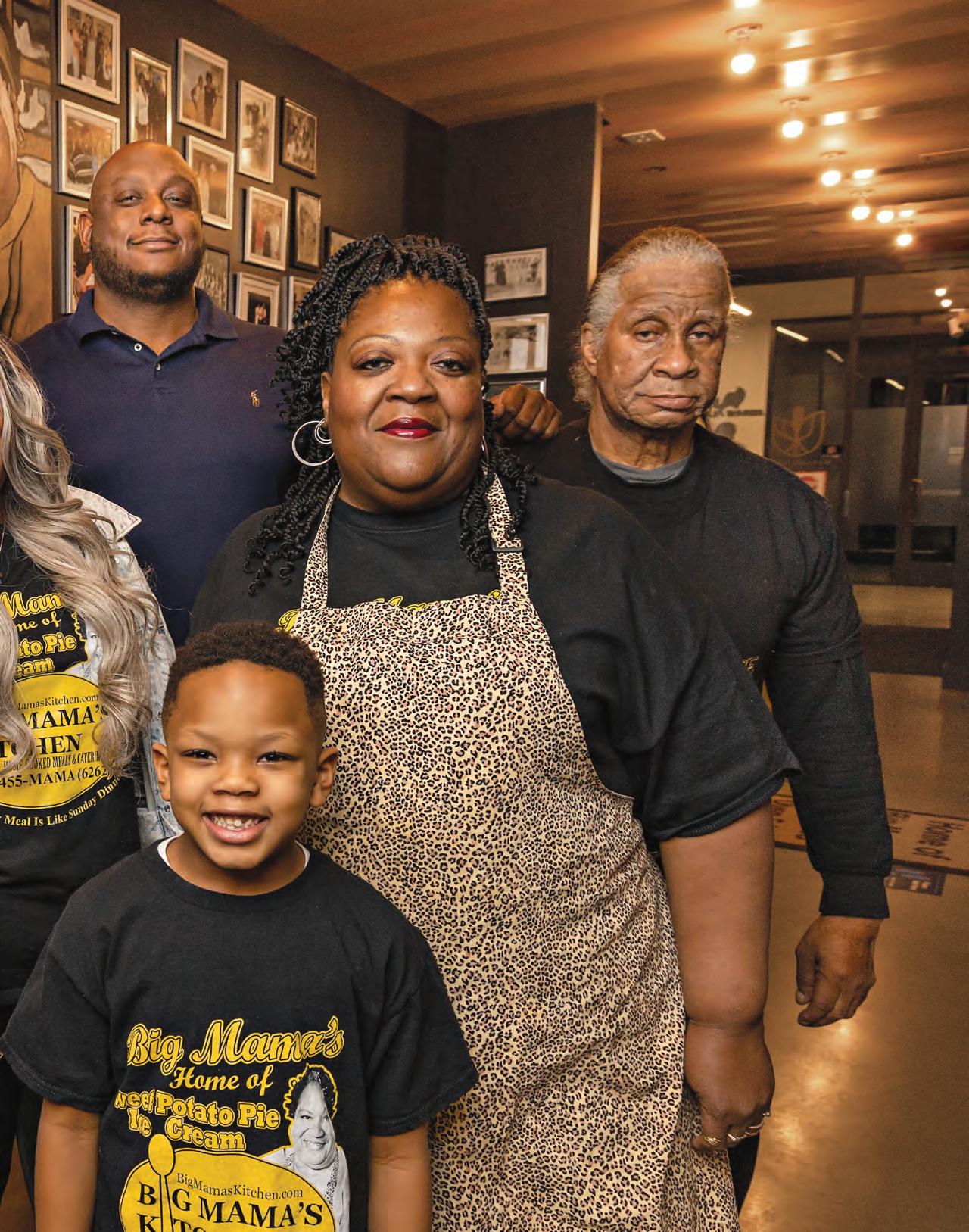
For 15 years, Patricia Barron’s family has supported their matriarch’s delicious dreams, even after she passed away in 2018.
IT’S A FRIDAY dinner rush, and the energy in Big Mama’s Kitchen in North Omaha sizzles like the breaded catfish hitting the grease. R&B music bumps from a handheld radio high atop a metal shelf. Laughter rings and pans rattle and clang. An extended family and staff push to complete orders.
Briannah Harrison mans the fryer. She’s the third generation in a family that’s keeping her grandma Big Mama’s food and mission going – and growing. A new family-owned cocktail bar, Dena’s Place, named after one of Big Mama’s daughters, occupies the same floor of the restaurant’s new location in the Highlander Accelerator building on North 30th Street in Omaha.
Big Mama – also known as Patricia Barron, nee Givens – died before her restaurant could move from its location in the former School for the Deaf cafeteria into its new sun-filled space in 2020, but Briannah has the flavor handled.
“I’m the spice and sauce boss,” Briannah giggles. “I know everything good has
to have some season and some sauce.”
Nearby, Briannah’s mother Gladys Harrison rolls her eyes as she makes Soul Food Croquettes – a mixture of cornbread stuffing, finely chopped collard greens, cheddar cheese, seasoning and “pot licker” (the juice from cooked collard greens) – which she pats together and bastes with an egg wash before baking.
She cracks the eggs and separates the yolk one-handed.
“And Big Mama used to say my mom didn’t know how to crack eggs,” Briannah said.
“Well look at me now,” Gladys cackles, cracking another hard against a metal bowl.
of biscuits mingled with the earthy musk of the wood-burning stove. As a girl in the late 1940s, this was how Patricia Givens – who’d one day become Big Mama to her family – learned to cook from her Grandma Lillie in a North Omaha home.
In the years that followed, Patricia would face turmoil and change, but the biscuit
Big Mama passed away before she could see her restaurant’s new location in the Highlander Accelerator Building completed on North 30th Street, but she would have approved of the abundant natural light and the interior design that reflects her taste.
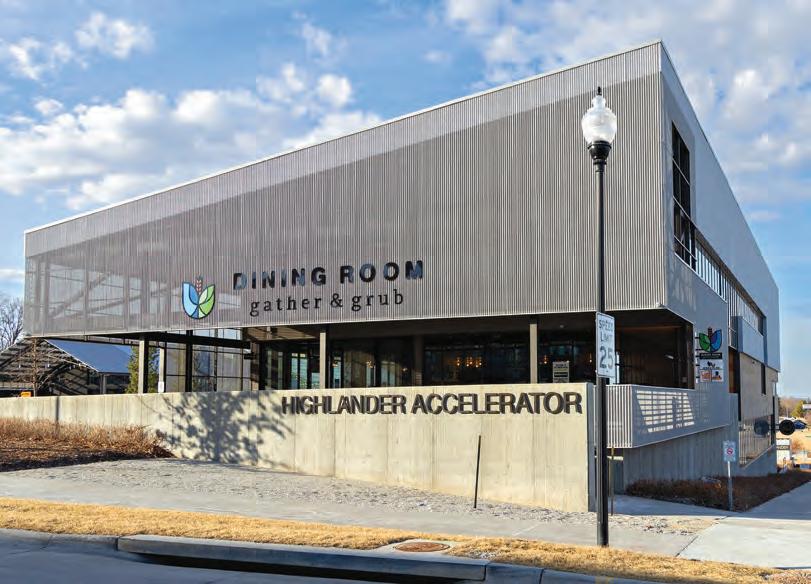
recipe would remain a comforting constant. She grew up in segregated Omaha, when signs posted on café windows read, “We Don’t Serve Any Colored Race.” Still, there was vibrancy in her North Omaha community, with its many Black-owned businesses. Patricia served in the Navy right after high school. Later, she raised four daughters, Donna, Debbie, Delena and Gladys, and worked in corporate telecommunications. As a side hustle, she catered parties from her home kitchen. Instead of an easy retirement, in 2007 at the age of 65 Patricia opened the restaurant Big Mama’s Kitchen at 45th and Bedford Streets in the old Nebraska School for the Deaf cafeteria.
She decorated with her signature bright yellow and animal print flair. Today, her family members still accessorize in homage to Big Mama – donning a leopard headband or a cheetah face mask.
Patricia served crowd favorites, like oven-fried chicken, macaroni and cheese, and sweet potato pie ice cream, as well as occasionally offering her most personally beloved dishes that took others a little more courage to try – like beef tongue with butter beans.
Her restaurant received national attention with several appearances on The Food Network, including a pilot for a show that wasn’t picked up. Once, Patricia talked the host of Diners, Drive-ins and Dives Guy Fieri to chomp into a pig ear on a bun, despite his initial misgivings. It was hard to say no to Big Mama.
She combined her toughness with an expansive generosity. A tenant of the Christian faith found in the Gospel of Mark, “For the last shall be first,” guided her outreach to provide employment opportunities – and community college scholarships – to formerly incarcerated people looking to transform their lives.
CORNELL AUSTIN IS enjoying the late-afternoon sun on his porch in North Omaha after finishing his shift cooking for the homeless. He’s the head cook and kitchen manager at a local nonprofit. He grew up on this block in his grandmother’s old house down the street. His brother and sister-in-law live there now.
Cornell was one of eleven children.
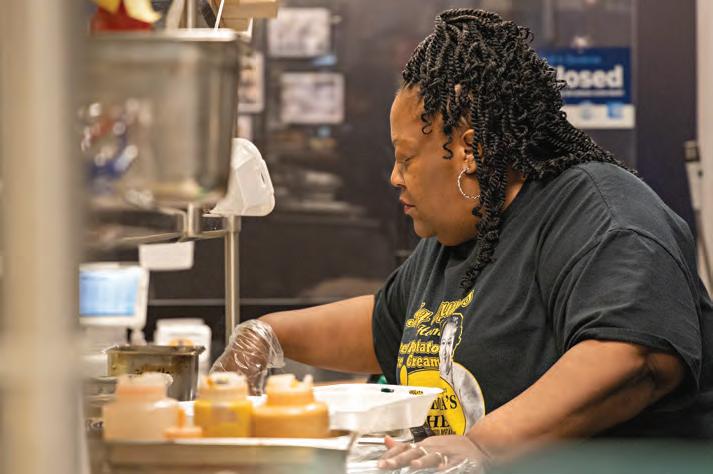
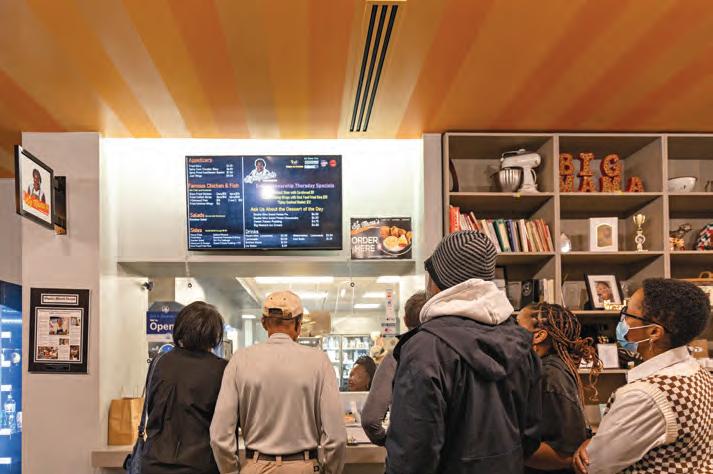
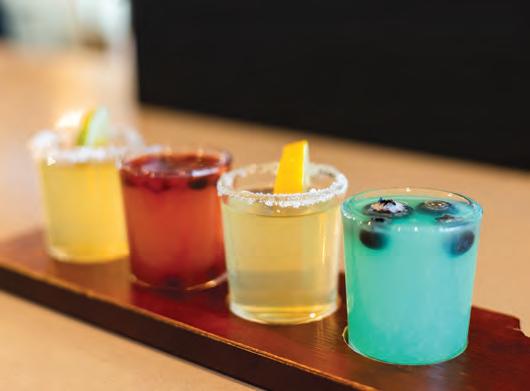
The family didn’t have much, but Cornell loved food from a young age. As soon as he could reach the table, he considered how to transform the family’s meager rations into something delicious.
After high school, he cooked to support himself, but he became addicted to alcohol and drugs. He was arrested in Milford, far from his family. “Drugs and alcohol take you places you never thought you’d be,” Cornell said.
While serving time in jail, he saw a television commercial for Big Mama’s Kitchen and said to himself, “I’m going to go work for her when I get out.” That’s what he did. “And my life hasn’t been the same since.”
Big Mama made it widely known that she gave second chances. She told Cornell she believed in him and his ability to change and thrive. He got sober and has stayed that way for the past decade with the help of a 12-step program and church. He worked for several kitchens after he left Big Mama’s; each job had more responsibility and higher pay. He earned his associate degree in culinary arts and is now working toward a bachelor’s degree in business. He has plans to launch his own catering business someday.
“Big Mama believed in me before I could believe in myself,” Cornell said.
Sometimes believing had to be enough to keep moving forward in the face of difficult odds.
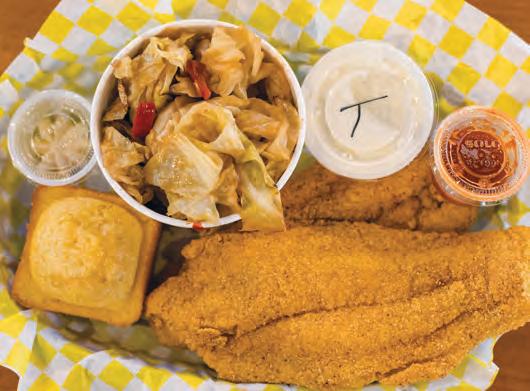
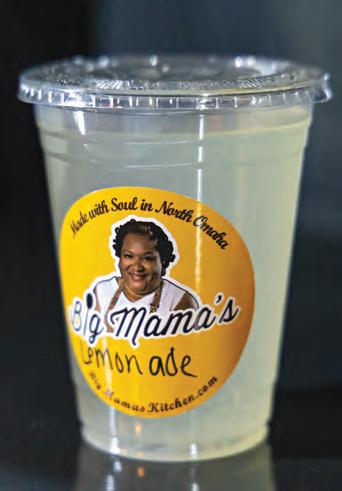
CONSTRUCTION TASKS WERE underway for the new space when Big Mama received a cancer diagnosis in late 2016. She shared the news with family, including her youngest daughter Gladys.
Gladys had served as Big Mama’s General Manager since her mom opened the restaurant in 2007. She was her mom’s righthand woman. Gladys was used to multitasking and working under pressure, but facing the prospect of caring for her mother’s failing health, running a business in one location and building out its new space felt overwhelming. Still, canceling the plan to move into a better space wasn’t an option. They’d outgrown the old space; and Patricia was desperate to be part of the exciting new things happening on North 30th Street.
The family worked with the nonprofit group Seventy Five North to design their new restaurant. The nonprofit was leading efforts to develop the economically depressed area of North Omaha that had
once been occupied by a public housing project. Seventy Five North was developing mixed income housing, educational facilities, and arts and amenities.
The nonprofit and Patricia and Gladys settled on a high-end food court concept for Big Mama’s Kitchen and Catering. Guests would order at the counter and take a seat at any table in the spacious main dining area or choose a place on the outside patio. Entering the foyer, a gallery wall of family photos and scenes from the original restaurant, as well as an oversized painting of Big Mama, would decorate a wall. Sun would pour through oversized windows. Yellow stripes on the ceiling would reflect Patricia’s favorite color – and represent the light she brought to people’s lives with her food and her faith in them.
But even as Patricia delighted in these plans, even as she thrilled at the culminating achievement of a life devoted to cooking and loving people, she was dying.
Patricia insisted on visiting the site as









it developed until she couldn’t get out of bed by herself. She soon went into hospice. A nurse tried to reason with her. “You’ve had such a wonderful, rich life. You’ve had children and grandchildren and great grandchildren. What is it you’re still trying to do here?” I’ve got to see my restaurant get moved, Patricia responded. And, as long as they were talking about things she still wanted to do, she’d always thought Japan sounded like a lovely place to visit.
One day, Patricia summoned her daughters to her bed. She was ready to stop her treatments. They were only prolonging the inevitable. She was tired and ready to let go. But first, she needed them to make her a promise.
Open seating encourages interaction among guests. Big Mama told her kids and grandkids, “Everyone is a friend.”
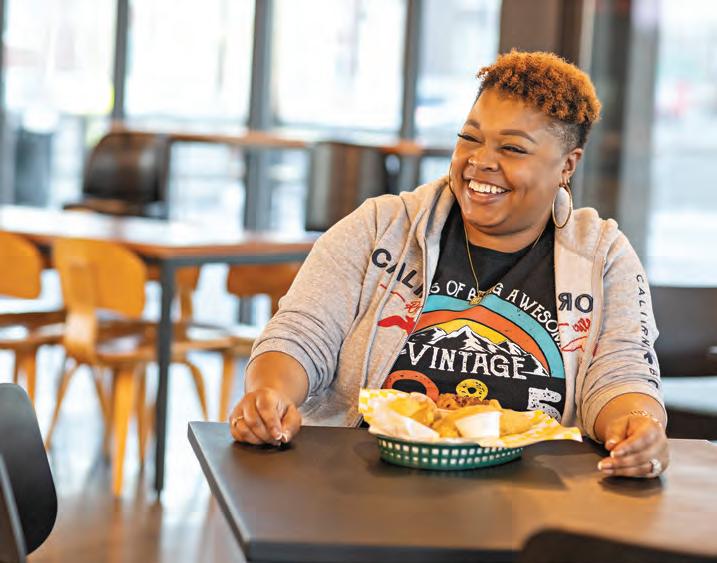






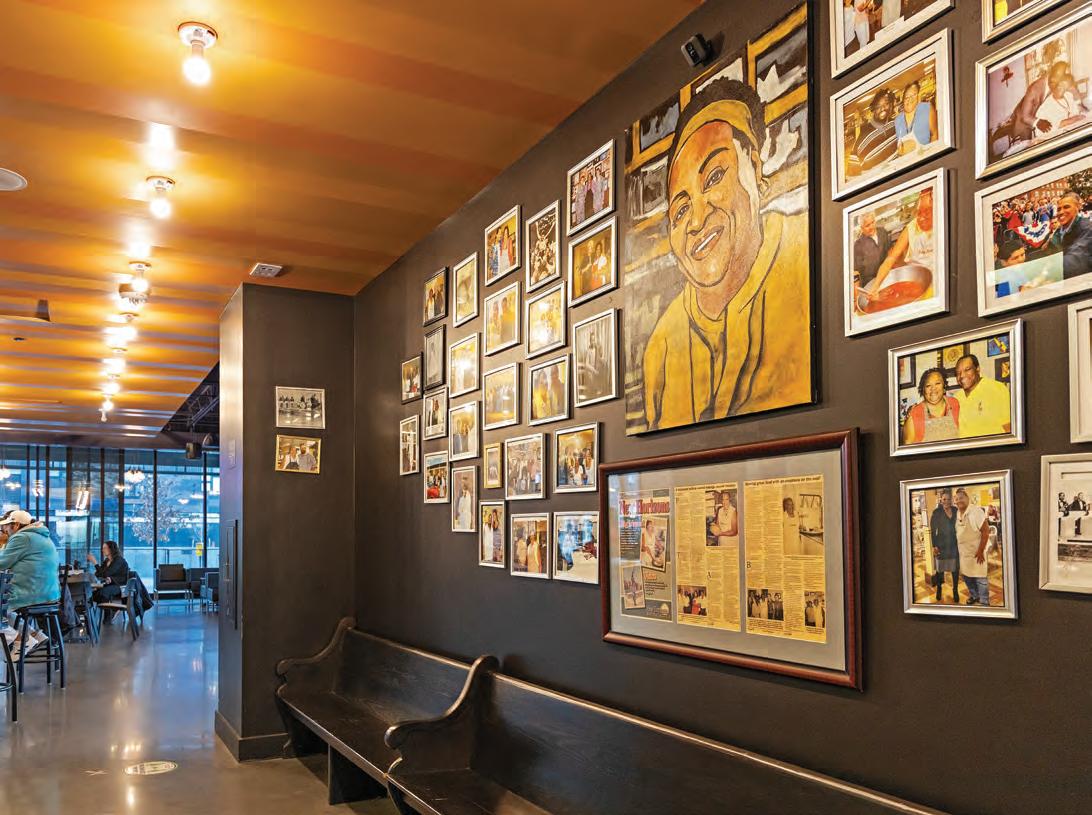
GLADYS PLEDGED TO her mother that she’d get the restaurant moved and keep it going, no matter what. She would honor her mother’s dying wishes to feed and radically love people in the historically Black neighborhood and to welcome everyone to Big Mama’s – whatever race, religion, or history. Assured that her daughter would stay true, Patricia “Big Mama” Barron died in March 2018. She was 76 years old.
Grieving her mother, and handling outstanding debts, Gladys anticipated the fresh start the restaurant’s new venue would provide. She opened in January 2020 to the restaurant’s strongest sales ever. Things were looking up for Big Mama’s. Nothing could stop them now.
Then the pandemic hit. Gladys navigated as nimbly as she could. She cut staff. She went to takeout-only for months. There was yet another blow when her sis-
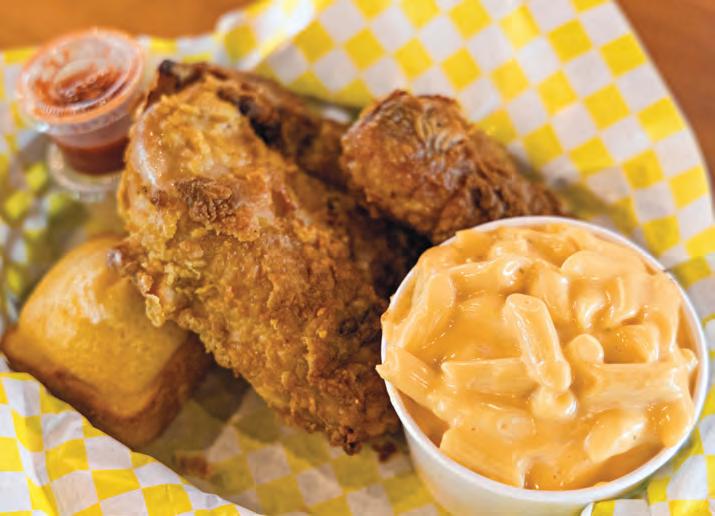
ter, Delena Givens-Brown, passed away on the last day of the year. Delena had long suffered from sickle cell disease, but she’d brought levity and laughter to the family. She was a creative force who often ruffled oh-so-serious all-business little sister Gladys, just to smooth her out again with a joke or a warm touch. She made jellies and jams for Big Mama’s, which she sold at the restaurant, online and at farmers and craft markets. She loved pottery and painting. Like everyone else in her family, she found joy and purpose in entertaining people with good food and drinks.
A DJ KEEPS the music flowing at Dena’s Place, located in the same space as Big Mama’s. There’s not an empty seat at the bar. Guests spread out at the surrounding tables. Owner Seneca Harrison works in tandem with another bartender, shaking, mixing and stirring colorful drinks. He generously garnishes his completed creations with freshly cut fruit.
Seneca is Big Mama’s grandson and Delena’s son. He named his bar after his deceased mother’s nickname, Dena. He is tall, broad and fit, with a deep voice and a genial smile. He whips through drink or-
ders but not without taking time to connect to each person he serves.
“One thing I learned from my grandma is you befriend everyone. Everyone’s a friend,” Seneca said.
Seneca grew up in North Omaha and learned the trade of plumbing. Later, he became a serial entrepreneur. He owns his own plumbing business and co-owns a medical research company with his wife, Tricia. Seneca hopes the tag-team effort of the restaurant and the bar brings people back to North Omaha who left and attracts people who have never explored it. He knows among some the neighborhood has a bad rap.
What his family is trying to show is that North Omaha is a great community, “a place where you can enjoy a meal and drinks and be with friends and family.”
After all, that’s what North Omaha has always meant to Big Mama’s family.
As the night goes on at Dena’s Place, some patrons leave their tables to dance and mingle. The drinks are cold; the conversation is warm. For ambience, a bartender lowers the lights. But in the foyer, the portrait of Big Mama’s smiling face radiates a brilliant glow.
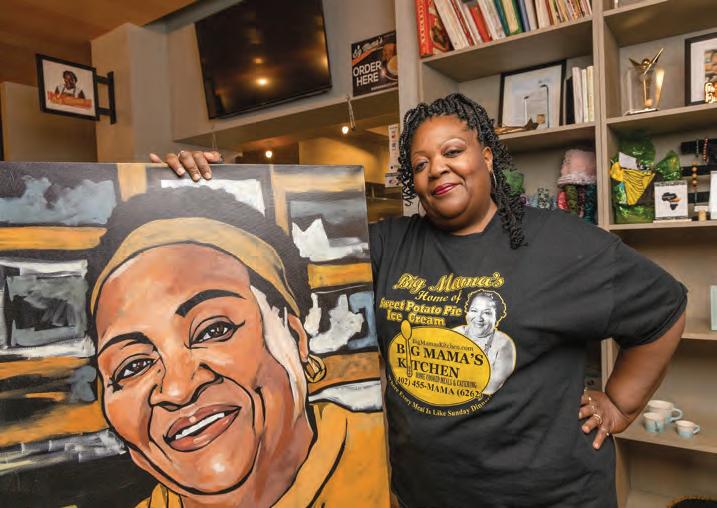





recipes
and photographs by
DANELLE McCOLLUM
NEBRASKA’S WARMER DAYS are back, and with them yardwork is back, too. After toiling in the sun making garden beds, raking leaves, planting flowers and pulling weeds, turning on the oven isn’t appealing. But what to do about dessert for weekend company on its way? Here are three easy no-bake treats to the rescue. From a citrusy mousse to black forest cookies, they’ll be sure to end the day on a sweet note – and a cool kitchen.
Thinking of throwing a package of Oreos at the kids and calling it good? With a little extra effort, it’s possible to use these beloved cookies to create a sublime dessert with layers of creamy and crunchy complexity. This fun dessert gets extra points for being handheld.
With electric mixer, beat cream cheese and butter until light and fluffy. Stir in vanilla. Gradually beat in powdered sugar until smooth. In separate bowl, beat heavy cream until stiff peaks form. Fold whipped cream into cream cheese mixture.
In microwave safe bowl, melt chocolate at 50 percent power until smooth. Dip the top of each waffle cone into the chocolate, then into the cookie crumbs to create a rim. With spoon spread thin layer of chocolate inside waffle cone. Place cones on parchment lined baking sheet to set.
Fold remaining Oreo cookie crumbs into cheesecake mixture. Spoon or pipe cheesecake filling into each cone, then top with desired garnishes. Refrigerate until cheesecake is set, about 2 hours.
2 8-oz pkg cream cheese, softened
1/2 cup butter, softened
1 tsp vanilla
2 cups powdered sugar
1 ½ cups heavy cream
12 oz chopped chocolate or chocolate chips
1 ½ cups crushed Oreo cookie crumbs
12 waffle cones
Ser ves 12

This light and refreshing citrus dessert comes together in a snap. Serving it in elegant dessert ware – or even sparkly jelly jars – adds extra polish, as does a fresh lime garnish. Tart and tasty, it’s particularly well-suited to balance the palate after barbecue or a spicy meal.
In small bowl, mix together graham cracker crumbs, sugar and butter. Divide crumb mixture evenly between 8-12 small dessert glasses. With electric mixer, beat cream until stiff peaks form. In separate bowl, whisk together sweetened condensed milk and lime juice until smooth. Fold lime mixture into whipped cream until well blended. Pipe or spoon mixture over graham cracker crumbs. Refrigerate until serving. Garnish with fresh lime wedges, if desired.
2/3 cup graham cracker crumbs
2 tsp sugar
2 Tbsp butter, melted
2 cups heavy cream
1 14-oz can sweetened condensed milk
1/2 cup key lime juice
Ser ves 10-12
Guests will thrill at this clever concoction. Store-bought chocolate wafer cookies take on new depths of flavor when stuffed with sweetened cream cheese and cherry pie filling. A drizzle of chocolate ganache on top provides a rich polish. This flavor blast tastes like a combination of ice cream sandwiches, cherry cheesecake and chocolate-covered cherries.
With electric mixer, beat cream cheese, powdered sugar and almond extract until smooth. Spread 1 tsp cream cheese mixture onto a chocolate wafer cookie. Top with 2 tsp cherry pie filling, followed by another cookie, to form a sandwich. Place on parchment lined baking sheet. Repeat with remaining cookies and filling.
Place chocolate chips in small bowl. Heat cream in microwave, or small saucepan, until just boiling around edges. Pour over chocolate chips, and whisk until smooth and shiny. Drizzle chocolate over cookies. Refrigerate at least 2 hours before serving.
4 oz cream cheese, softened
1 Tbsp powdered sugar
1/4 tsp almond extract
1 9-oz pkg chocolate wafer cookies
1 cup cherr y pie filling
1/2 cup semisweet chocolate chips
1/4 cup heavy whipping cream
Ser ves 16
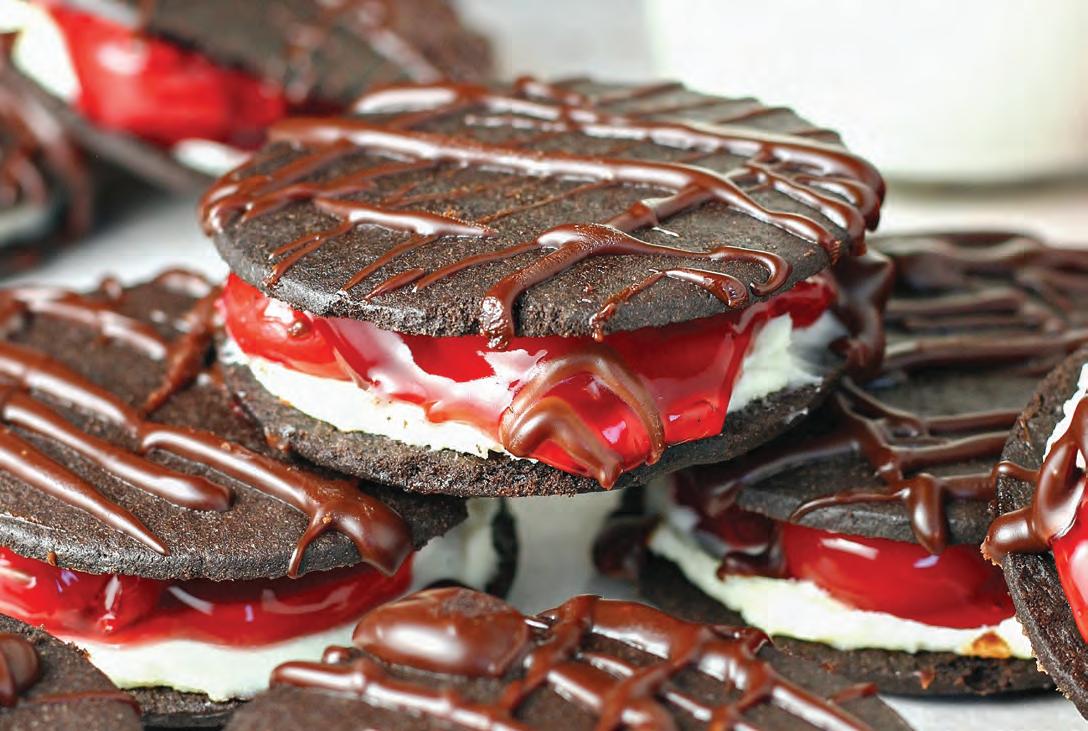
Won’t you dish with us?
We’re ravenous to taste your favorite family recipes. Nebraska-sourced ingredients and stories that accompany beloved dishes feed our stomachs and our souls. Please submit by emailing kitchens@nebraskalife.com, and thanks!

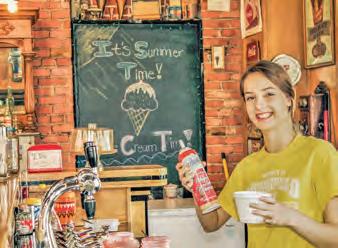







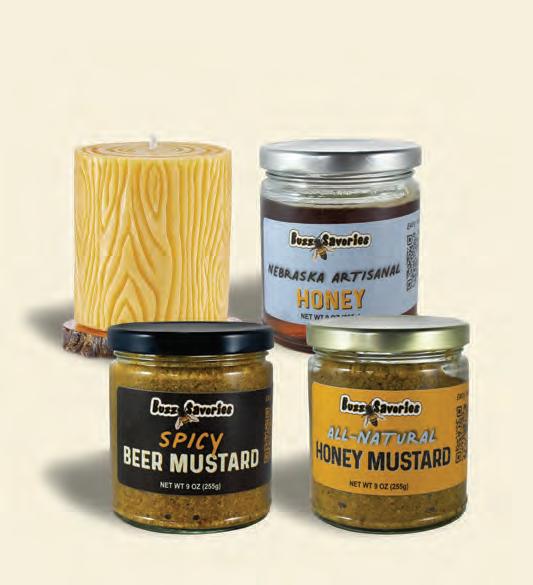
and































NEBRASKANS EMERGE FROM their homes to celebrate life together. They remember those they’ve lost with walks to memorialize beloveds, or they recall memories after smelling a particular flower. Nebraskans admire how much the children have grown since last they saw them, and they dance deep into the warm nights. How good it is to gather again.

Judy
Lorenzen, Central City
After a long dreary winter, these bushes –my old aunts –perfume the air and visit Mother, bringing back memories of old times –in deep purple flowers.
Kim McNealy Sosin, Humboldt
We look out the window first thing in the morning on the long-designated spring day.
Storm clouds, rain, wind? Or will we walk arm-in-arm through our Nebraska town bathed in warm sunshine?
We meet at the City Square bandstand, the new one over 60 years old, not the historic 1812 rotunda centering the park. Without thinking, we walk towards the beautifully flowered Cancer Garden.
Just a slip of a woman who punched way over her weight class! Her community, all family and neighbors, each spring in Humboldt gather to walk for, give for the future of others in her memory.
With so much to talk about in so little time, during their once-a-year visit, their remembrances bloom in clusters of laughter, their nostalgic fragrance my sisters and I can’t get enough of.

Boyd Bauman, Overland Park, Kansas
Before I’d ever heard of counterculture, Greenwich Village, absinthe, art movements, beatniks, hashish, or Haight-Ashbury,
Dad drove us across the border into Southeast Nebraska to what he called Little Bohemia where, spurred by crop failures and the Homestead Act, the roaming poor and huddled masses made the Cornhusker State #1 per capita in Czech migration,
where, nestled into villages, a church or community hall in the baroque style stands sentinel like the Zapadni Ceska Bratrska Jednota Hall outside of Dubois, where some Saturday nights immigrants journey from their farms to gather before the small stage a few feet above the wooden floor as the ancient musicians tune instruments, swig furtively from flasks.
My plump Aunt Emma and bow-legged Uncle Shorty gingerly make their way to the center of the dance floor, hold each other closer than I think permitted for a farm couple, rock slightly so that his right leg, her left are raised and ready, then on the downbeat of the accordion’s opening salvo, spring across the floor,
his bolo tie bouncing off the buttons of his overalls, her conservative blouse billowing, modest jewelry sparkling in the halcyon lights
and they are free of their bonds, society’s strictures and the mortal coil.
They whirl in the Bohemian night.
Duane Anderson, La Vista
Father, mother, brothers, sisters, cousins, aunts and uncles, grandmothers, grandfathers, gourmet potluck meals, hugs and hellos, minds downloading photos into long term memory. Look at you, my how you have grown.
Nancy Rutar, Grand Island
Listen…
Twilight is falling on the lake, And the musicians are tuning up.
A bullfrog bass clears his throat, While syncopated crickets harmonize With the cicada chorus.
Fish tails keep time as they slap the water, And the horned owl conducts From his treetop podium.
Purple martins gather on their porches
To gossip before it’s dark, And occasional mosquitoes whine off-key.
Neon fireflies flicker against the cobalt sky
As they turn on their lights
To illuminate the festivities.
Listen.
NEBRASKA LIFE IS seeking cowboy poetry, narrative poems and ballads. We’d like to see a full story written in verse. Poems set in specific Nebraska places are preferred. Feel free to send along photos, too. Please send to poetry@nebraskalife.com or by mail to the address at the front of this magazine.




Begay Starry Night Pueblo inlaid pendant




Early March 1912, young Walter Newell left Pender, Nebraska, to join his father’s horse and mule trading company on the annual trek west, up through Montana. But he ed the company in Dodge City, after killing a man in self-defense. It would take 10 years to nd his way home to Thurston County, to pursue his dream of farming Indian lease land. He was successful until 1933, when the Depression and drought nearly took it all.
He was a self-reliant man, secretly juggling his love for two very different women. Stoic and fearless, he joined a covert Secret Service/ FBI mission and became the key to nullifying Nazi intelligence efforts in the US before World War II.
Walter Newell’s extraordinary life is the inspiration for the historical novel The Lantern, written by Walt’s son Frank. (In the book, names have been changed to protect family privacy.)




by TIM TRUDELL
VÄLKOMMEN TILL DEN sanna svenska huvudstaden Nebraska. That’s Swedish for Welcome to Nebraska’s True Swedish Capital. The question is: Where is it? Two towns claim the title.
How’s it possible to have two Swedish capitals of Nebraska? It began in 1966, when then-Governor Frank Morrison, a Swede himself, proudly proclaimed Stromsburg as the “Swede Capital of Nebraska.”
Stromsburg embraced the distinction with pride. As people drive along U.S. Highway 81, passing by the town square, a sign displaying the Swedish flag of a yellow Nordic cross on a blue background proudly welcomes them to the “Swede Capital of Nebraska.”
Meanwhile, about 100 miles to the northeast, Vikings of Oakland took notice. Their town of about 1,200 was founded in 1863 as a community for Swedish immigrants. Stromsburg, on the other hand, was established in 1872 by people moving from Illinois.
Thus, Jeff Troupe, then a young businessman from Oakland, served on a statewide business committee and believed his hometown was the true Swedish capital of Nebraska. So, he set out to rectify the situation. In 1987, then-Governor Kay Orr signed a proclamation recognizing Oakland as the “Swedish Capital of Nebraska.”
So, which town is the one and true Swedish/Swede Capital of Nebraska?
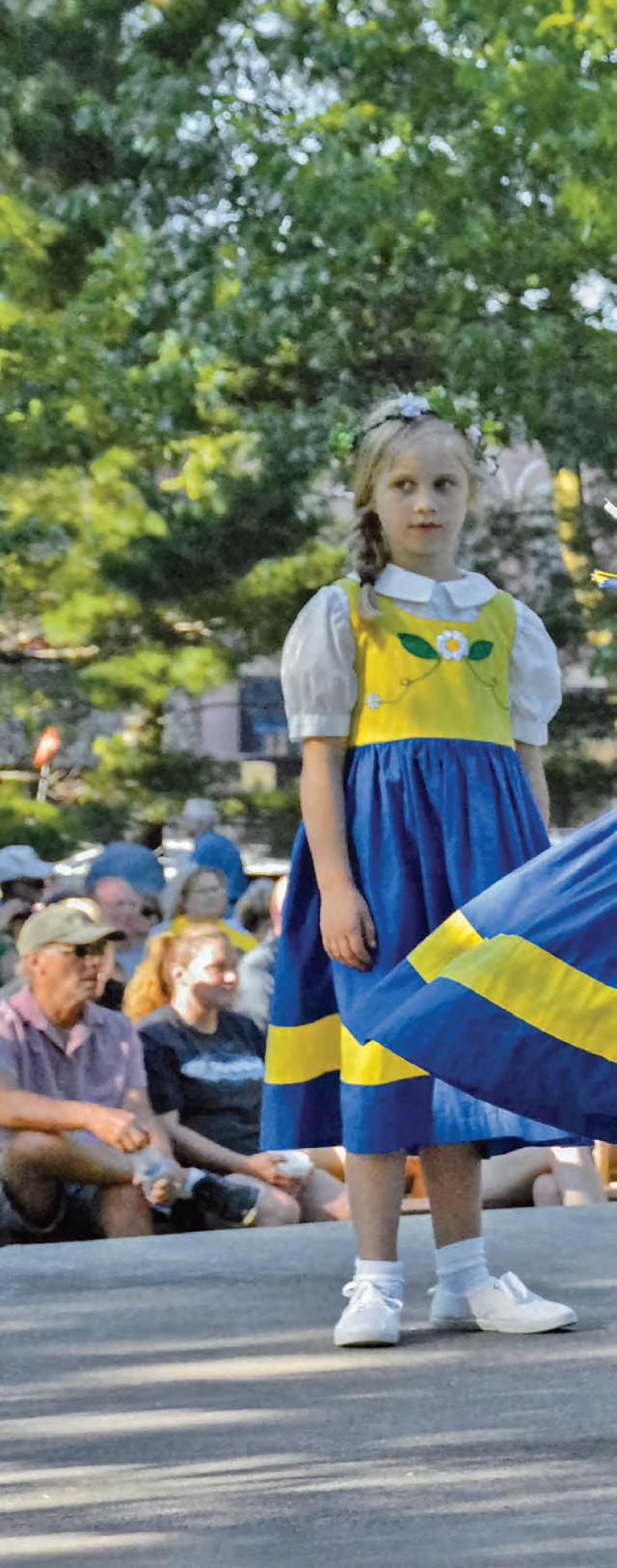
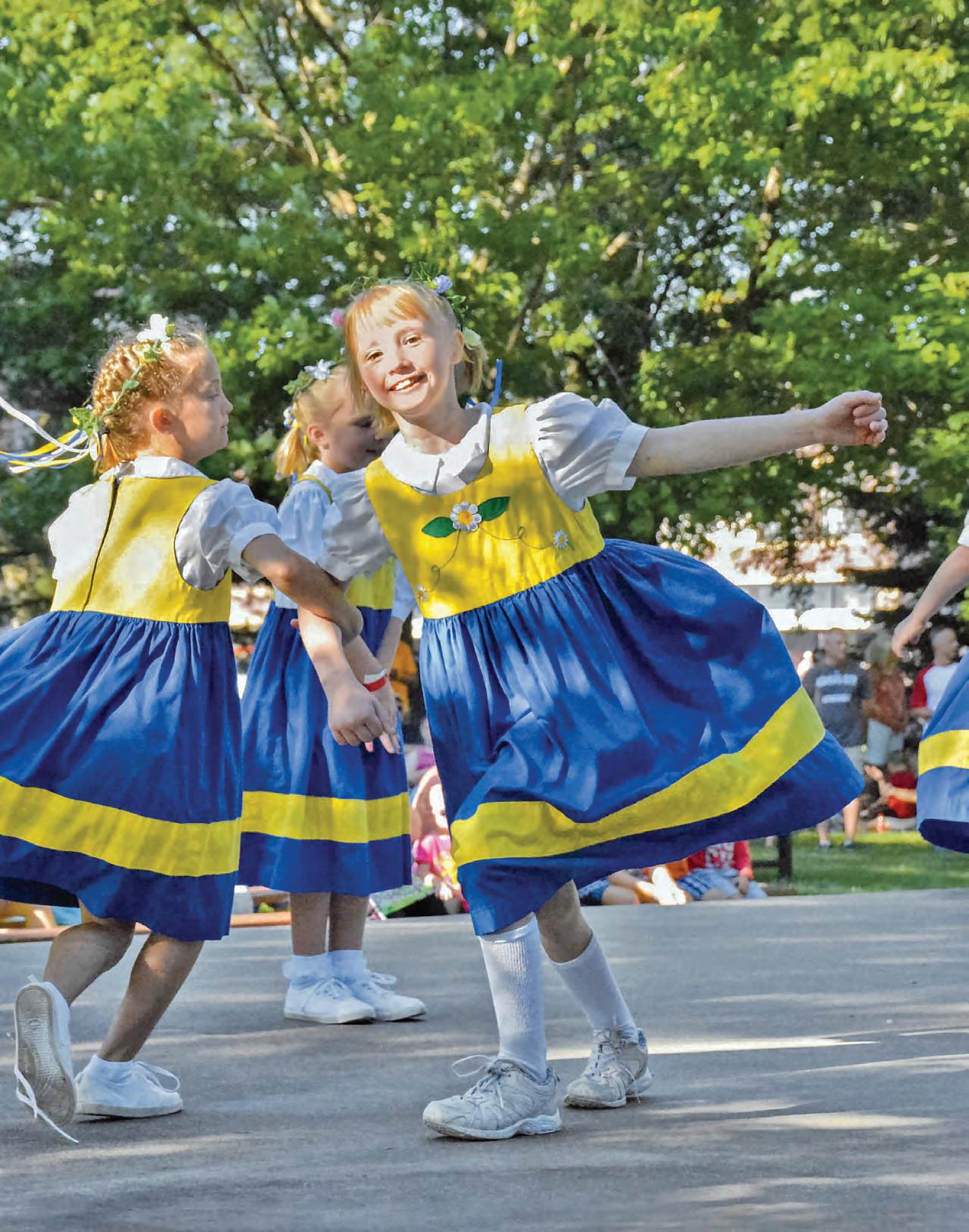
Stromsburg’s Swedish Midsommar Festival is a tradition, but there’s another Nebraska town that grabs the viking by the horn.
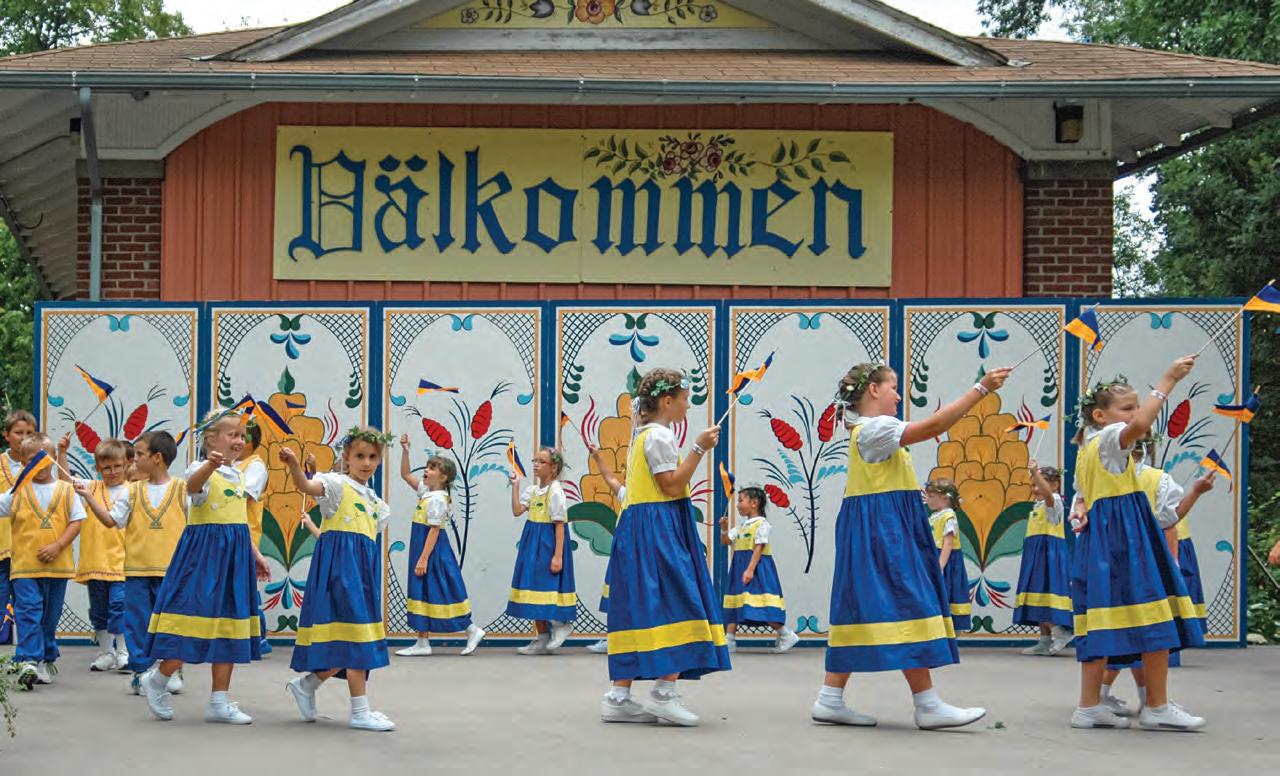
If it’s based on festivals and parades, Stromsburg may be the winner, whose annual celebration attracts up to 3,000 people. But, if it’s based on the number of Swedish names in the town, Oakland likely scores the victory.
“You can open the phone book and still find plenty of Andersons, Swensons, Olsons, Nelsons, and Johnsons in it,” Troupe said.
Since Swedish cuisine plays a large role during holiday celebrations, could that be the determining factor? Residents of both communities recall enjoying a traditional Swedish smorgasbord of cold and hot meats, cheeses, pickled herring, sardines, pate, meatballs, potatoes, and even lingonberry sauce and jam. Some tables had all the fixings.
How does one determine the true Swedish capital? Here’s a closer look at each town’s claim.
Oakland’s claim as a Swedish community dates to 1863, when John Oak helped Swedish immigrants settle their homestead claims. One of the men he’s believed to have helped – Victor Colson – settled just north of town, along U.S. Highway 77.
A small rock cabin and water well showcase the property. The immigrants ironically named their Swedish Community after Oak, a Norwegian.
Oak’s own cabin was located closer to Tekamah, about 14 miles east of Oakland on Highway 32. Millicent Troupe, Jeff’s mother, acquired some of the original logs, which are displayed at a gazebo in the town’s park. Jeff helped the Oakland Lions Club build that gazebo in 1986. Ear-
lier, Oakland educators and others built a picnic shelter on the east side of the park. At Nelson’s Food Pride, Julie Nelson Johnson carries on the tradition of stocking Swedish goods as the store’s third-generation owner. Her grandparents, Gust and Julia Nelson, founded a store more than 100 years ago. Johnson’s parents took it over in 1961. Julie bought it in 1989 and changed the name to Nelson’s Food Pride in 1998.

Beginning her Swedish food prep at about 6 a.m., 26 loaves of fragrant Swedish rye and six loaves of aromatic slightly camphoraceous cardamom bread are baking by 9:30 a.m. After letting them cool, Johnson slices them and has them ready for customers shortly afterwards.
While Johnson enjoys a slice of a good ostkaka (Swedish cheesecake), she’s not a fan of making it.
“It’s a time-intense dessert and takes a special knack to make,” she said. “It takes about six hours of prep before you put it in the oven. You have to separate the whey from your curds. With pasteurized milk, it doesn’t curd like the old days. I’ve had people tell me they want to make their own. I tell them, ‘good luck with that.’ ”
Oakland’s Swedish heritage extends past the grocery aisles. The Swedish Heritage Center provides a look into the town’s history through exhibits and displays, such as traditional wedding gowns, Oakland High School memorabilia, and heirlooms donated by locals.
Opened in 1989, the museum is in the former First Covenant Church, which closed in 1985. It stood empty until community leaders, including Jeff Troupe, thought the building would be perfect to tell Oakland’s story and host community events. Church leaders agreed to sell it for $1.
The heritage center’s foundation hired Elsie Sebberson as the center’s curator. Wearing a traditional folk outfit, the retired country school teacher greeted visitors to the Swedish Heritage Center that she managed until 2001.
The heritage center closed in the early 2000s and remained closed until 2015, when an Oakland native felt a calling to return home and reopen it. Tom Wallerstedt, a retired florist, was immediately drawn to the idea of reorganizing the center and acting as its curator. Wallerstedt continually designs exhibits’ layouts. The heritage center has displays showcasing early Oakland homes, including a kitchen, dining room, and living room. Replicas of flags recognizing each Swedish province adorn a wall.
Frederick Valdemar (Val) Peterson, who served six years as Nebraska’s governor (1947-53), called Oakland home. He spent four years leading the federal Civil
Defense Administration during President Dwight D. Eisenhower’s administration (1953-57) before serving as ambassador to Denmark (1957-61). He later served as the ambassador to Finland from 1969 to 1973 during President Richard M. Nixon’s first term in office.
Oakland’s proclamation as the Swedish Capital of Nebraska came during a 1987 visit by Nils Larsson, the Swedish ambassador to the United States, and Governor Orr. Oakland has enjoyed a sister city relation-
ship with Hammenhog, a small village in the southeast province of Skane, since 1962.
Founded by Swedes as a destination for other Swedish immigrants, Oakland once had the area’s largest Swedish population and a plethora of Swedish-speaking churches, Troupe said.
“Oakland really started having Swedes coming here in 1863, and they kept coming,” Troupe said. “The reason they came, and the strength of the community, was the Swedish churches.”
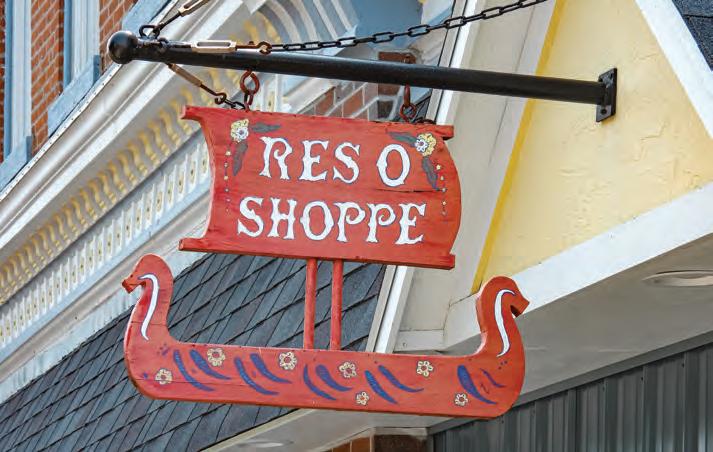
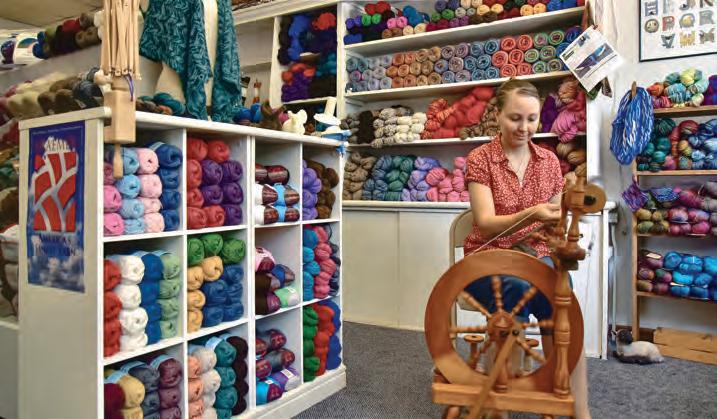
At top, even a thrift store in Stromsburg employs a Swedish touch. It’s a wonder there’s no sign saying, “No plundering allowed.” Above, many businesses, like this specialty yarn store thrive because Stromsburg attracts tourist dollars, especially in summer months.

Another reason that Oakland is the state’s Swedish capital is the sun, he said, referencing the location of Oakland in far eastern Nebraska.
“They always said the sun rises in Oakland, the noon sun is at Wakefield, and the sun sets at Wausa,” Troupe said. “No where is Stromsburg mentioned.”
FOUNDED IN 1870 and platted as a town in 1872, Stromsburg is named after Lewis Headstrom, a real estate agent who led a group of Swedish settlers to the area. With its downtown area built around a square, it became easy to develop the business district. Two local brick yards provided the resources for constructing some of the downtown buildings. The Viking Center, a community meeting space, still has some of that brick.
Charles Morrill of Morrill Hall fame at the University of Nebraska-Lincoln called Stromsburg home. He established a homestead south of town. The house he built is still located on the property. Aronia berries, AKA chokeberries, are grown on the farm today. The remnants of a concrete cow stand near the store. The cow
was part of a larger set maintained by the Morrill family.
With a nearly full business district, residents appreciate the progressive leadership of city leaders.
“They’ve kept things going. They’ve kept the buildings up. Turnover of businesses is low,” said Charles Noyd, who runs a heating and air conditioning business. People want to come back, he said, as evidenced by at least a third of his high school graduating class moving back in the last three decades. “I have never felt the draw of moving anywhere else.”
With buildings painted and adorned with designs reminiscent of Sweden, Stromsburg Mayor Ken Everingham credits tax credits for community development. The city was among the first in Nebraska to take advantage of the TIF (Tax Increment Financing) program to redevelop downtown buildings. It has led to new business, while also improving existing buildings.
Stromsburg Swedes don’t need to go far to satisfy their appetites for traditional foods, such as potato bologna, lutefisk, Swedish meatballs, and pickled herring.
Larsson’s Dala Butik, inside the Economy Hometown Market, features a collection of Swedish gifts, such as coffee mugs and candy. Opened since the 1920s, Economy Hometown Market has expanded twice over the years. As customers roam the store, they find Swedish phrases on the walls.
Stromsburg is home to several unique businesses, such as The Fiber Mill. Kelsey Patton runs the state’s only custom fiber mill, taking sheep’s wool, alpaca fleece, and even bison fur and processing it into fiber used for knitting. Patton serves customers across the country.
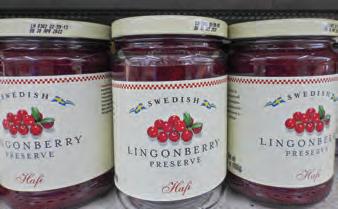
As visitors stroll around town, they often find decorated wooden dala horses as a way to promote the town and its heritage. Whether it’s a business or community event, visitors to the Swede Capital of Nebraska can sense the ethnic pride.
For almost 70 years, Swedes and Swedish wannabes converge on this Polk County town, growing its population by up to 3,000 for the annual Swedish Midsommar Festival in June. With food, music, dancing, games, and a parade, the three-day event attracts people from across Nebraska and the Midwest.
Festivalgoers can sometimes go a little overboard in displaying their community pride, Charles said. A group of people from Wausa brought a viking ship float to the festival once during the 1980s.
“They stopped at the Legion club for drinks afterward,” he said. “When they came out, the float was gone.”
After filing a report, local police found it the next day, parked on a side street. Turns out some Stromsburg Swedes pulled a prank and stole it. The Wausa Vikings took their ship and went home.
Hijinks aside, the Swedish Festival represents community to a lot of people, said Sharon Noyd, one of the festival organizers. “Alumni who don’t live here still come back at festival time, because they want to show their kids where they come from,” she said.
One alumnus took decades before returning home to “retire.” Following more than 40 years as an architect and community developer, Bob Berggren returned to Stromsburg in 2010. Instead of retiring and enjoying life from his front porch, he bought a bed and breakfast inn, a former hospital. He can point to the spot where he was born – where the doctor just happened to be George Flippin, the first African American football player at the University of Nebraska-Lincoln.
Berggren also owns the Anderson building downtown, home to an antique and home decor store, as well as a wine tasting room. Berggren knows that’s a lot to take care of in retirement. “My roots are here,” Berggren said. “I’ve always loved Stromsburg. I love my hometown.”
While Swedish pride runs deep in Stromsburg, a historic site in Sweden struck at Charles’ heart. He was on a twoweek trip when his tour guide walked him
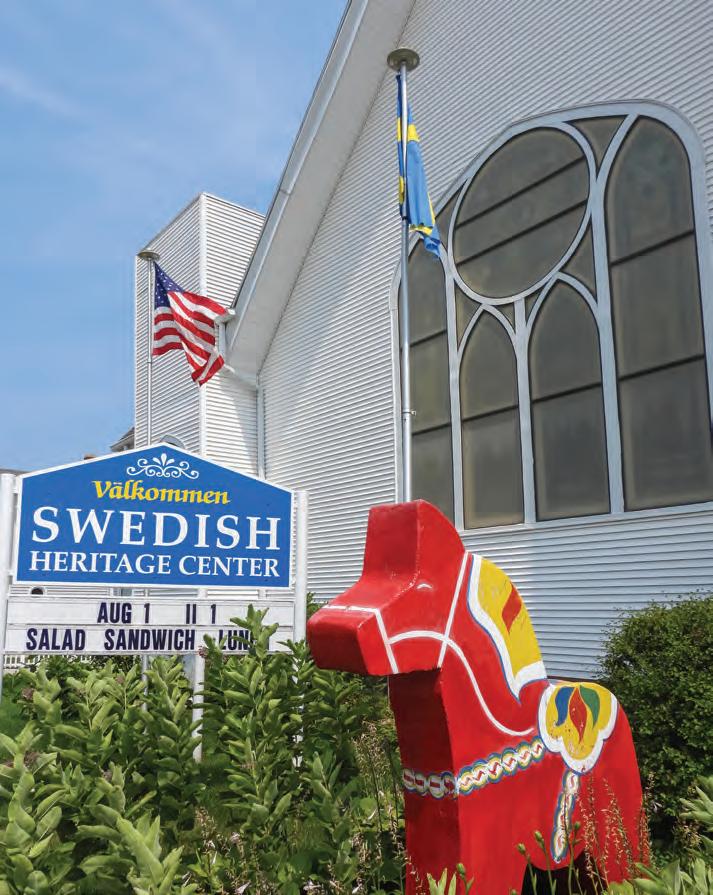
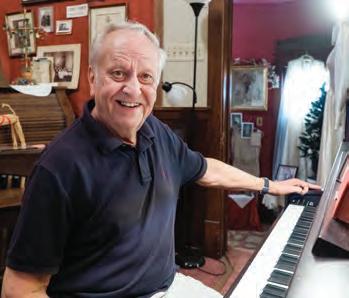

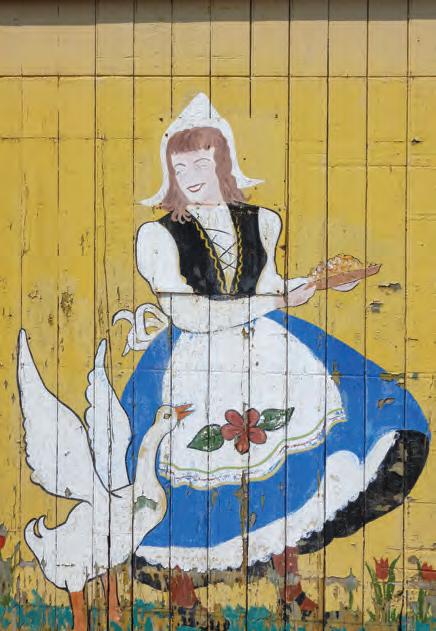
to a clearing in the woods. Charles didn’t know where they were going.
Then Charles saw stones. The guide told him it was the foundation of his ancestors’ cabin. The experience brought tears to Charles’ eyes.
“I stood where my ancestors lived,” he said. “That was an emotional day for me.”
While both Oakland and Stromsburg have worked diligently to lay claim to their status as the state’s true Swedish/Swede capital, other communities may want to challenge the titles. By zip code, Wausa has the highest population percentage with about 31 percent of Swedes in Nebraska, and ranks sixth nationally, according to zipatlas.com. Stromsburg ranks second in the state with about 30 percent and ninth nationally. Oakland is ninth in the state at almost 24 percent and 39th nationally.


Past governors have proclaimed the two cities as the Swedish and Swede capitals, respectively. Perhaps Wausa should have the governor’s office on speed dial?

• Homemade Swedish Potato Sausage
• Swedish Rye Bread
• Cardamom Bread
• Herring
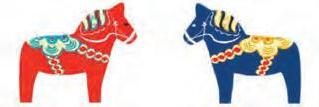
• Kummin Ost
• Swedish Meatballs
- Lutefisk
- Bond-ost
- Lefse
- Knackabrod
- Ostakaka

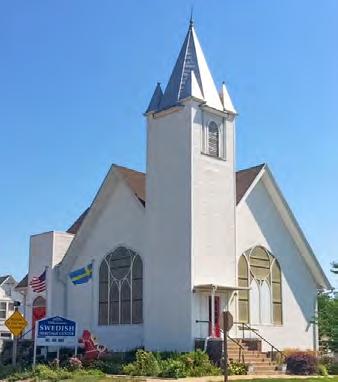

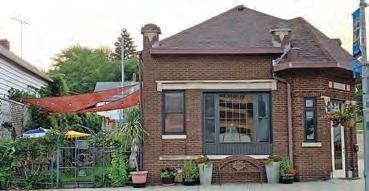



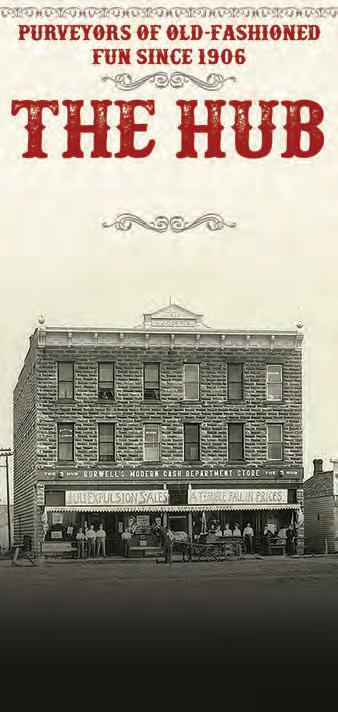







Cowboy Trail promises adventure, Nebraska hospitality and epic views

by BECKY McCARVILLE
TONYA PECK CLUTCHED her legs, writhing in pain and moaning on the side of the Cowboy Trail 20 miles west of Norfolk. As if the heat-induced leg cramps weren’t enough, she’d collapsed smack dab in a thicket of goathead stickers – and we were only halfway to our first day’s destination.
That morning our party of three 40-something-year-old women – Tonya, my sister Jennifer Miller and I – had set off from Norfolk on the 195-mile, five-day, four-night bike ride on the Cowboy Trail, one of the longest rail-to-trail conversions in the United States.
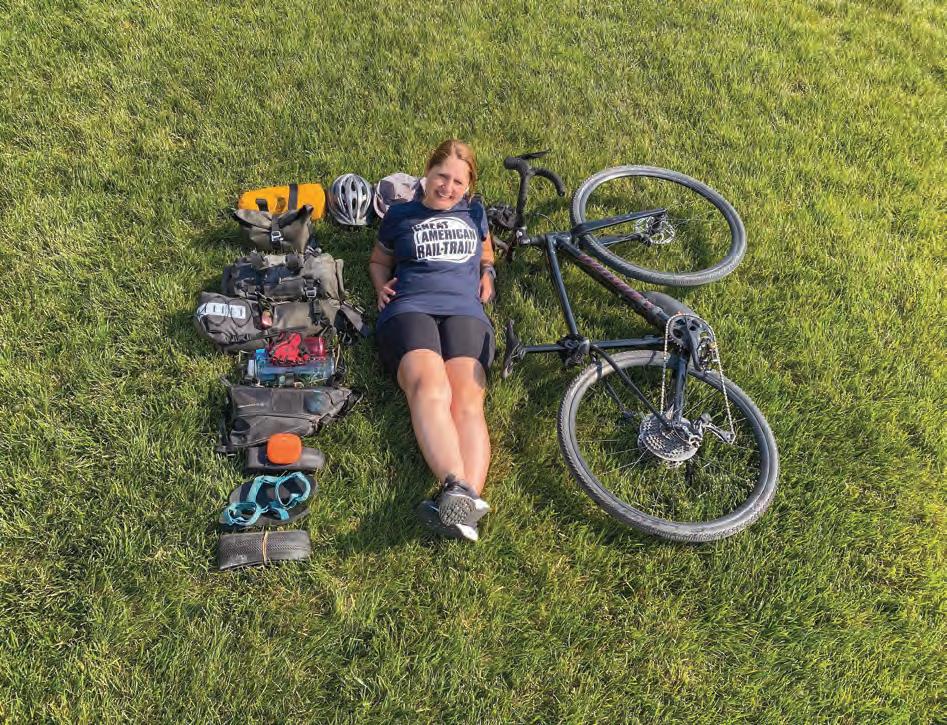
Our destination was Valentine, where we’d meet our families. But it wasn’t turning out to be the rollicking bikepacking trip we’d painstakingly planned and trained for over the past five months.
This wasn’t my sister Jennifer and my first rodeo. We’d ridden Cowboy once a few years earlier and knew that bikepacking can be a “suffer-fest,” because of the physical and mental challenges of hours of physical exertion while being exposed to wind, rain and heat.
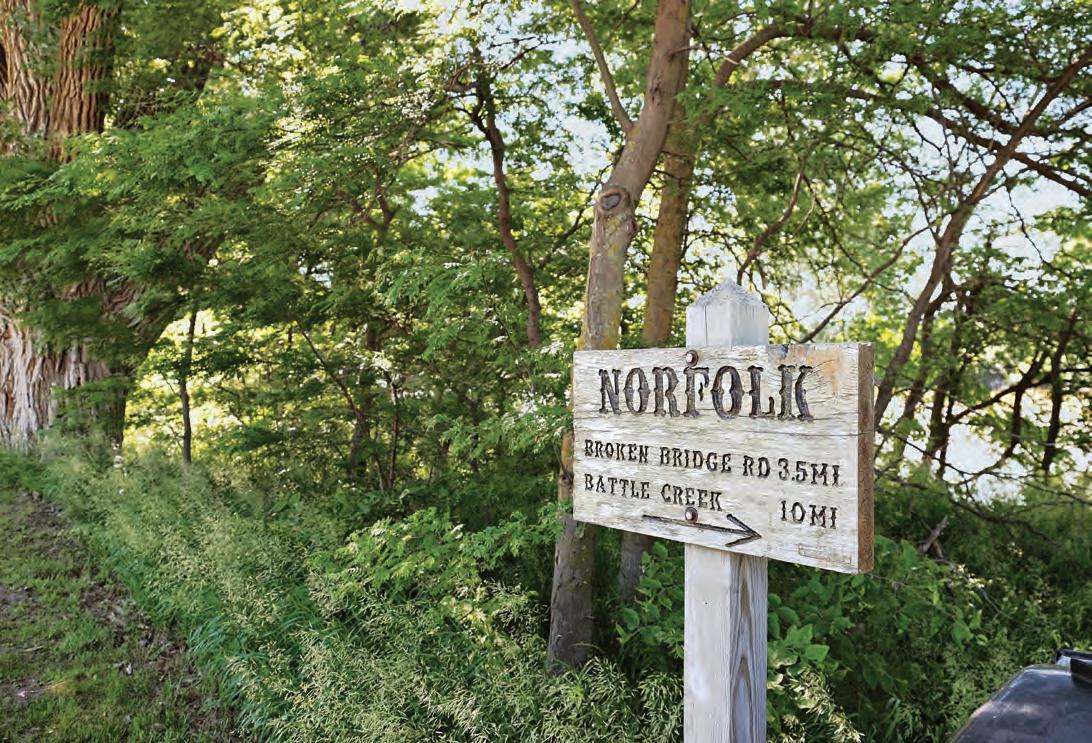
Still, the allure of a self-propelled, self-supplied adventure on a sparsely traveled Nebraska trail called to us again. Jennifer and I wanted to ride it better this time and share the journey’s triumphant crossing of the historic Valentine bridge with our friend Tonya.
Twenty-one Nebraska communities dot the former rail line. Each has their charms and amenities pulling weary travelers – and their tourist dollars – into the rural towns. On a good-weather day, a short casual ride on the Cowboy Trail is a simple task, but heat, distance and weight onboard can impose a physical and mental tax on riders like us.
On that first day of our trip, the heat was overbearing, the humidity stifling. The early-morning temperature soared into the 90s as we packed our bikes at a Norfolk trailhead with 30 pounds of gear each: camping equipment, extra tire tubes, clothes and food and water. It was only the first weekend of June, but it felt like the dog days of August.
The trees and shade along the Elkhorn River beckoned as we pedaled the first paved miles through Ta-Ha-Zouka Park, whooping and high-fiving while trying to balance our heavy bikes as we took selfies to commemorate the launch of an epic journey.
We rode past mulberry trees, then across the Cowboy Bridge spanning the Elkhorn River. This bridge, designed in the style of a trestle railroad bridge, replaced Broken Bridge, which washed out in a flood in 2010. It’s near Black Bridge, where Norfolk native Johnny Carson hung out as a teen and later made famous in his TV special Johnny Goes Home. We pedaled past Battle Creek and into Meadow Grove, about 17 miles in. We stopped for a breather under the shade of the tree-lined streets of the town square. The leafy cover was a welcome respite from the radiating heat of the trail.
Searching for a gas station with air conditioning, we met Meadow Grove resident Joy Griffith, who let us know
that the gas station and bar were currently closed but would open later that day. Our timing was off. Our gritty, sweaty faces mixed with trail dust and sunscreen, along with our loaded bikes led to a conversation about what we were doing and why, and to taking photos with Joy at the town’s mural.
Joy’s homesteader great-grandfather, PV Lewis, migrated to Nebraska from New York, making the journey with a group of members of The Church of Jesus Christ of Latter-day Saints headed west. He homesteaded a tract of land acquired with timber claim. He and his three young daughters would go to the river to dig up volunteer cottonwoods and plant them on land that became the town, Joy said. The Fremont and Missouri Valley Railroad established a station it named Meadow Grove, and in 1886, Lewis founded the village. Joy made it clear: Meadow Grove’s history and pride runs as deep as a well. She wished us good luck, offering her phone number in
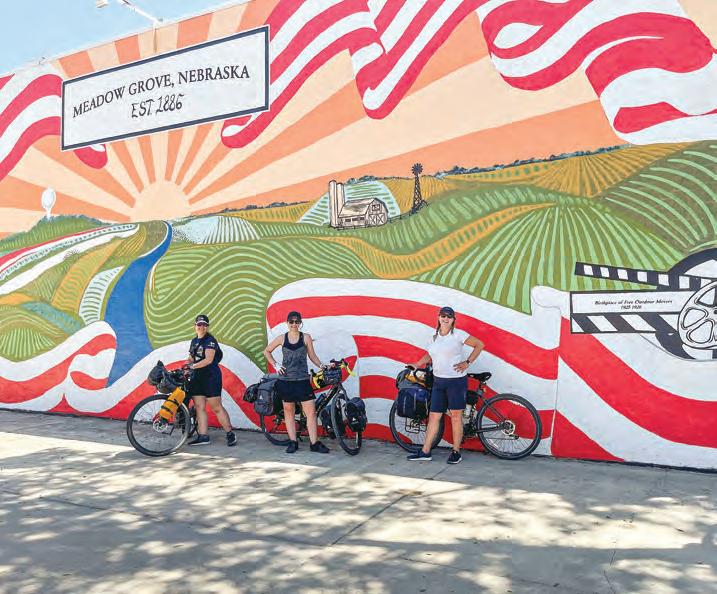
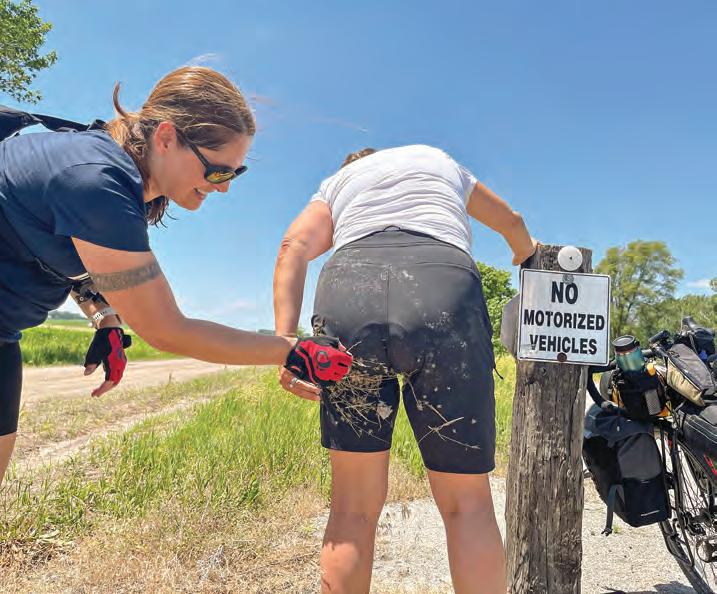
case we needed help. She told us to keep her updated of our progress. This type of community pride and kindness echoed in each town we passed through.
We headed back to the trail and pedaled west. Heat radiated in waves from the crushed limestone trail, conjuring a mirage of a lake in the distance. Soon Tonya’s legs began to cramp. Caused by dehydration and overheating, leg cramps can knock down even the most welltrained athlete. We were all conditioned, but when heat and human go head-tohead, heat often prevails.
At least we’d packed light this time, unlike Jennifer and my first trip on the Cowboy Trail when we had brought every comfort item we could strap onto our bikes, including an electric coffee maker. We were the bikepacking version of The Beverly Hillbillies, straw hat and metal cup dangling off the back of my ancient
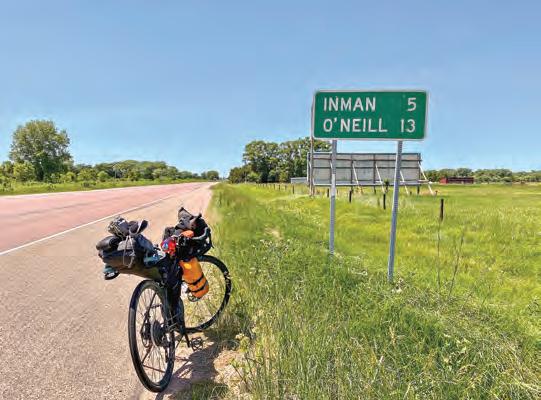
Smarter now, we’d planned individualized setups, complete with hybrid bikes and tubeless tires to help navigate the goathead thorns. Our gear reflected our styles: Jennifer’s streamlined front handlebar roll, top tube bag, frame bag and seat pack; Tonya’s svelte front rack panniers and a handlebar bag; and my stuffed-to-the-gills front and rear panniers and handlebar bag. My “what if” tendencies won out, but I made the tough decision to nix my daughter’s pink ukulele, figuring I’d be too spent at the end of a


ELKHORN VALLEY MUSEUM
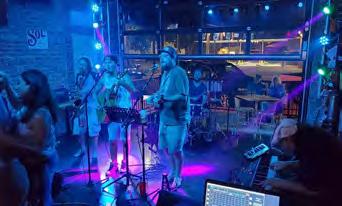
CONCERTS & LIVE MUSIC

It was the sisters’ second time bikepacking the trail. They learned from previous mistakes and left the coffeepot behind.

long day in the saddle to pluck the chords to “Mammas Don’t Let Your Babies Grow Up to Be Cowboys.”
Soon, Tonya’s leg cramps seized her. With no shade in sight, we took a break along the trail. In addition to heat exhaustion, Tonya got a butt full of thorns.
Jennifer and I tweezed clusters of offending stickers from her bike shorts as she stretched, rested, hydrated and tried to cool down.

We saddled up again. To keep our spirits light, we made up slogans like “Another One Bites the Dust on the Cowboy Trail” and “Don’t Let the Cowboy Trail Be a Thorn in the Chamois.”

We were over halfway to Neligh, the first stopping point, but we were still a couple of miles from Tilden. Even though the trail is less than a 2 percent grade, the oven-like heat made it feel like a mountain climb.
After Tilden, we encountered a trail closure and were forced to ride the highway shoulder into Neligh. Thankfully, the highway has wide shoulders, and drivers generally give cyclists a wide berth.
Dragging our bikes into Neligh, we made it to the Deluxe Motel, where owners Tim Kallhoff and Kate Anson were sitting under the shade of the large cottonwood tree. They warned us that storms were brewing with a promise of wind, rain, hail and possible tornadoes. Stubbornly sticking to our plans, we headed across the
street to the campsite to set up our tents, shower and look for a restaurant.
After a cold shower and trying to eat a few bites at Burrito Loco, Tonya still couldn’t cool down. She wasn’t acting like her typically positive self. We suspected she was suffering from heat exhaustion, which can lead to potentially life-threatening heatstroke. By this time, it was dark. The wind was picking up, the storm quickly rolling in. We called Tim and Kate at the motel, and they swung into action. Tim drove over in his truck, shining headlights to help us see as we hurriedly shoved our camping gear into the back of the truck.
Tim could have said, “I told you so,” but the twinkle in his eye and wry chuckle at our predicament was enough. Kate took care of Tonya, trying to help her cool off in the motel room. I talked with the charge nurse at Neligh’s Antelope Memorial Hospital throughout the evening, trying to decide if Tonya needed medical interven-
tion. At midnight, Tonya wasn’t better and one final call to the nurse made it clear she should go to the emergency room.
With only bikes for our transportation, the nurse took mercy and picked up Tonya, administered intravenous fluids at the hospital and brought her back to the motel around 3 a.m. Tonya’s husband would arrive in the morning so that she could recuperate at her home in Omaha.
Rallying around us, our trail angels helped us when we needed it the most. That night I knew that no matter what happened, we could count on the kindness of our fellow Nebraskans.
of our party down and facing humid weather, a 40-mile ride to O’Neill faced us on our second day. The previous night’s rain made the trail gravel slushy. Unfortunately, it did not provide much
relief from the heat. Jennifer and I chose to bike on the highway shoulder again. That’s when my suffer-fest began in earnest. Jennifer had trained more extensively than me before the trip. Her up-beat nature at first annoyed me – or maybe it was sisterly jealousy because of her fitness level and capacity to endure. We carried on in the face of 40-mile-perhour wind gusts until Ewing.
A lunch of salty fries and a sandwich at DW’s Pub improved my mood. We got a text that Tonya was starting to feel better. After lunch, we admired a mural depicting the airplane built by the seven Savidge Brothers. They were pioneers in the burgeoning aviation industry in the early 20th Century. Inspired by the flight of hawks, they built gliders, then a self-powered airplane, then went on to build at least 20 airplanes. The daring brothers barnstormed through the Midwest and developed a method of skywriting, but the family hung up their aviation
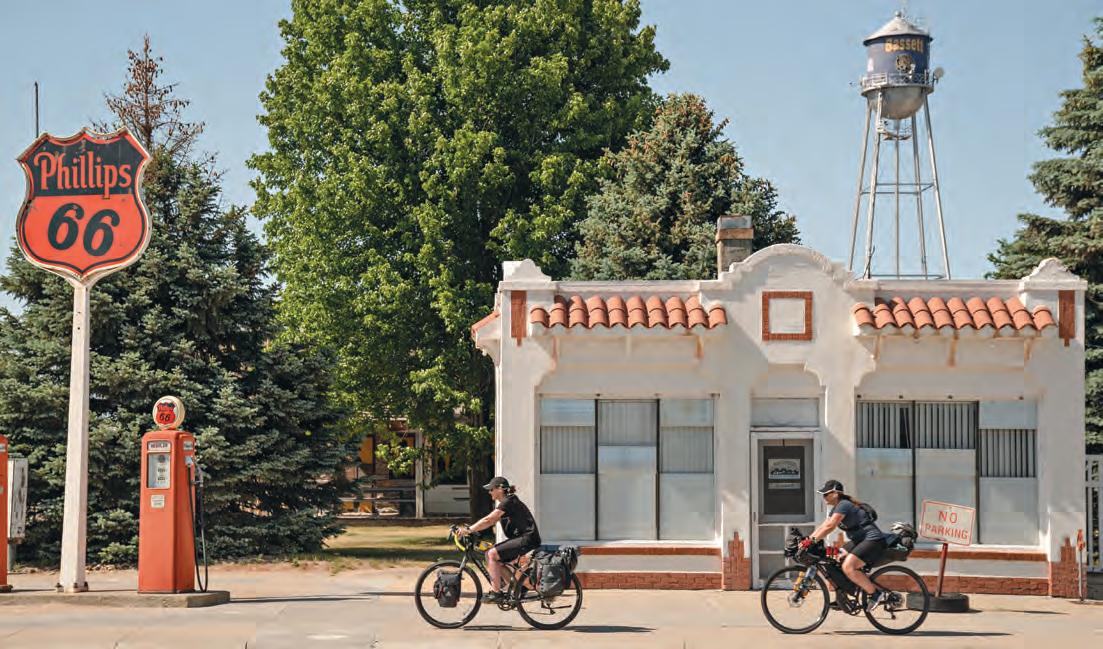

goggles after one of the brothers died in a plane crash in 1916.
The heat and wind continued to pummel us, but we found respite before rolling into O’Neill, “Nebraska’s Irish Capital.” We followed a little path from a trail bridge down to the Elkhorn River, dipping our toes in the swirling water to cool off.
In O’Neill’s downtown, we posed for bike selfies at the Blarney Stone and saw the world’s largest painted shamrock. Then we stuffed our faces with scratch-made deliciousness at Holt County Grill – the benefit of burning a gazillion calories. That night, we’d enjoy soft cotton sheets at our Aunt Teri and Uncle Kenny Petersen’s house before we set off on our biggest mileage day: 50 miles from O’Neill to Bassett.
ON OUR FIRST Cowboy Trail trip, this was the spot where Jennifer and I experienced tire punctures from goathead



thorns, every cyclist’s nemesis. Before that trip, we’d watched YouTube videos on how to change bike tires, then got our chance to practice in real life (over and over). This time, we were prepared with tubeless tires and tire slime.
After she punctured a tire (her only one on this trip), Jennifer expertly squeezed a bottle of slime through the tire valve. The tire sealant coated the inside of the tire, filling in the gash. With tires fixed, we rolled on through the prairie and its sweeping views.
Instead of camping at the fairgrounds in Bassett, where we’d plugged in the coffee maker on our first trip, we planned to rest in comfort at Bassett Lodge, built as a cattlemen’s hotel in the 1950s.
From the moment we pulled up to the metal wagon wheel fence and into the straight-from-1950s furniture and decor, we knew we were in for a memorable experience. The Range Cafe, a ’50s-style diner at the hotel, was closed due to

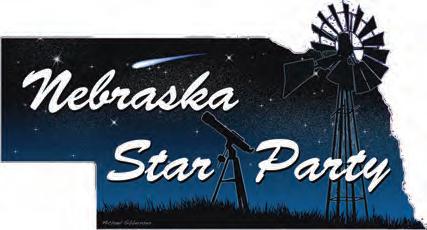
Covid, but Allen’s Pizza Place down the street tasted like a home-cooked meal. Bassett Lodge isn’t the only nostalgia-fueled destination in town. Travelers can take photos and remember by-gone days at the restored 1930s Phillips 66 gas station. Reminiscing about past trips and planning future adventures, we were happy to hear of Tonya’s full recovery.
WEST OF O’NEILL, the landscape changes subtly from leafy trees and crops to arid pastures and gently rolling hills. It’s cattle country here, and cowboy hats and boots are seen more than tennis shoes and spandex. I had never noticed the changes in Nebraska’s landscape as I zoomed by in a car, with only the endpoint in mind. But slowly riding through on a bike makes it personal.
From Bassett we rode the highway to Long Pine to avoid goatheads and a trail

closure, then meandered our way to Long Pine Bridge, drinking in spectacular views of the pine forest as vacationers tubed the creek 115 feet below. Long Pine once was a thriving railroad town and a tourist destination because of its Hidden Paradise resort. A splash in the creek among pine trees sounded amazing, but
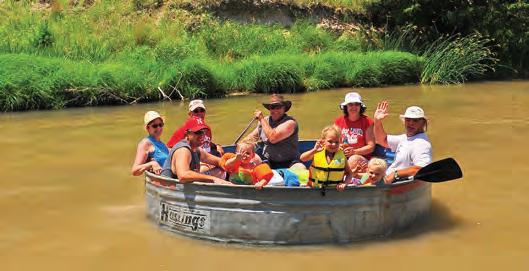





we had to keep moving.
Between Ainsworth and Valentine, there aren’t many places to stop. Packing essentials like water, snacks and meals are a must. We learned this the hard way on our first trip and underestimated how hungry we’d be.
From Long Pine we rode through Ainsworth, then stopped for refreshments at L Bow Room bar in Johnstown. Owner Ruth Trobee has welcomed local customers, tourists and travelers for 20-plus years. She’s part of the Cowboy Trail cycling lore, regularly chatting up customers at this famed watering hole, which from the exterior looks straight out of a Western-themed movie set complete with wooden sidewalks and hitching posts. In fact, part of the 1992 O Pioneers! movie was filmed in Johnstown. As the last pit-stop before we spent the night at the Wood Lake city campground, we double checked our water and food supplies before getting back on the saddle. Our Cowboy Trail adventure was winding down, but we anticipated seeing our families, and Tonya and her family, in Valentine.
For the most part, the trail follows alongside Highway 275 and Highway 20, but there are sections where the trail veers through fields and pastures and over creeks where it’s just you, the sky and the land. I was glad to be slowly pedaling through our state on our bikes, taking in the sights and sounds, out of highway traffic earshot, feeling small in the wide expanse of the prairie and sky. Yellow, pink and lavender wildflowers danced in the wind as I let my anxious thoughts and fears get swept away in the swirl of dust.
At Wood Lake, we set up our tents, our tiny camping chairs, prepared dinner, then explored the village. All was quiet. Occasionally a car would drift through. Walking along a dirt road lined with trees, we came upon an algae-covered lagoon on one side and a lake on the other. Fish bobbed to the reedy surface. Birds landed and took off. We had missed this natural wonder the first time we visited, even though it was just a few hundred feet from the campground. If we’d set out to do better this time around, here was one way to score it.
FROM WOOD LAKE to Valentine, the horizon opens to clear skylines as the trail slices through undulating hills across miles of prairie and pasture. It was our final 36 miles. Black flies swarmed and bit us in the heat. We stopped often to guzzle warm water and remaining bottles of Gatorade. The sun blazed down.
Finally, we made it to a slice of shade, parking our bikes under a cluster of cottonwood trees. It’s cattle country in Cherry County, and the large beasts watched us from pastures with what seemed to be curious stares. Cottonwood fluff caught gusts of wind, and turkey vultures rode the thermals. With 10 miles to go before we reached Valentine’s sweeping bridge, we dug in and listened to audio books, a welcome distraction from the heat and exhaustion we felt with every crank of our pedals.
We eagerly anticipated the “Welcome to Valentine” sign. Finally, we arrived. Elation replaced exhaustion. My fear of heights momentarily abated as we pedaled triumphantly over the historic, quarter mile steel and wood plank bridge,
then back again, stopping in the middle to take photos atop the 140-foot perch.
Miles of Niobrara River valley unfolded in shades of green, reminiscent of a painting. I was surprised to see groups of families and walkers enjoying the bridge views, but they didn’t linger because of the heat. This was the culmination of our trip, and as excited as we were to reach the bridge, we still had a few miles to go for our final stop at The Peppermill restaurant in Valentine.
The Peppermill is a destination for many cyclists on the Cowboy Trail – a place to sit, relax and toast another adventure. The ice-cold beer, steak and loaded baked potato were the perfect ending to bikepacking the 195 miles from Norfolk to Valentine. Both times we rode the trail, at least once I muttered under my breath or screamed into the wind, “I’m never doing this again,” but as we sat in the booth toasting each other, we were already laying out plans for a third excursion, perhaps from west to east, to see if we can ride it even better.

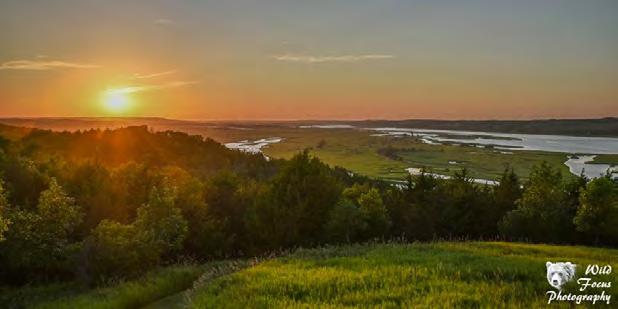
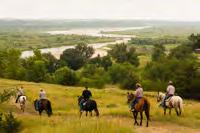

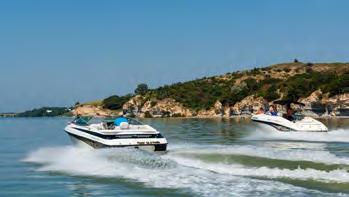
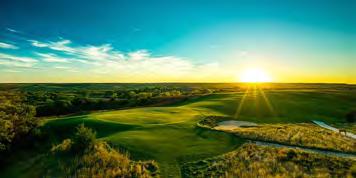
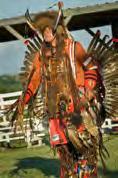
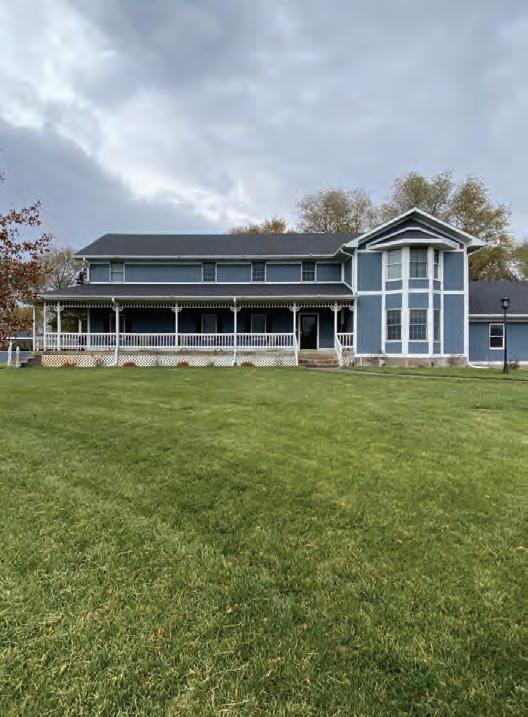



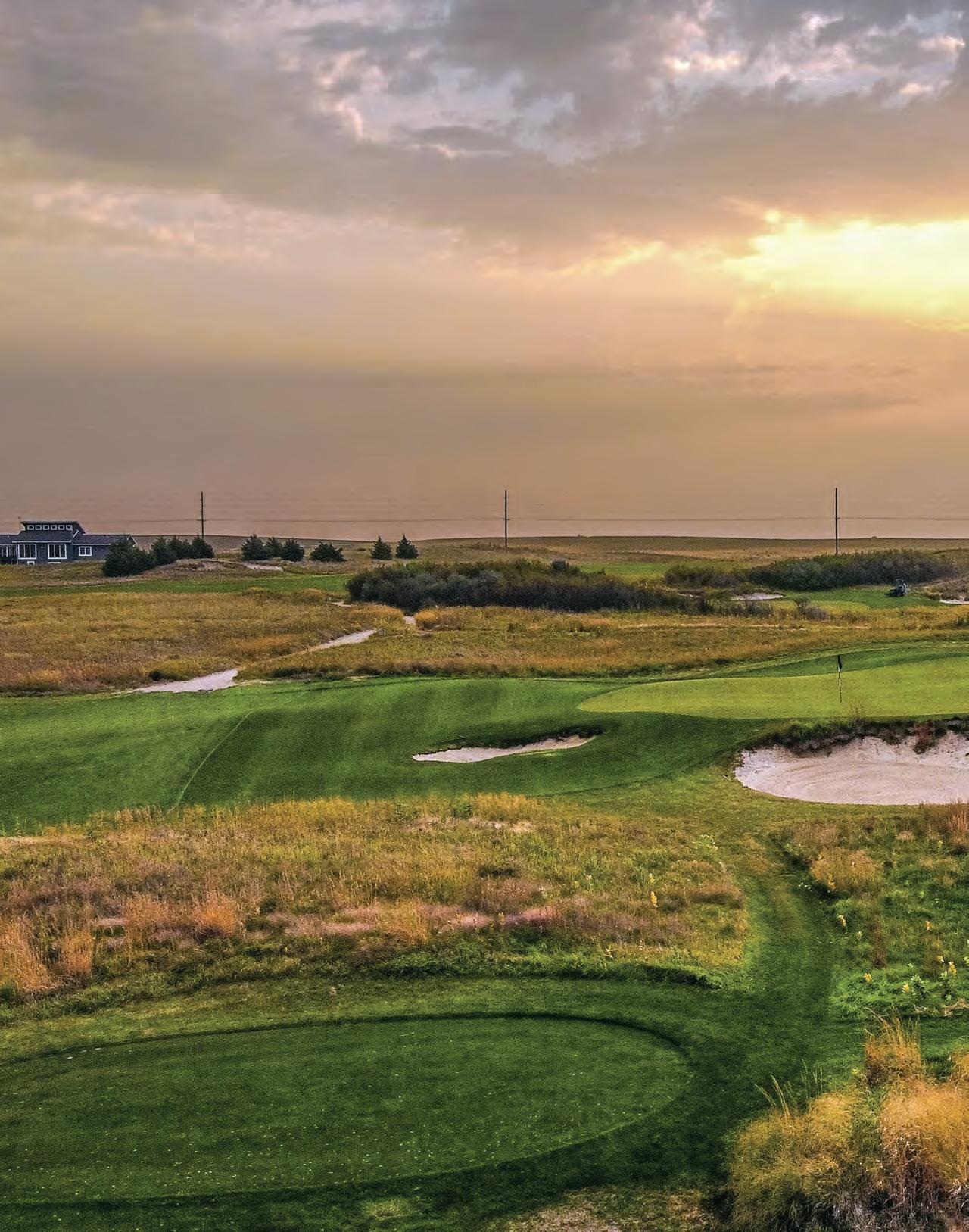
by TOM HESS
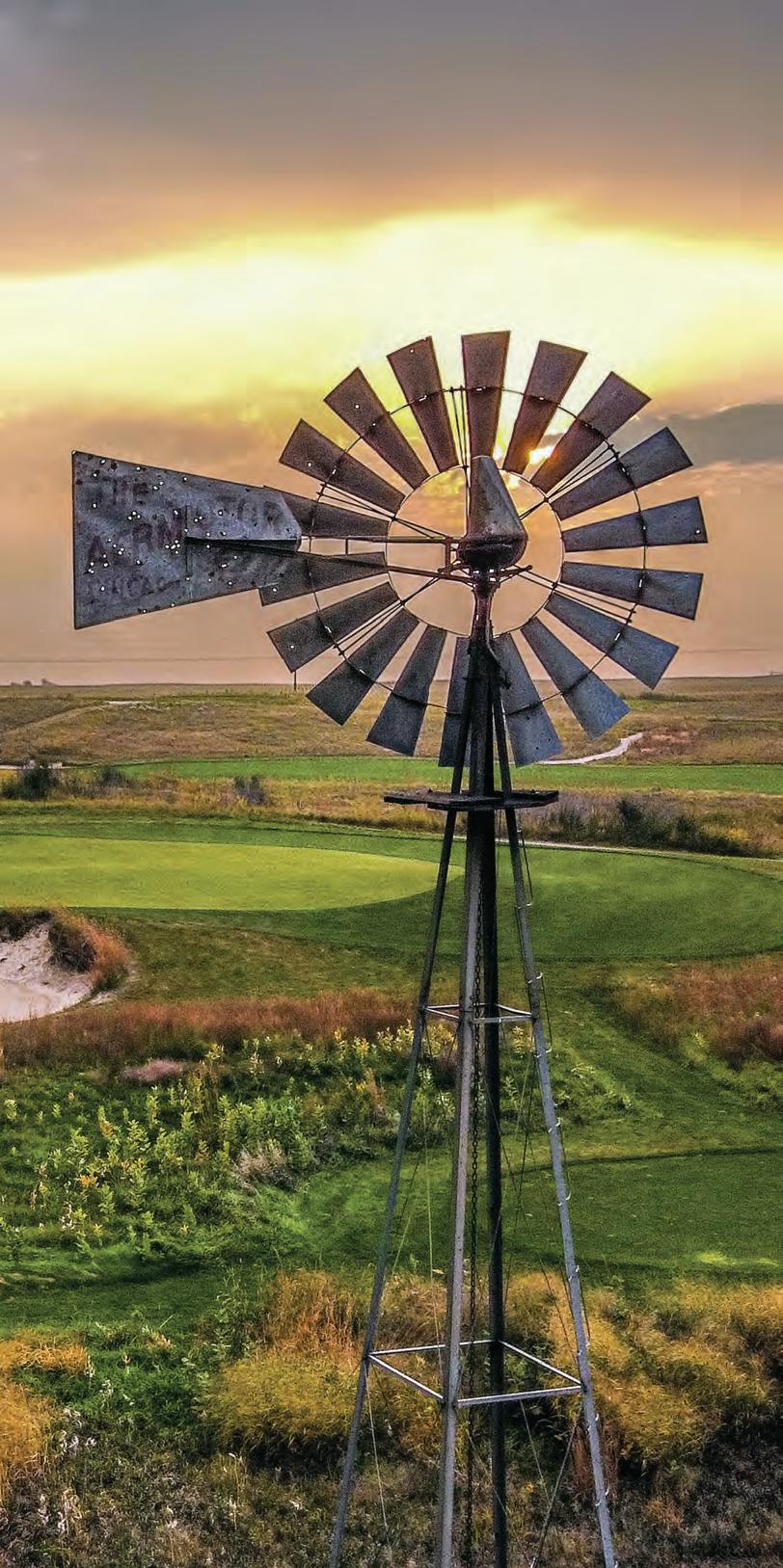
GOLF COURSES FROM midtown Omaha to the Panhandle offer more than scenic walks or sunset cart rides. Each course tells the story of its land and people.
MEN FROM EVERY corner of Gothenburg life – farmers, factory workers, shop keepers and retirees – built Wild Horse after they grew frustrated with sloppy conditions on the clay ground where they played on Monday nights.
One of the men offered land with sandy soil that would drain well. Two farmers with a John Deere and tillage disk, a backhoe and Smithco rollers volunteered their time and equipment to sculpt the sand. Community sweat kept costs low while creating an experience that draws national golf journalists from magazines like Golf Digest, which ranked the course one of the top 100 nationwide.
It also draws Nebraska celebrity comedian and voice of Cars cartoon character, “Mater,” Larry the Cable Guy. When he’s on the course, he’s always, “on” – cracking self-deprecating jokes about his putting ability.
Putting the super-fast greens at Wild Horse will shake the confidence of skilled and hack golfers alike – maybe poking a little fun at oneself, as Larry does, is the way to soothe the sting.
Dannebrog Golf Club, Dannebrog
THE COWS HAVEN’T shown up at Dannebrog for a few years now. That’s good news for Dannebrog Golf Club groundskeeper John Janulewicz. Mowing the fairways and the rough doesn’t chop up and fling manure on him anymore.
Fences still surround the square greens, a reminder that cattle once trampled the greens’ oil-soaked sands. The one circular green at Dannebrog is guarded by a 48-foot-diameter, 3-and-a-half-foot-high grain bin metal base. Dannebrog is one
of several so-called “sand” courses in Nebraska. “Green” courses, by contrast, reserve sand for hazards.
Nick Schweitzer, president of the course since 2016, said he’s played the nine-hole course “hundreds, maybe thousands” of times since his early 20s. He recalls shooing the cows off the course. Sometimes he just had to wait until they were ready to moo-ve on.
Built in the late 1920s, the course is famous for the Bullpen Open on the second week in August. Schweitzer says 120 people once used to show up to play in the Open – so many that players would still be on the course at nightfall. Car headlights illuminated the course so they could finish their rounds. Lately, 65 to 70 players participate, finishing in daylight.
Schweitzer said that putting on a sand green requires a firmer stroke, “a good poke.” Before putting, the player rakes the sand between the ball and the hole. Dannebrog once oiled the sand with motor oil, which left residue on the balls, and blackened players’ hands and shoes. Course management later switched to vegetable oil recycled from regional restaurants.
Field Club of Omaha, the oldest course on its original land west of the Mississippi River, crosses Woolworth Avenue in midtown Omaha four times. Ten-foothigh fences safeguard motorists, motorcyclists, bicyclists and pedestrians from an approaching golfer’s shot. Except when they don’t.
Course professional Kevin Drew said golfers’ shots shatter passing motorists’ windshields, front or back, six or seven times a year. One time a ball landed inside an open convertible. That didn’t count as a hole in one. Balls stuck along the roadway between the fences can be carried forward with the next shot played from the other side.
There are other challenges, too – blind shots, sand traps and southern wind. Desire for accuracy is heightened. (And drivers passing the golf course hope for golfer accuracy, too.)
The Omaha World Herald keeps a database of the course’s hole-in-ones – it averages 10-12 a year out of 24,000 rounds played.



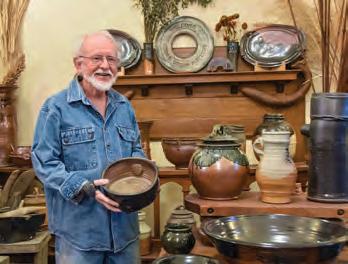
Featuring the work of Ervin Dixon, a country potter who makes and displays salt-glazed stoneware at his refurbished 1895 Lutheran church near Beatriceworth a day’s drive from any direction.
cups • mugs • glasses • plates baking dishes • vases • pots
Regular Hours | Mon-Sat, 10 am-5 pm
In June of 1922, acrobatic pilot Lt. Errold Grover Bahl of Humboldt landed on Auburn Country Club’s sixth hole fairway just as his engine quit. Aboard the plane was his ambitious passenger, 20-year-old pilot-in-training Charles Lindbergh. Auburn had no airport at the time.
Lindbergh had enrolled in the Lincoln Aircraft Corporation flying school earlier in 1922, because he wanted to be licensed to perform stunts. He quit the school when he couldn’t come up with the cash for a security deposit on the school’s one training plane.
Bahl lived to see news of Lindbergh’s flight over the Atlantic in 1927 but died in a 1930 car crash. Lindbergh lived to be 72. The trees that have matured around the Auburn course, on its perimeter and between holes, would make a plane landing today even riskier than a century ago. A plaque dedicating Auburn’s sixth hole to Lindbergh is a reminder that his safe arrival here was beautifully played.
Directions – 7 miles east of Beatrice to 80th Rd, 3/4 mile south

Bahl and Lindbergh made the trip seeking an opportunity to offer admission-only airplane rides at the Nemaha County Fair. The mayor of Auburn was playing the course when the plane landed. Bahl left the plane on the fairway overnight and the two pilots received a night’s shelter at a local church.
A hundred years later, there’s no available record or memory of what happened next in Nemaha County, no record that Lindbergh ever played the 9-hole course in the broad hills of southeastern Nebraska – he preferred air over land or sea.
FOR A QUARTER-CENTURY, cowboys and golfers have formed three-man teams for a day of clay-pigeon shooting, steerand calf-roping and two rounds of the nine-hole, rancher-built Pelican Beach Golf Course in Hyannis.
If not for an iron archway spelling out the course’s name just off Nebraska Highway 2, above a dirt road, a golf course several hundred yards beyond wouldn’t even be recognizable. There’s nothing more than a few outbuildings and rolling hills of prairie grass, and no sign of a beach or sunbathers. It seems like an ironic name, because no one comes here to swim or sightsee.
Both cowboys and golfers come here on a day in September at 7 a.m., their team’s
Along with a co-pilot, Charles Lindbergh landed a very different sort of shot at the Auburn Country Club in 1922. Auburn’s mayor was playing the course when the plane landed.


Tatanka Golf Course, fences work. Seldom is heard a discouraging word, and seeing those beasts is a perk.
members each taking shots at 25 clay pigeons apiece. Afterward, the cowboys go roping while the linksmen play a round of nine. In the afternoon, the cowboys and golfers reunite for a round of nine together. Champions receive cash and a rodeo-worthy belt buckle.
Local rancher Audrey Powles began golfing Pelican Beach in 2010 and plays the course several times a month. Powles’ hard-earned advice for casual golfers: bring plenty of balls, because when one lands in the deep prairie grass that isn’t mowed, “good luck finding it.”
Tatanka Golf Club, Niobrara
BISON GRAZING the rolling hills in Niobara sometimes look like they would rather run among the cart-driving golfers at Ohiya Casino Resort’s Tatanka Golf Club. The Lakota word for bison is T’at’aŋka Mani. Ohiya adapted it to a more anglicized word, Tatanka.
International golf course designer Paul Albanese designed Tatanka, his first Nebraska project, to put golfers and bison within 20 feet of each other. The course opened in 2015.
Pat Svec is a science teacher at Verdigre High School. As a club member, he plays 18 holes four times a week in summer. He’s seen bison within 20 feet
of the cart path. And some of them are pretty big and have rather large horns.
“I call them bruisers,” Svec said.
On the bison’s closest approach, next to the 11th green, the fence separating golfers and the animals doesn’t look like it would hold up if the bison decided to charge through it. “You don’t want to provoke them,” Svec said. He’s not heard of anyone doing so.
Svec said the course never offers a shot that isn’t on a slope. That’s why you always stand behind a player when it’s their turn, Svec said, because they might not make the proper adjustments in their swing and the ball they hit might fly 90 degrees to the right or left. That’s nothing, though, compared to the thought of a bison encounter. “They run faster than a golf cart,” Svec said.

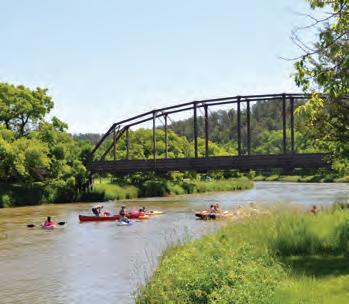
photo by Gordon Warrick
Canoe, kayak, or tube the Niobrara National Scenic River away from the crowds. It’s for everyone! Spend this summer vacation near Valentine at one of the Midwest’s premier river destinations.
of the Friends
Start planning your trip. Go to friendsoftheniobrara.org/float-trip


The Prairie Club, Valentine
THE ARID, DROUGHT-PRONE Sandhills of Nebraska pose a challenge to farmers, but the windswept dunes look golden to golf course developers. The Prairie Club, south of Valentine on Nebraska State Road 97, is built on an 1840s homestead whose settler quit the land.
The Lodge serves blackened Nebraska ribeye in its upscale Canyon Room, with large windows overlooking the Snake River Canyon. Guests can choose a fine cigar from the Lodge’s humidor and relax by the outdoor fire pit. A halfway house intersecting the Pines Course after hole 5 and hole 15 offers sandwiches, snacks and alcoholic and nonalcoholic refreshments. Stop on the way out or back – or both.
The Club’s H.O.R.S.E. Course is a playground – a golf adaptation of the game played on the basketball court. One golfer picks one of 10 holes, their average length 95 yards, and challenges those who follow to make or beat his score. The one who wins the hole picks the next shot to play.
Golf Digest in 2013 rated H.O.R.S.E. Course the 10th most fun to play in America. Frederick Peak, a municipal course 20 miles northwest of Prairie Club on State Highway 97, offers an equally entertaining bargain.
from
Oregon Trail Golf Course, Sutherland
RETIRED CROP CONSULTANT Milan Moore considers Oregon Trail Golf Course in his hometown of Sutherland to be the state’s only air-conditioned course. The 9-hole layout hugs the north shore of Sutherland Reservoir. A breeze from the south and southeast brings relief to summer golfers. Moore plays Oregon Trail in comfort every chance he gets, from one to four rounds in a day.
The course opened in 1953, spread across land now owned by Nebraska Public Power District and leased under a 99-year agreement, which locals in the 1950s hoped would lure housing and shops. It didn’t.
Moore began playing the course at age 10 and continued for nearly 70 years. The greens were prairie sand until replaced by grass in 1993.
Of the nine holes, Moore said the most difficult is the par 5 fourth hole, running 574 yards alongside the reservoir. Cottonwoods, shrubs and rocky material at the shore’s edge penalize anyone who hits their ball in the hazards’ direction, on the left. Moore avoids trouble by using a club, such as a 3 iron, that allows him to better control the ball and avoid the hazards. Still, he typically shoots a double bogey.
The course is named for its proximity to the Oregon Trail, whose ruts can be seen a mile away at eastbound I-80 mile marker 159. The ruts follow the route up O’Fallon’s Bluff that pioneers took to avoid getting stuck in a bog.
THOSE WHO TRAVELED westward in the 19th century along the major trails – the Oregon, the California, the Mormon Pioneer – well documented the Ne-
braska bluff rising nearly 800 feet above them. They wrote about it in their diaries, sketched it in their sketchbooks and told of it to their kin.
Later named Scotts Bluff, for Hiram Scott, an ill trapper abandoned by his Rocky Mountain Fur Company companions, the bluff is memorable for modern-day golfers, too. It casts a shadow in autumn over the front nine holes of a golf course named for its proximity to what is now Scotts Bluff National Monument.
No other course on this list presents a physical feature that shapes a golf outing as much as Scott Bluff’s shadows and slope.
Monument Shadows golf pro Robert Thomason, who’s held the job for nearly three decades, says that in autumn, the shadows make it difficult for golfers to see their ball on certain holes. They choose to play the sunnier holes. No matter the season, proximity to the bluff affects how a ball rolls on the putting surface. The ball rolls away from the bluff and toward either the North Platte River to the north or Five Rocks Road to the east.
The Oregon and California trails ran about a mile south of the course and the

Is currently under construction to be ready for summer.
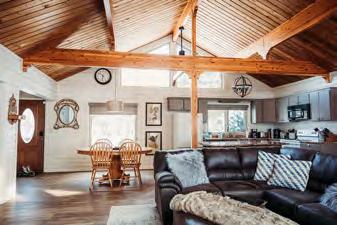


Check out our progress and additional spaces on AirBNB!


92% of 2020 grads found work or continued their education.
91% of 2020 employed grads are working in Nebraska.
83% of 2020 grads are continuing their education in Nebraska.
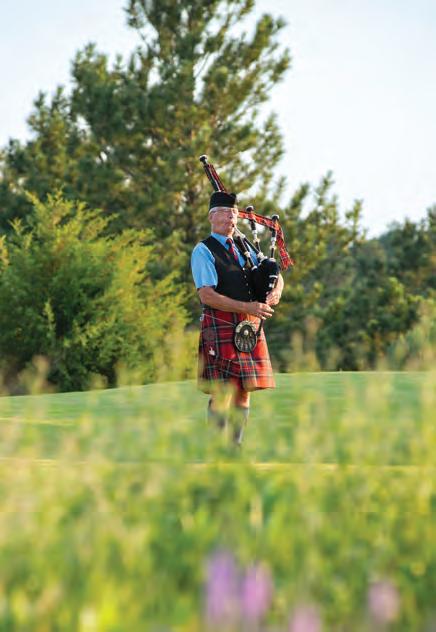
Mormon Pioneer north of the North Platte. There is no physical evidence, but migrants likely camped on what are now the grounds of Monument Shadows.
TRAVELERS ON INTERSTATE 80 through Kimball County in the Nebraska panhandle, near the Colorado and Wyoming state lines, can’t help but see the 5,000 trees planted just north of the roadway. The trees stand out because there is nothing but grassland around them.
Petroleum engineer Bruce Gilliland hired Kimball high school students to plant the trees where there were none, engineering and building nine holes around them, opening Four Winds in 1969. Another nine holes were added in 1995. His wife Wilma loved golf, having played since 1944. While living in Kimball, Wilma be-
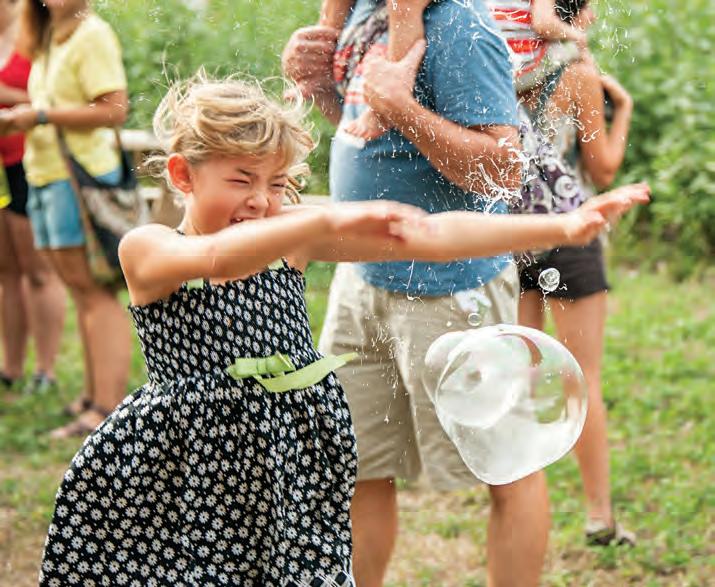
came a leader in women’s golf, chairing the United States Golf Association Women’s Committee. The Nebraska Golf Hall of Fame added her to its ranks in 1993.
The Four Winds course professional for the past 15 years, Chad Wise, said the 5,000 trees redirect the winds blowing from Wyoming in all directions across the course, challenging golfers on the fairways and the greens – thus the name Four Winds Golf Course.
Wise grew up in Lincoln and would have played on the University of Nebraska-Lincoln golf team if not for a 34-car crash in 1991 that severely injured his left knee and back. UNL withdrew its offer, so he went to the New Mexico State University PGA Golf Management program. Later, while raising his young family in Denver, he visited Four Winds and saw the quality of its greens. He immediately moved everyone out to Kimball to become the Four Winds pro. It’s such a quality course, he knows it will blow anyone away.
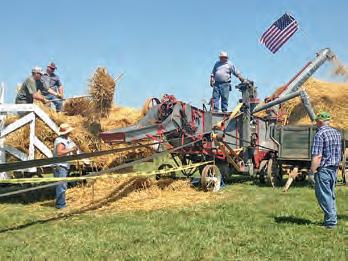


LINCOLN.ORG/ neblife
Entertaining and fun all at the same time. You won’t be searching for things to do in Lincoln—they’ll find you!
Wild Horse Golf Club
40950 Rd. 768, Gothenburg. (308) 537-7700. Public,18 holes, $51-71.
Dannebrog Country Club
1158 NE-58, Dannebrog. Public, 9 holes, $8 all day.
Field Club of Omaha
3615 Woolworth Ave., Omaha. (402) 345-6343. Private, 18 holes.
The Auburn Country Club Golf Course
72722 U.S.-75, Auburn. (402) 274-4500.
Semi-private, 9 holes.
Tatanka Golf Club 53138 NE-12, Niobrara. (402) 857-3504. Semi-private, 18 holes.
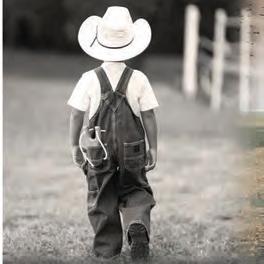
Oregon Trail Golf Course
31200 W. Tower Rd., Sutherland. (308) 386-4653. Public, 9 holes, $12-$25.
The Prairie Club
88897 NE-97, Valentine. (888) 402-1101. Semiprivate, 18 holes, $164-200.
Monument Shadows Golf Course
2550 Clubhouse Drive, Gering. (308) 635-2277. Public, 18 holes, $20-$30.
Pelican Beach Golf Course
Three miles east of Hyannis on NE-2. Public, 9 holes, $12-15.
Four Winds Golf Course
4530 Gilliland Drive, Kimball. (308) 235-4241. Public, 18 holes, $23-33.
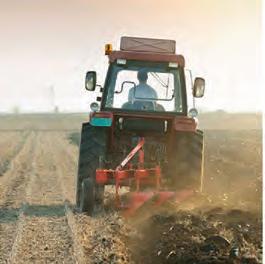



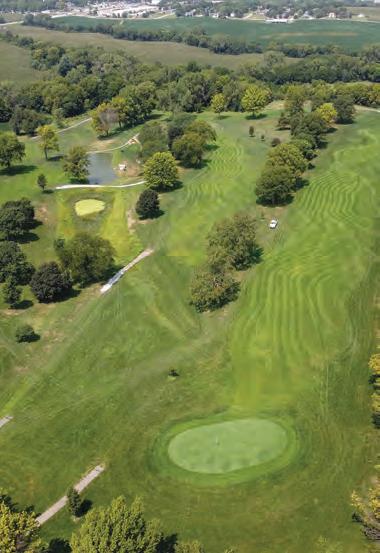





ASHLAND
Strategic Air Command & Aerospace Museum, p 86
BANCROFT
John G. Neihardt State Historic Site, p 84
BROKEN BOW
Custer County Historical Society, p 86
CHADRON
Dawes County Historical Society Museum, p 88 Museum of the Fur Trade, p 86
COZAD
100th Meridian Museum, p 89
Robert Henri Museum, p 89
CRAWFORD
Trailside Museum of Natural History, p 84
DAVID CITY
Bone Creek Museum of Agrarian Art, p 84
FORT CALHOUN
Washington County Historical Assoc. and Museum, p 87
FREMONT
Dodge County Historical Society Museum/Louis E May Museum, p 88
GOTHENBURG
Pony Express Station Museum, p 78
GRAND ISLAND
Stuhr Museum of the Prairie Pioneer, p 82, 101




HENDERSON
Henderson Mennonite Heritage Park, p 98
KEARNEY
Archway, p 82
Museum of Nebraska Art, p 82
LA VISTA
Czech and Slovak Educational Center and Cultural Museum, p 87
LEXINGTON
Dawson County Historical Society Museum, p 88
LINCOLN
History Nebraska, p 84
International Quilt Museum, p 87
University of Nebraska State Museum, p 89
NEBRASKA CITY
Wildwood Historic Center & Period House, p 83
NELIGH
Pierson Wildlife Museum Learning Center, p 87
OAKLAND
Swedish Heritage Center, p 60
OMAHA
Joslyn Castle, p 85
Omaha Children’s Museum, p 85
RED CLOUD
Willa Cather Foundation, p 85
ROYAL
Ashfall Fossil Beds, p 84

SEWARD
Nebraska National Guard Museum, p 85
ST. PAUL
Howard County Historical Village, p 88
Museum of Nebraska Major League Baseball, p 88
TEKAMAH
Burt County Museum, p 88
WEEPING WATER
Weeping Water Valley Historical Society/Heritage House Museum Complex, p 84
WYMORE
Great Plains Welsh Heritage Project, p 86
YORK
Clayton Museum of Ancient History, p 86
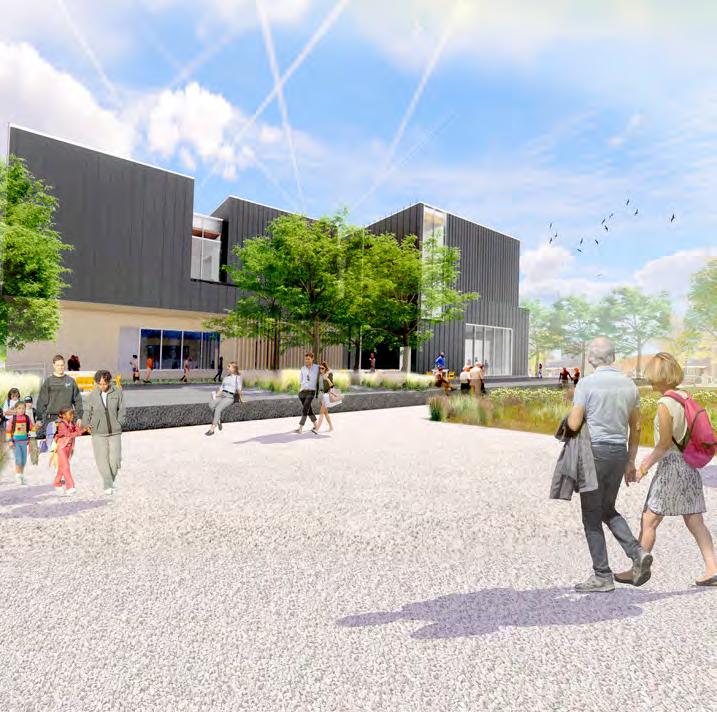



AN ORNATE HAT that once belonged to a child in Peru. An intricate Samburu necklace from Kenya. A shadow puppet that once danced in Bali.
Taylor Ronquillo, 24, grew up in Grand Island, but now, as an anthropology master’s student at the University of Nebraska-Lincoln, she’s handling artifacts from around the world.
Most recently, she’s helped select pieces that will pair with an upcoming photography exhibit at the University of Nebraska State Museum Morrill Hall. DIGNITY: Tribes in Transition by acclaimed international artist Dana Gluckstein is a collection of 60 black and white photos of Indigenous Peoples from around the world
that will show at the museum from June 11 to August 7. The museum’s colorful artifacts will complement related portraits.
The Nebraska State Museum’s collection of 40,000 anthropological artifacts is a resource for students, like Ronquillo. Many of the pieces she’s pulling for the show will be new to the public – only 2 percent of the museum’s collection is ever on display.
But that doesn’t mean the items serve no purpose like the cobwebby exercise equipment or broken electronics in someone’s basement. The collection serves as a repository for cultural preservation. Also, University of Nebraska-Lincoln anthropology interns get hands-on training in handling and managing collections, and

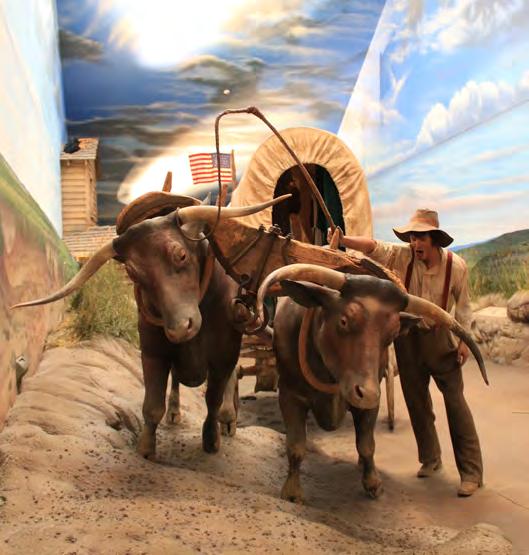
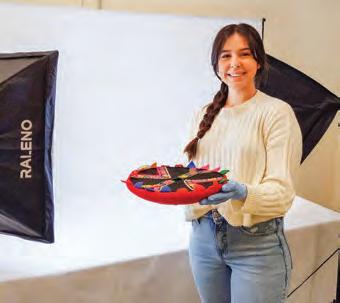
other students have an enormous library of artifacts to experience firsthand while conducting research.
Ronquillo’s plans to travel after earning her bachelor’s degree in anthropology at Nebraska-Lincoln in 2020 were put on hold because of the pandemic, so she kept going for her master’s degree. It allowed her access to a broader world and gave her, “a real-life idea of what it is to be in this profession,” she said. “It makes me happy to be with artifacts every day.”
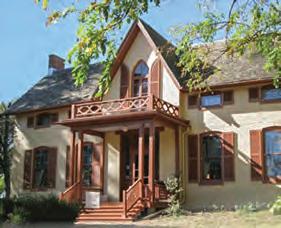
in
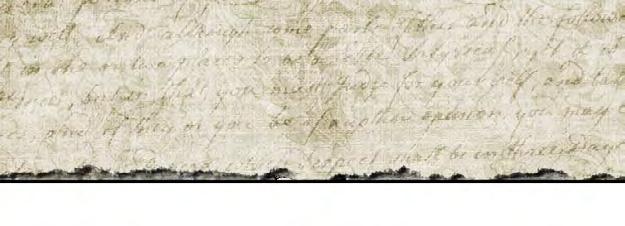
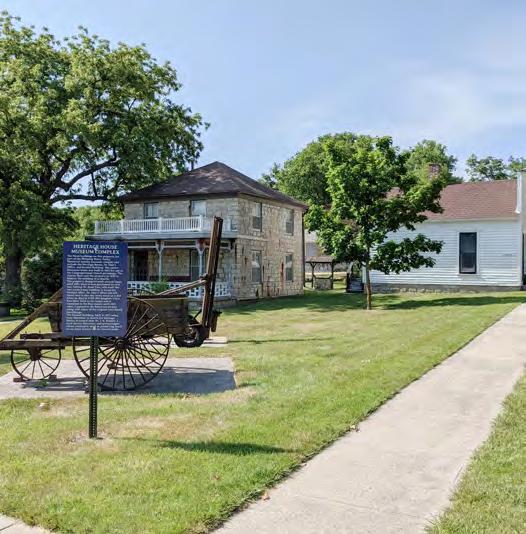
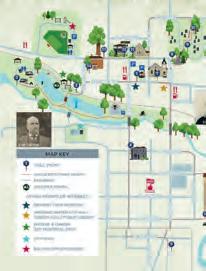

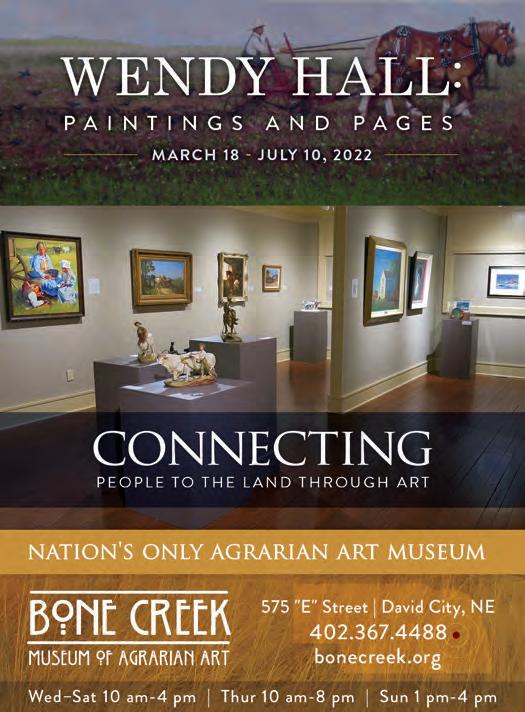



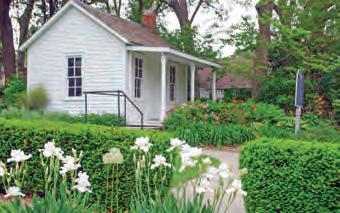
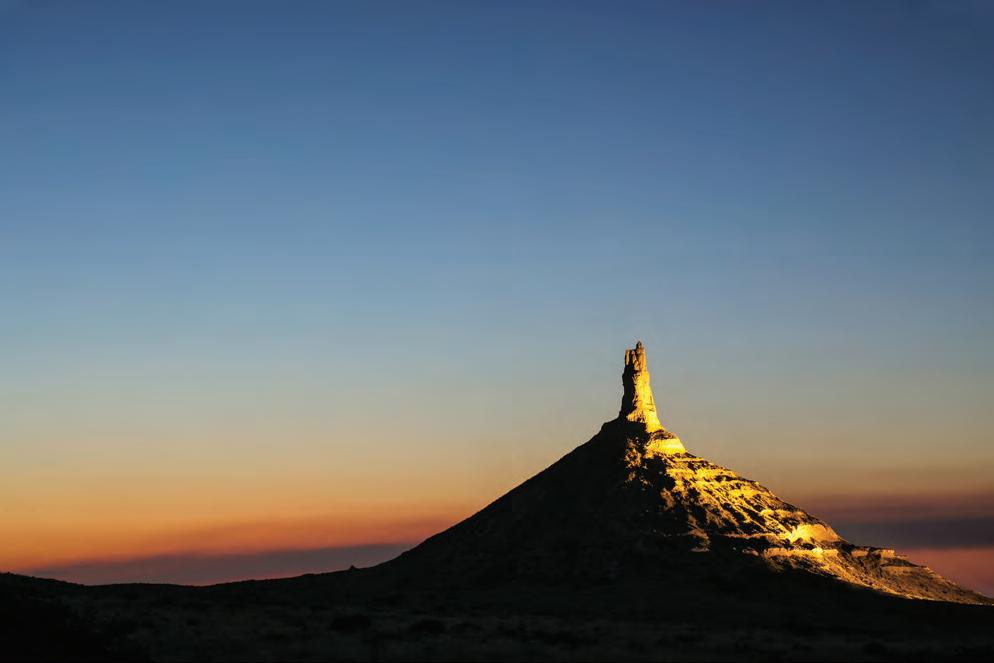


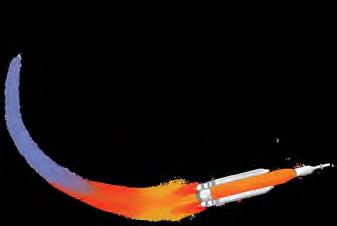

SPECIAL EXHIBIT
Open May 28, 2022 through January 8, 2023
THIS EXHIBIT WILL TRANSPORT CHILDREN TO A WORLD INSPIRED BY THE CURRENT REALITIES AND THE FUTURE DREAMS OF SPACE TRAVEL!

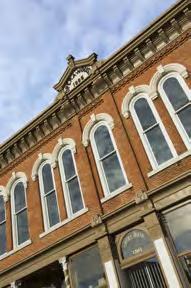


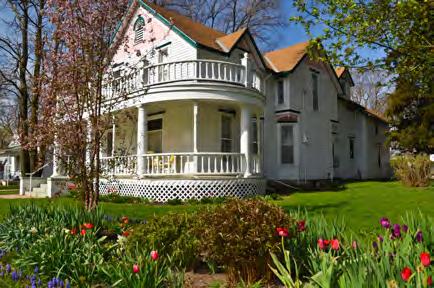
A living memorial to renowned writer, Willa Cather! Explore the exhibit, American Bittersweet: The Life & Writing of Willa Cather, tour historic properties, take in a performance at the Opera House, or book an overnight stay in the Cather Second Home.
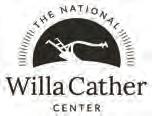
425 N. Webster St. • Red Cloud 402-746-2653 • WillaCather.org OPEN TUES-SAT 9am - 5pm
Preserving the history and heritage of the Nebraska National Guard


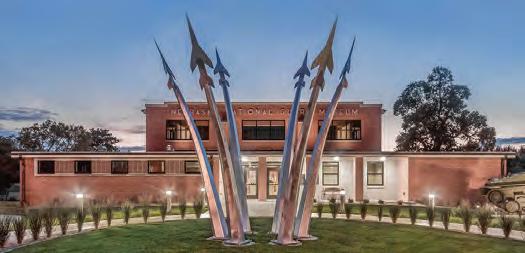
Celebrating the 160th anniversary of the victory at Fort Donelson with the First Nebraska Infantry that propelled Grant to national attention during the war. July 2, 3, & 4 Meet the Lincolns and Grants, Encampments, Civil War Revue, 1860’s Fashion Show, Parade and Mounted Guard Exhibition.
402-309-8763 . 201 N 8th St., Seward Mon-Friday: 8 am-4 pm
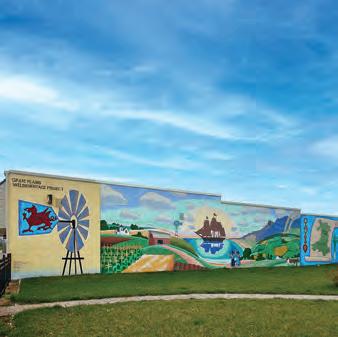



See the history of the first business in North America -the fur trade.
10 Unique items to view!
John Kinzie’s gun
HBC Officer’s sword
Brass Handle Cartouche Knife
William Clark Fabric Samples Chief’s Coat
Kit Fox Society Lance Russian American Co. note
Oldest dated trap 1755
Parchment HBC Officers Certificate
Andrew Henry’s Leggings

Open 8-5, May 1 to October 31 3 miles east of Chadron, Nebraska on US Highway 20. www.furtrade.org 308-432-3843 • museum@furtrade.org
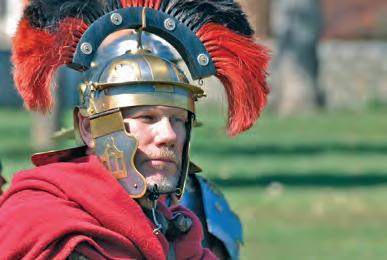


Explore ancient Rome, the Near East and much more. Special Bible exhibit shares the story of scripture from scroll to modern translations. Children’s interactive Little Kingdom now opened!
View rare artifacts from the ancient civilizations of Mesopotamia and Roman Empire! Young and old can experience the museum’s Little Kingdom interactive area. Uncover objects in an archaeological dig, “live” in an ancient house and “shop” a Roman market. Admission is FREE with donations always accepted.
ADMISSION IS FREE
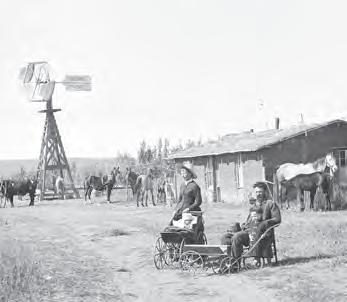
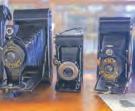
See riveting photos of the west before it was tamed in the Solomon D. Butcher Gallery, marvel at military hero’s artifacts and look up your wonderful ancestors in our Library Archive.
Sponsored by Custer County Tourism Call 308-872-2203 or visit CusterCountyMuseum.org 445 S 9th Ave • Broken Bow
Open Tues-Fri, 1 - 5 p.m. Call for group tours. claytonmuseumofancienthistory.org
Open Tues-Fri, 10 am-5 pm • Sat 1-4 pm claytonmuseumofancienthistory.org
402-363-5748 1125 E 8th St • York, NE o
402-363-5748 • 1125 E 8th St • York


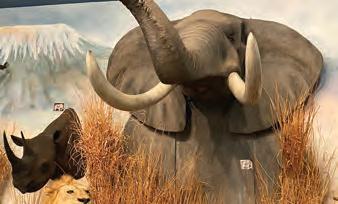
View exhibits from around the world at Pierson Wildlife Museum Learning Center in Neligh. Observe animals and learn about their habitats. From African elephant to woodland caribou, students and adults enjoy this one-of-a-kind display of animals.
To schedule a tour call 402-929-0330 Cash or check payment only.
Museum & Learning Center
PiersonWildlifeMuseumNeligh.com 205 E 5th St • Neligh


Visit this unique cultural experience in LaVista!
Explore our exhibits featuring the Immigration Room, Music Room, Sokol Room and Josef Lada calendars from the 1940s. Our gift store offers many beautiful Bohemian items from the Czech land.
8106 S. 84th St. • LaVista 402-686-9837 CzechAndSlovakMuseum.org
102 N. 14th Street • Fort Calhoun, NE 68023 402-468-5740 • wcneMuseum.org Please call ahead for grgpoup tours

Located in the heart of historic Fort Calhoun, the Washington County Museum is just a short drive north of Omaha on Highway 75. See the history of the county that welcomed Lewis and Clark, famous mountain men and the 6th Infantry. The museum tells the story through Lewis & Clark’s visit here, Native American artifacts, military relics from Fort Atkinson and lives of the early pioneers.

&
Tues-Fri 9-5; Sat 9-1
Sun and Mon. $3 adults; $2 kids 5-12; $1 per student for school tours
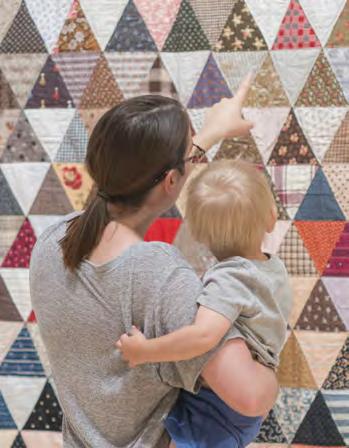
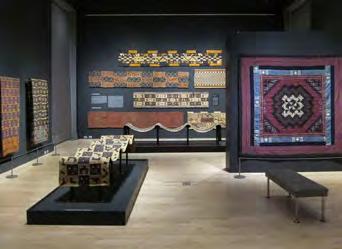


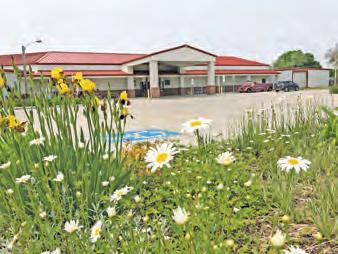
10-4 Tuesday - Saturday Year-round No
(free-will donation).
INDOOR EXHIBITS
Agriculture Hall, Military Hall of Honor, Lincoln Highway with vehicles dating to the 1920s, Art gallery for special exhibits, Blacksmith Shop, Main Street, 1917 Baby Bi-Plane (one-of-a-kind). Gift Shop, Library, Archives. Trivia Night in November.
OUTDOOR EXHIBITS
One-Room Schoolhouse, Depot, 1903 Baldwin Locomotive #485, Fairhaven Baptist Church, log cabin. Accessible to the public during the summer months. CAR SHOW Saturday, May 28. No registration fee, prizes Lunch, 9-3

NE 68850

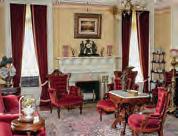



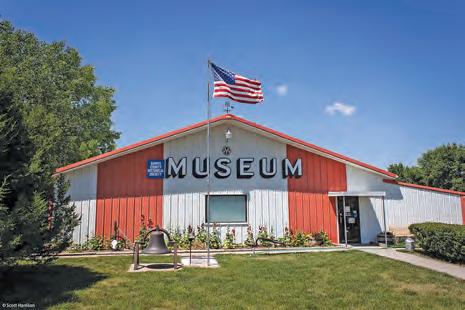




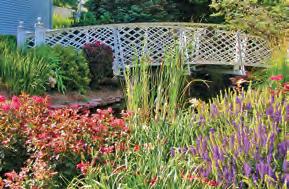

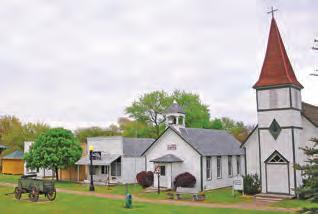
in St. Paul. GCA days July 8, 9, 10. Junk Jaunt September 23, 24, 25. In Howard County, you are more than a guest, you are a friend.


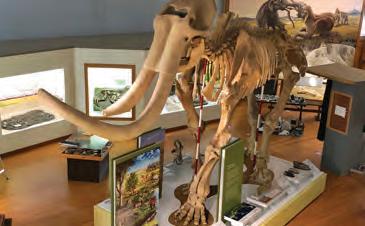


With 4 floors of fossils, hands-on science activities, and world cultures exhibits, there’s something for everyone to enjoy at Morrill Hall.


Enjoy Clash of the Mammoths. Explore the recently (2021) renovated Ice Age Mammals exhibit and this year’s new, interactive Poop & Paws exhibit.

Fossil Beds Royal, NE •ashfall.unl.edu


Watch as our team excavate new fossils in this ancient watering hole. Enjoy hands-on activities, or bring picnic and hike the nature trails.
Delight in small town shopping, savor the flavors of dining, hunt for barn quilts, and tour our museums and outdoor art. Cozad’s outdoor art projects celebrate our art heritage while making art accessible at all times of the day. Barn Quilts of Dawson County Trail 50 States Barn Quilt Display • Wilson Public Library sculpture garden • Rhakenna’s Wings
• “Cozad Creates” paint palette icons
For more information and maps, visit barnquiltsdc.com Also visit roberthenrimuseum.org and cozadhistory.org
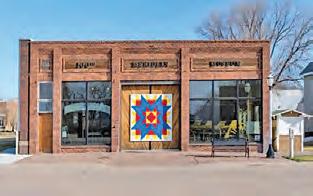

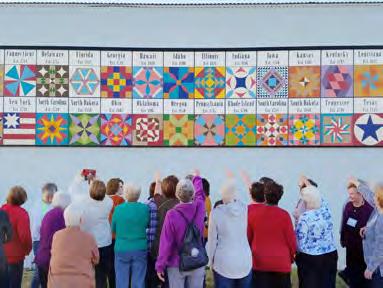

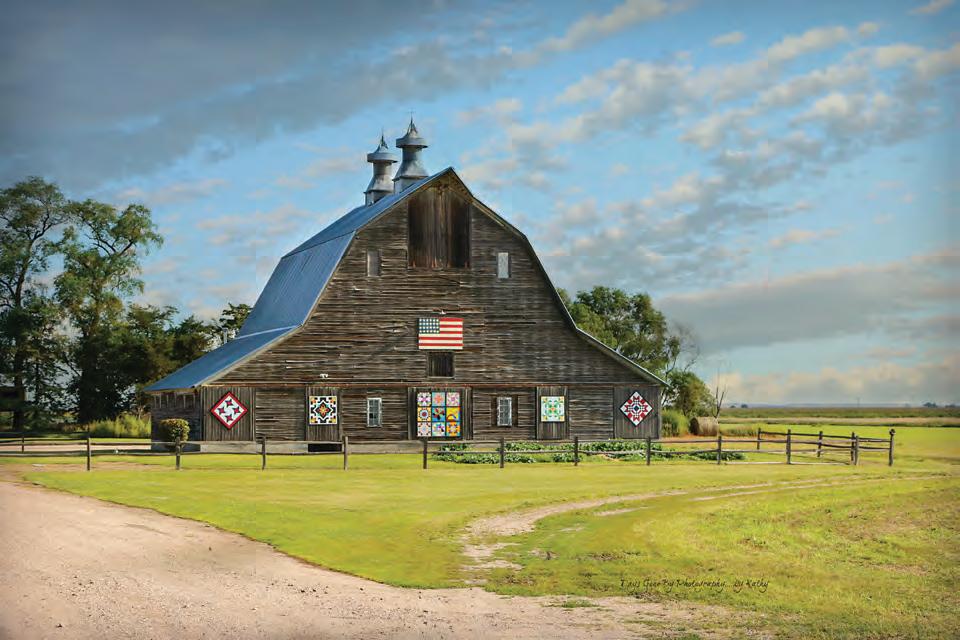

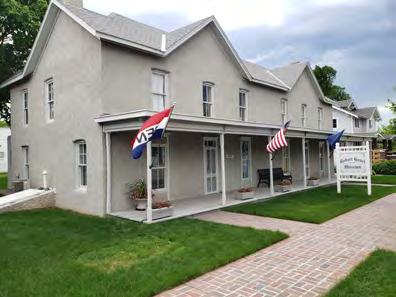
by SAVANNAH REDL
JUNE 24-26 • CLARKSON
For 60 years, Clarkson, a community of 650 residents, has celebrated Czech Days with a weekend of polka music, dancing and food. Janeen Jindra beams with pride as she watches her granddaughter dance and braid red and blue ribbons around the Maypole. Jindra has attended Clarkson’s Czech Days for decades. Her great-grandmother came to the U.S. as a baby on a boat from Czechoslovakia in the 1880s. For Jindra and other residents, Czech Days is about heritage and legacy.
Although many of the festival’s elements remain constant, sometimes new traditions emerge. One year, Jindra’s father gave her son, Wyatt, a rundown 1949 International M tractor. Wyatt gathered with local tractor mechanics and fixed it up in time for her father’s 80th birthday and the 2018 Czech Days parade. When Jindra’s father saw it, he cried tears of joy.
From that point on, the tractor has pulled the parade committee.
The smell of pork and sauerkraut wafts through Clarkson’s downtown after the parade. Volunteers stack coolers full of beer in the beer garden. Vendors display Czech glass, jewelry and ribbons. Food stalls sell sweet treats like funnel cake and ice cream.
Residents clamor to the booth of Jim Newill, who sells locally famous kettle corn. Newill spends his winters in Arizona, so he’s always in demand when he returns to Clarkson with his perfectly popped corn. People often ask him if he can ship his popcorn back to Nebraska. Alas, he cannot.
Like Czech Days, it’s a delicious treat that only happens once a year in Clarkson. See the full schedule at clarksonczechdays.org
“Soon your love will all be mine. Then I’m gonna take you home. Marry you so you won’t roam.”

Kolaches, jumbo muffins, horn rolls and pecan rolls satisfy in this dough-lightful hometown spot. 113 Pine St. (402) 892-3131

This century-old home features a wrap-around porch perfect for reading a book or enjoying a cup of morning coffee. 220 W. 3rd St. (402) 860-1577

The community lovingly restored this historic building that has hosted dances, basketball games, weddings and more. Originally built in 1913, its brick façade is charming, and its hand-painted curtains dating to the 1930s are still in wonderful shape. 340 Pine St. (402) 892-3457


TUESDAYS IN JUNE • LINCOLN
Matthew Boring started attending Lincoln’s Jazz in June as a high school student 20 years ago. He savors the music and the bright blue food truck Parthenon, which makes an incredible fruit smoothie that pairs well with the tunes – cool and sweet.
Beginning again this June, on a green space between Lincoln’s Lied Center for Performing Arts and the Sheldon Museum of Art on the University of Nebraska-Lincoln campus, couples and families will unfurl blankets and unpack picnic baskets. Food trucks, like Parthenon, attend to anyone who hasn’t brought a meal. As dusk settles, the sky provides the perfect backdrop for jazz musicians who’ve gathered to play the free concert – a Lincoln tradition since 1991.
Silky melodies float down the block, attracting curious passersby. Baritone notes hang thick in the summer air. Kids dance in front of the stage and couples link hands and watch the stars come out. Surrounding sculptures on the green also attract art enthusiasts’ gaze.
Today, as deputy director of the Lied Center, Boring said it’s not just Nebraskans who are impressed by Jazz in June. After Grammy Award-winning artist Ingrid Jensen performed at a festival, she told Boring the concert stuck out in her
mind as an unforgettable time. Nebraskans gave the artists the warmest, most appreciative reception, she said.
The party doesn’t stop after the concert is over. People often keep the magic going by participating in post-concert activities like looking for constellations from a parking garage rooftop. There, they can cheer on the stars all night.

If flavors could play a melody, they’d play it forte at this gastropub serving artistic seasonal plates of perfectly balanced bites. 1100 O. St. (402) 475-9475

After jazz-related partying, it’s nice to be able to walk back to the hotel, especially when that hotel has a hot tub. 808 R St. (402) 904-4800

Landmark high modernist building showcases collection of quirky, edgy and boundary-breaking international art. 12th and R streets. (402) 472-2461
Cinco de Mayo
May 6-8 • Omaha
South 24th Street throbs with live music and the clank and ring of carnival rides. The piquant smell of tacos and stews fill through the air. This is Nebraska’s biggest festival, attracting 250,000 visitors from six surrounding states. There is a royalty coronation for youth, and a “Que Chulo” (So Cool) dog contest, a parade and a beer garden. cdmomaha.com
Sip Nebraska
May 6-7 • Ashland
Nebraska’s beer and cider brewers, winemakers and distillers gather to share their offerings at Eugene T. Mahoney State Park with a weekend of unlimited tastings, lawn games, live music, goat yoga and sip and learn classes. Food vendors guarantee no one drinks on an empty stomach. (402) 882-2448
Nebraska Food Truck Wars
May 7 • Plattsmouth
A live band plays as food trucks galore fill Plattsmouth’s Main Street for a battle of the finest fare on four wheels, 6-10 p.m. Tacos, ice cream, sandwiches, seafood, barbecue, pizza and more await the hungry masses. (402) 296-6021
Renaissance Festival of Nebraska
May 7-8, 14-15 • Bellevue
Hark! A party of most wondrous amusement cometh to Bellevue Berry Farm. Th’re shall beest food to consume, games to amuseth, and plays to gaze. A jousting matcheth shall decideth a winn’r. Bringeth wage to shopeth at the artisanal tents. (402) 331-5500

Family-friendly activities include face painting, arts and crafts and music.



A woman scales a 25-foot rock climbing wall. Bright paint transforms children into animals or works of art. The smell of Rev. Tony Sander’s Heavenly Hot Dogs fills the air as blues music echoes from a stage. People eat, dance, drink – and even test their blood type at a blood bank.
For the second year, the field of grass behind the Malcolm X Memorial Foundation in Omaha at 3448 Evans St. will become a festival ground for Juneteenth, a federal holiday commemorating the emancipation of enslaved Black Americans.
Calvin Williams started the Omaha Freedom Festival last year to celebrate Black Nebraskans’ heritage and to strengthen the community. He wanted to


build off the Juneteenth parade.
The Freedom Festival invites families to stay after the parade and enjoy sidewalk drawing, bouncy houses, bubble play and an arts-and-crafts station. Free snow cones tame the hot days.
The Black Police Officers Association of Omaha has a recruitment booth. A blood bank is on hand to receive donors. Health clinics provide screenings. Employment services share job information; educational institutions answer questions about classes.
Last year, the festival fed 1,725 people and gave away 40 bikes and helmets to kids. At the end of the day, families danced and celebrated as various musical guests took the stage. (402) 686-8316
It’s a magical time to visit Arbor Day Farm as we celebrate our rich history of tree planting. Join us for one-of-a-kind activities that take you high into the trees, along wooded trails, into a historic mansion, and under the soaring timbers of Lied Lodge. Your getaway awaits; find it at arbordayfarm.org

The name says it all and could only be improved by the adjective “delicious” in front of fish. Omahans line up for the fish and shrimp combo dinner. 1706 N. 24th St. (402) 342-4362

Restored 1920s bungalow in Gifford Park within walking distance to restaurants, bars and cafes charms with abundant natural light and decorating touches by a local home goods store owner. 133 N. 35th Ave. www.abnb.me/LqwA0JRTrob

The Union for Contemporary Art, which features local and international artists, has a visual feast outside in the 960-foot garden. Visitors are welcome. 2423 N. 24th St. (402) 933-3161

Toast Nebraska
May 13-14 • Omaha
Nebraska’s winemakers uncork the fun in Stinson Park for a tasting event featuring live music, educational sessions, shopping and food. General admission tickets include a tasting glass, tastings at more than 15 winery booths, a wine tote, and access to music, food and fun. Enjoying products from across the state helps wine fans shape up their summer travel plans. (402) 405-1291
Patriotic Parade
May 28 • Omaha
Honoring Gold Star families and paying tribute to our servicemen and women, a host of parade entries includes the Army Old Guard Fife and Drum Corps, the 2nd Marine Wing Band, and the Fort Riley Commanding General’s Mounted Color Guard, among other military and patriotic organizations for the downtown Omaha event that begins at 10 a.m. A balloon glow lights up the night on May 27 in Memorial Park. (402) 612-0210




Polish Days
June 3-5 • Loup City
Polish ancestry is not required to enjoy this fun family event, so witamy! (Welcome!) Live Polka music plays as folks line up for Polish cuisine and the cornhole tournament. Laser tag, a traveling water park, rock climbing wall, a bounce house and other activities thrill the kids. Adults can try their arms out with the ax throw. Please, somebody hold my beer. (308) 745-5146
Camp Creek Fun Run
June 4 • Waverly
Onroad and offroad courses challenge 5K and 1-mile contestants. Families are welcome on the shorter fun run, so keep up, junior! Runners take in the beautiful Waverly countryside scenery, break a sweat and raise money for local charities. Now that’s a run that makes you feel good. (402) 786-3396

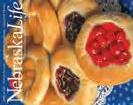
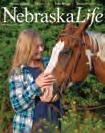



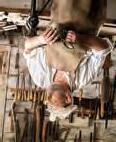
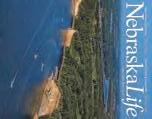

McCOOK • JUNE 11-13
Nick and Tyler Talbott were teenagers from Imperial the first time they played at the Buffalo Commons Storytelling and Music Festival in McCook. This year, the critically acclaimed indie folk pop duo, all grown up and known as The Talbott Brothers, returns to the festival after wrapping up a national tour for their new album.
Their music tells stories about their family and growing up in Nebraska, which makes them the perfect act for the festival, said organizers.
Locals started Buffalo Commons Storytelling and Music Festival in reaction to a published academic paper that argued the area should be depopulated and returned
to bison. The festival aims to preserve oral history and reconnect people in this age of soundbites and partisanship.
This year, the festival is celebrating its 25th year of bringing community together with music, stories and events at beloved McCook venues including the historic Fox Theatre, James Beard Award-Winning Sehnert’s Bakery and Bieroc Café and the High Plains Museum.
Stories at past festivals have included tales of McCook’s railroad history, its flood, ranching and cowboys, and political history of five governors. This year’s events will include a Navajo artist and storyteller, the usual open mic night for community members, and the playwright
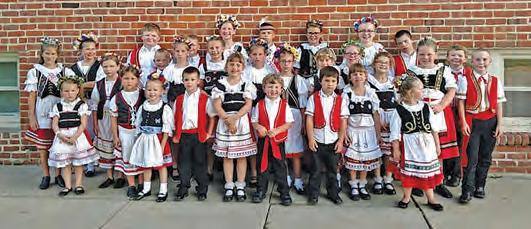

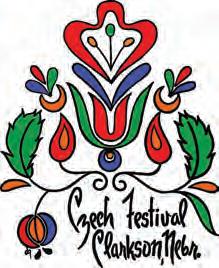
June 24th, 25th, and 26th, 2022
Clarkson Czech Days
Join big-hearted Nebraska Czechs for three days, authentic Czech food, street dances and polka, polka, polka!
Featuring The Rude Band on June 26 + Wine tasting, Nebraska Czech Queen Contest, gigantic street parade, adult and children’s Czech dancing and more.
Check Facebook page for updates (402) 892-3331

and storyteller Kevin Kling. The Talbott Brothers will play several events, perhaps sharing words from their song, “Family”: “I’m a product of my Granddad’s son/ Hardworking hands and a job well done/ Skin thick as railroad ties/But you could see a kindness in his eyes/ I didn’t want to do what he did/ But I always wanted to be just like him”
Stories reflect the common bonds that people from one family or region share. Hearing others’ experiences not only allows people to empathize with one another, but it also emboldens people to share their own stories. buffalocommons.org – Megan Feeney

Complimentary hot breakfast, pool. 1301 N. Hwy 83. (308) 777-2000


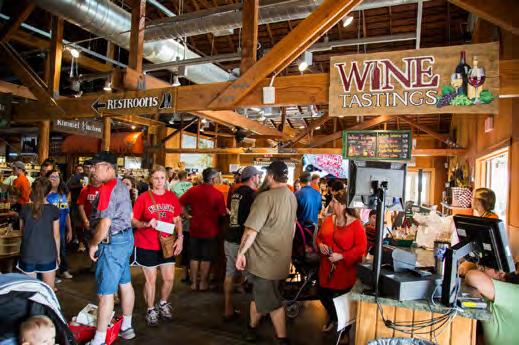



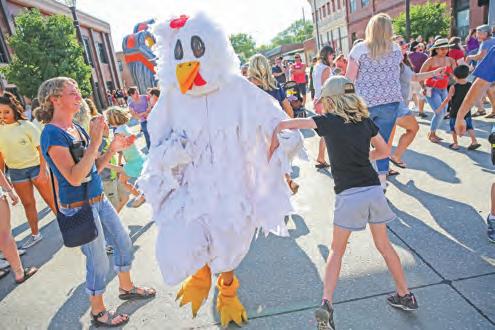
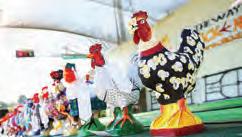

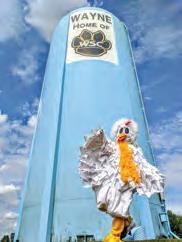
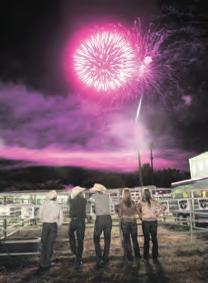





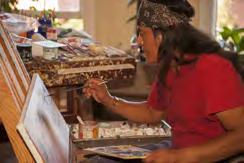


Rock Creek Station Trail Days
June 4-5 • Fairbury
Visitors travel back in time, beginning the first weekend in June, with living history events including a reenactment of the Hickok-McCanles Fracas, a Pony Express ride and mule-pulled wagon rides and music. Saturday night offers a buffalo stew cookout at 7 p.m. (402) 729-5777
Comstock Windmill Festival
June 9-11 • Comstock
Billed as the country’s biggest pasture party, this festival draws country music acts from across the United States for a three-day music party. Camping is available on site, and kids under 5 enjoy free admission. (308) 370-1023
Holdrege Swedish Days
June 17-19 • Holdrege
Darting through Holdrege to complete the “Dala Dash,” is one of many fun activities involved in Holdrege Swedish Days. Businesses decorate their storefronts, and a parade hits the streets. Beer and ice cream round out the day. (308) 995-4444
Questions on p 22-23
1 Ole’s Big Game Steakhouse & Lounge in Paxton
2 Possible answers: Logan, Arthur, Thomas, Grant, Keith, Lincoln, Blaine and Rock
3 Seven: S.D., Colo., Kan., Wyo., Okla., N.M. and Texas.
4 Central Flyway
5 R.I., Del. and Conn.
6 False –her father, Old Jules 7 True
8 True
9 True 10 True
11 b. Dismal River
12 c. Avocado
13 a. 1897
14 b. Sand dunes
15 c. Charles Bessey
Trivia Photographs
Page 22 The Mignery Sculpture Garden in Bartlett has a collection of bronze statues.
Page 22 Diners at Ole’s Big Game Steakhouse and Lounge in Paxton enjoy lunch with a polar bear.
Page 23 Nebraska National Forest at Halsey is a human-planted forest.





Make plans to visit Greeley in 2022. for big city attractions with a small-town feel. Call 970-352-3567 for a FREE visitor information packet
Breweries Fine Culinary Choices Art All Around the City Events for Everyone

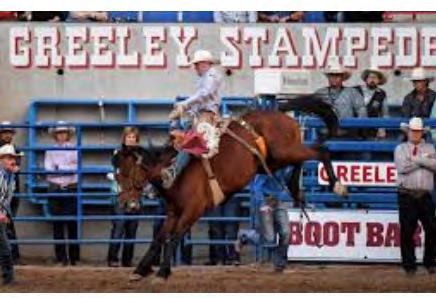
Days of Sunshine
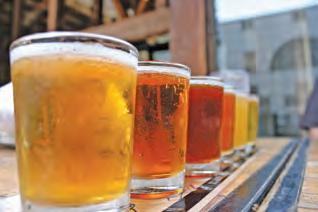


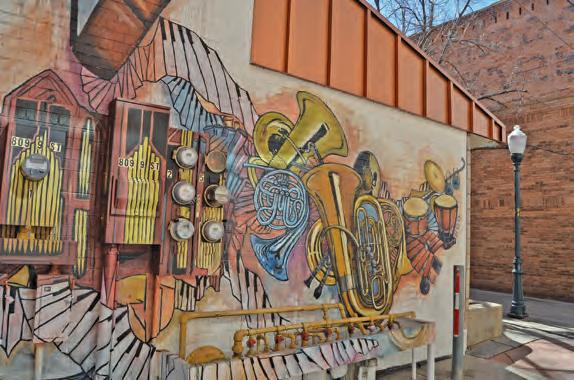

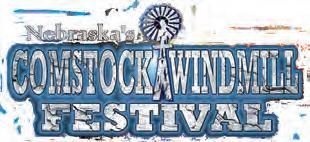


Thursday
Saturday




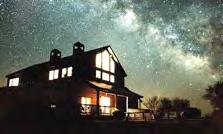
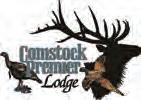





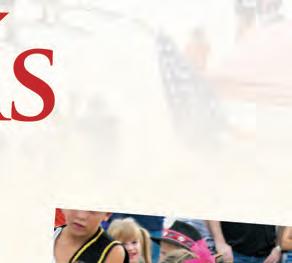
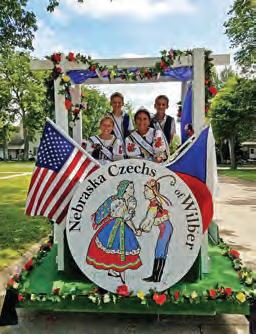

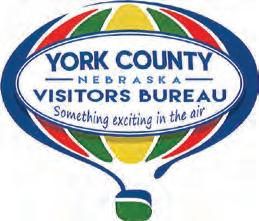
With
Wessels Living History Farm Opens May 5
Cinco de Mayo Admission Special Wessels Living History Farm ~ May 27
Opening Day for Henderson Mennonite Heritage Park June 5
Barrel Fest
Wessels Living History Farm ~ June 9
York Farmer’s Market starts Kilgore Memorial Library ~ June 24-26
Waco Days Waco Citywide July 3
Firecracker Frenzy













“We’re









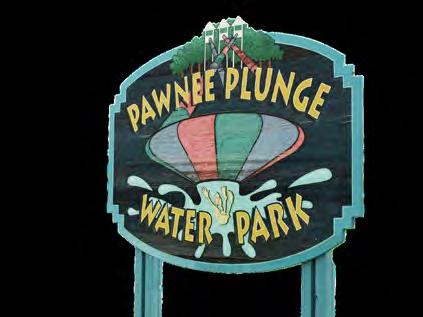
Mushroom hunting doesn’t have to be winner-take-all
by ALAN J. BARTELS
Morelity-
NOUN: a system of values where seekers of wild edibles always leave some for the next hunter.
OK, “MORELITY” ISN’T really a word, but it is a lifestyle. I first experienced it while working on a story about asparagus hunting for the May/June 2018 issue of Nebraska Life (“Holt County Harvest”). At every one of his secret asparagus spots near O’Neill, wild edibles expert Dathan Wallace cut only a few stalks, making sure that the next person to come along would also find fresh treasure for their own meal. Since then, I’ve applied that same generous ethic to mushroom hunting.
Before that eye-opening asparagus hunt, I’d pick every morel mushroom I could find. One time my daughter and I filled a giant paper grocery bag half full. Our search was a competition against the local white-tailed deer – they also like morels. More than once I’d left tiny morels hoping they’d get bigger, only to come back to find the telltale marks of where an opportunistic deer’s incisors had clipped them off. Sometimes the herd appeared to have followed my trail between morel morsels.
Back then all my mushroom hunting spots were on public land. So, my greedy decimation of the delicacy wasn’t fair to the next guy. Sure, I had the right to pick them for personal gastronomic glory, but now it doesn’t seem right to take them all from land that belongs to all Nebraskans.
I have no qualms with landowners, or people with permission, to take all the
morel mushrooms they find on private land. Buyers offer bountiful paydays to collectors who would rather sell their bounty than eat it. The Nebraska Morels Facebook page told me that some hunters last year were asking $40 per pound. They expect that to go up this year due to the dry winter.
Within hours, Nebraskan morels are loaded on to airplanes to be served in upscale restaurants far from the Good Life. Last year at a restaurant in Milwaukee, a fivecourse meal featuring morel mushrooms cost diners $150 each. The event sold out in minutes.
Could the morel mushroom become a fungal windfall for Nebraska farmers?
Bear’s head, shiitake, lion’s mane and oyster mushrooms have been domesticated by growers and can be found in the produce section of grocery stores. Some growers have had limited success, but for the most part, the morel mushroom resists being propagated in captivity.
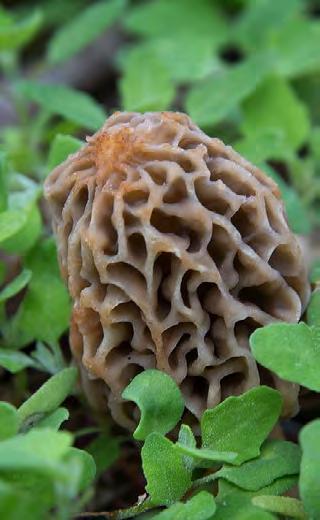
rels that I find are typically a pale yellow or cream color, with a cone-shaped cap covered with indentations resembling a honeycomb or sponge. I’ve never come across the poisonous “false morel,” but I’ve read about them. Unlike our morels, the stem of a false morel is not hollow. To be safe, always consult with an expert and/or a good field guidebook.
I usually begin finding morels in mid- to late-April after spring rains soak the sand and sun warms the ground, but I’ve found them from March to August. In dry springs like 2022, I predict the best finds will be in mid-May. I’ll have to look a little harder, since the shrooms will then be difficult to see in the lush late-spring growth of my river bottom haunts.
Our columnist is on the hunt for morels again, but he’ll leave some for you.
The meaty texture and earthy flavor of the morel is enough to inspire homebodies to head outdoors. The wild mo-
No mushroom hunting story would be complete without a recipe. I cook my morels like I prepare my venison steaks: fried in butter or olive oil in a cast iron skillet –two to three minutes on each side on medium heat or until brown. Don’t overcook them, get permission before mushroom hunting on private land, and above all –leave a few shrooms for the next guy.
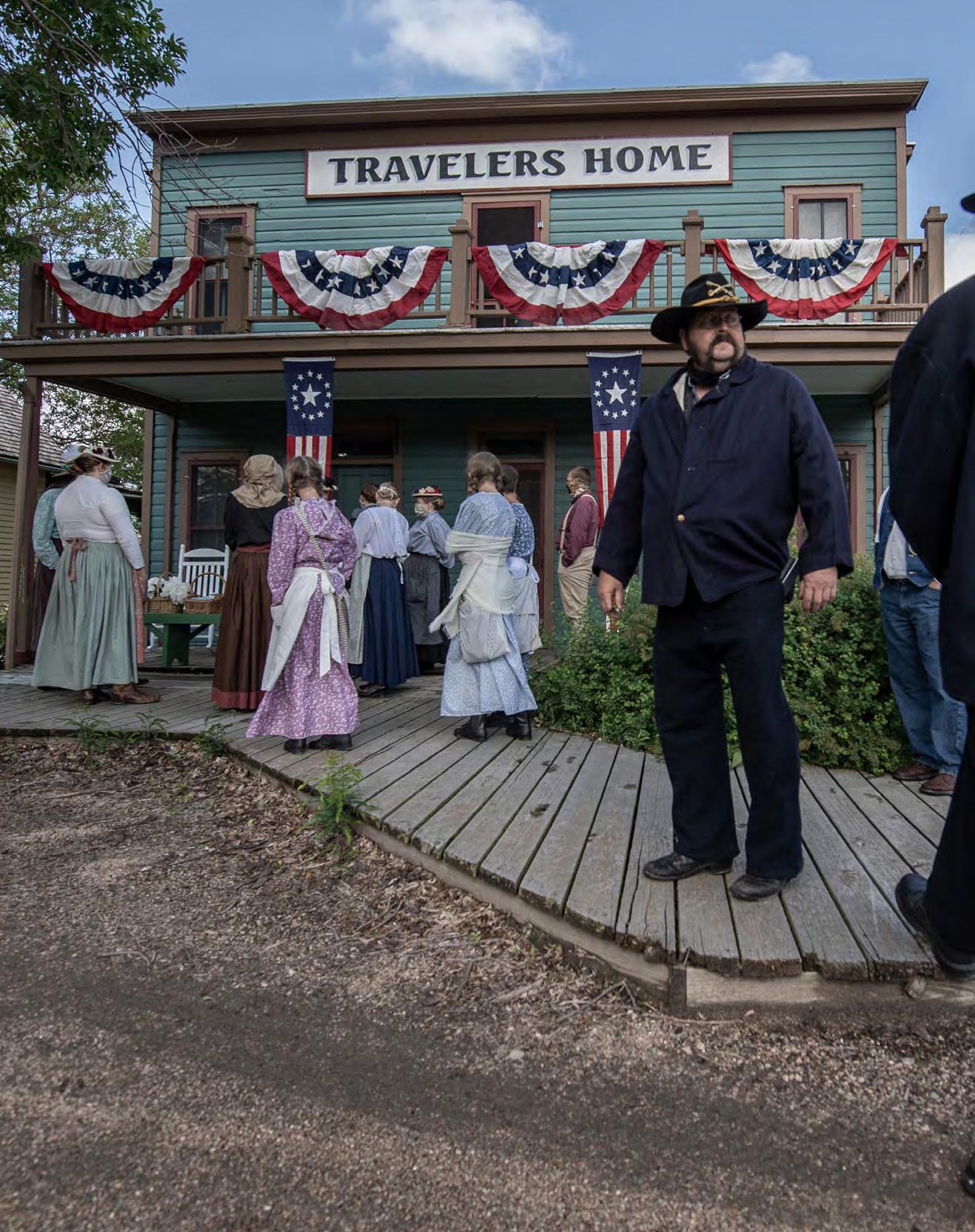

photograph by BECKY McCARVILLE
THE TEENAGERS weren’t thrilled with the rustic accommodations.
After writer, photographer and mom Becky McCarville and her sister Jennifer Miller finished cycling the 195-mile Cowboy Trail from Norfolk to Valentine (featured in this issue), their families and a friend’s family met for a weeklong stay at Merritt Trading Post on Merritt Reservoir 30 minutes southwest of Valentine.
The kids caught tadpoles, skipped rocks and launched paddle boards across the smooth water. The adults lounged in the shade of cottonwood trees. They hiked at Snake River Falls. They enjoyed the blast of icy water at Smith Falls.
One evening after dinner and before the nightly campfire, McCarville meandered to the water. The teenagers who’d reacted with skepticism at the beginning of the trip had relaxed into Nebraska’s natural world. McCarville didn’t have her camera, so she snapped this picture with her phone.
The water reflected the jewel-toned sky. The crescent moon ascended, and the girls happily daydreamed and played in the dusk.
IN EACH ISSUE, Last Look features a reader’s photograph of Nebraska – landscapes, architecture, attractions, events, people or wildlife.
Submit your best photographs for the chance to be published in Nebraska Life. Send digital images with detailed photo descriptions and your contact information to photos@nebraskalife.com or visit nebraskalife.com/contribute.
This photo was taken with an iPhone 12, equipped with 1.5mm Pro Max Lens, exposed at ISO 100, f/2.4 for 1/120 of a second.
